
- Jun 29, 2020

Travel Photography Gear: Nikon Z50 Review

It's taken me years (no kidding!) to find a good replacement for my trusty old Nikon D3. I ideally wanted something smaller and lighter, but with equally convincing image quality, plus an option to shoot great videos. Now that my travel photography gear collection has finally been expanded, read this Nikon Z50 review to find out why I believe it's the best camera for travel photography. Based on a few months of experience with the camera, testing different modes and pressing all the buttons, hopefully, I will be able to answer any questions you may have - sample images also included of course.
Disclaimer: As an Amazon affiliate, I earn from qualifying purchases
First of all , what sort of camera is the Nikon Z50?
The Z50 is a mirrorless camera, meaning it's compact in size and more lightweight than most DSLR brothers. For a travel camera particularly, the small size and weight is definitely something you will appreciate, having to carry it with you on tours and hikes. However much I love my Nikon D3 DSLR, after a while, it feels like I'm carrying a brick around...
At the same time, like the DSLR cameras, a mirrorless camera still comes with interchangeable lenses, so, if the kit lens is not enough, you can expand your collection and pick different ones depending on the nature of the shoot.
Nikon markets the Z50 as a 'camera for the rest of us'. I'm not sure what to make of the slogan really as it sounds kind of funny, but I guess the way you could interpret it is that it's suitable for both those with little photographic knowledge and those who are more advanced, just maybe not quite techy enough for the professional photographers. So, it's a great choice both if you are looking to upgrade from a phone or a compact camera or looking to downsize from a bulky DSLR. Depending on your skill set and desired level of involvement, you can use the fully automatic mode and let the camera make the decisions about the best settings, choose from a range of preset shooting modes (like sports, landscape, sunset etc.) or play around with all the settings in manual mode. I've done all three and got great results. The 'scene' modes are super handy when you don't want to dive into the individual settings.
The key camera stats:
(not going to get too technical here, just listing what I think is important from a user perspective and why it matters)
20.9MP APC-S sensor (not the biggest megapixel number I've seen, but unless you like to crop your photos a lot, I would actually prefer 20MP to 50MP, because image size! The more megapixels you have, the more space the photos will take up, both on the memory card and, afterwards, on your computer. With the amount of photos I transfer to my laptop after each trip, available disk space matters. For comparison, my Nikon D3 is 12 megapixel and I never felt that I needed more. It's more than enough for blog posts, social media as well as to print A4-size photo books.)
Body weight of 395 grams (nothing compared to 1.2 kilos for the Nikon D3! When I go hiking and carry it on my shoulder, I don't feel like I am lugging around a brick. I can hold it up in one hand with the arm stretched out to take a selfie without a problem.)
4K video at 30 fps and 1080 p HD video at 120 fps (personally, I am not bothered about 4K, HD is good enough for me, but, you know, it's there if you want to have the latest and greatest trends.)
Shoots photos at up to 11 fps (fast enough to get that perfect yawning cat shot - tested by me!)
Electronic viewfinder (while I don't always use it, it's an important option to have in case the conditions don't allow to effectively use the screen. Some manufacturers decided to lose this feature, which is a shame - Canon EOS M6 Mark II, a similar mirrorless camera, for example, only offers the viewfinder as an optional extra.)
3.2 inch rear screen is a touchscreen with live view and 'touch to focus' and 'touch to take a photo' features (I love being able to take a photo by touching - sometimes you just need that speedy reaction as opposed to starting to press buttons to move the focus point around. You literally just click on what you want sharp in the image and the camera focuses there and takes a photo.)
Rear screen can be tilted upwards and flipped to face the front (both of those I've been using a lot. The tilting comes super handy for shooting from awkward angles, for example, from the ground. If I didn't have the tilt option, I would have to lie down to be able to see what the camera captures - this way, I just crouch next to it and can see everything. The flipping makes selfies super easy.)

Face tracking/eye recognition (good for portraits, as it removes the need to move around the focus point manually.)
No in-body image stabilisation (but both kit lenses have image stabilisation.)
Wireless photo transfer to smartphone through the Nikon SnapBridge app (I find it a bit fiddly, but the cool thing is that you can choose whether you want to transfer the full-sized photo or a smaller version, so if storage space is an issue on your phone and you only want to post to Instagram, it's a nifty option to have)
Storage card type: SD/SDHC/SDXC; One card slot only. (Quite a common memory card format with lots of options available for all budgets. My Nikon D3 has two card slots, so it's possible to put .jpeg and .raw photos on different cards, but, to be honest, I haven't felt any inconvenience from only being able to use one memory card.)
One more thing I wanted to point out - compared to its direct competitors (Sony A6400, Fujifilm X-T30 and Canon EOS M6 Mark II), Nikon Z50 has the most protruding hand grip, which does wonders for comfort of holding. One of the issues of small mirrorless cameras for me is that they have shrunk down so much there's nothing to hold on to. That was a real downer when I was trying cameras out in the shops. I am happy to report that's not the case with the Z50 at all. It sits firmly in my hand and I don't worry about dropping it, so the ergonomics is definitely winning here.

So why did I buy the Nikon Z50 after years of indecision?
When looking for my next travel camera, I kept an open mind and researched and tried cameras from different brands and types (compact, bridge, mirrorless, DSLR). The competitors just weren't good enough in handling or image quality for me to forget about my Nikon lens collection, so in the end I resigned myself to having to carry a lot of weight around and was looking to buy another top of the range Nikon DSLR. But then I came across the Z50 and realised that in side-by-side image comparisons, in my opinion, it was coming out better than the flagship D4 and D850.
Ultimately, it was the image quality that did it for me, and, having now spent plenty of time taking photos with the Z50, I can confirm it hasn't disappointed. The images come out sharp and gorgeous.
Speaking of image quality, naturally, no camera review is complete without sample images and videos, so check them out. I used the 16-50mm kit lens throughout, so you can see what you get with the camera out of the box, without the need to invest in fancy professional lenses. Click on the photo to see a larger size.
Nikon Z50 sample images:

And here's a video filmed completely with the Nikon Z50:
What are the different kits and which one should I choose?
Naturally, you can get just the body of the camera, but there are several interesting bundles that you can buy that I recommend choosing from:
Nikon Z50 body + FTZ adapter
What on earth is an FTZ adapter you may ask and why would I need one? Well, the diameter of the lens mount on the Nikon Z-series cameras is different compared to the other Nikons (they call the other mount the F-mount). There aren't that many lenses on the market that were made for the Z-mount. The adapter allows you to be able to use the lenses made for the other Nikons and, as long as the lens has an integrated autofocus drive, the autofocus functionality will be fully supported.
If there is no drive in the lens, you will be able to focus manually with a focus box in the viewfinder turning green when the object behind it is sharp. It's not what you would want to use for photographing moving subjects, but is surprisingly easy to use for shooting landscapes and other stills.
This bundle is for you if you already have a Nikon DSLR with all the lenses you could need and that you definitely want to keep using. However, before you settle on this one, I would encourage you to check out bundle number 3 (body + FTZ adapter + 16-50mm lens) because the lens is pretty awesome and you will be saving weight and space not having to wear the adapter with it.
Nikon Z50 body + 16-50mm lens
In this kit, you get a great lens that, in my opinion, will cover most situations a travel photographer comes across. Sure, you wouldn't use it to take photos of birds far away in the sky, nor is it the right thing for something like whale and dolphin watching tours, where the subjects tend to be quite far away from the photographer, but mostly my travel shots consist of landscapes, architecture and some selfies, which this lens is ideal for.
All the reviews I read about this lens were glowing and, having tried it out myself now, I can confirm that they were not wrong - I love the quality of the photos! I've got other Nikon lenses, but to be honest, after playing around with a few for test purposes, I just left the kit lens on and that's what I use all the time.
The 16-50mm lens is tiny, which is ideal for something that you have to carry for a while. It also has built-in image stabilisation, to compensate for the lack of it in the camera body.
This bundle is for you if all you're after is a small-sized camera that takes great landscape to portrait photos and you're not really bothered about adding more lenses to your collection
Nikon Z50 body + FTZ adapter + 16-50mm lens
I've already described the adapter and the lens above, so I'll be short and sweet. This bundle is for you if a) you want to have a native kit lens, but also have a few F-mount lenses that you don't want to part with or b) you want to purchase several lenses and don't want to wait for Nikon to make more Z-mount ones (or you find the Z-mount lenses rather expensive, which they totally are)
Nikon Z50 body + 16-50mm lens + 50-250mm lens
If you like having a big zoom range, then this bundle might just be the thing for you. You get two kit lenses native to the camera, which together cover a very substantial zoom range. Both lenses also come with built-in image stabilisation. I haven't tested the 50-250mm lens myself, as I've decided that between the 16-50 lens and the other Nikon lenses I already own, I've got everything I need.
Sounds interesting? Then use the links below to see what sort of prices you would be looking at.
Check out available bundles and prices for Nikon Z50 on Amazon UK
Check out available bundles and prices for Nikon Z50 on Amazon US
So I've been waxing lyrical about the Nikon Z50 for what feels like an eternity, but do I have any gripes ? As a matter of fact I do have a few, no camera is perfect!
You have to flip a switch to change between photo and video mode as well as use different buttons to start a recording vs take a photo. My brain struggles to remember to do both. A bit disappointing thinking you're catching a cool moment on video to discover the switch was actually in photo mode...
A small gripe is that while the 'tap the screen to focus and take a photo' feature is great, I often end up taking random photos when trying to flip the screen out and back. You can disable that functionality if you find it annoying though.
If you want to use the selfie mode (i.e. flip the screen to face the same direction as the lens, so you can see yourself), you can't do that and use a tripod in the conventional way, because the screen flips down to where the tripod is and will be obstructed. Fortunately, there is an inexpensive solution for this problem - Smallrig made a special mounting plate that shifts the location of the tripod to the side.
Shop Smallrig mounting plate on Amazon US
Shop Smallrig mounting plate on Amazon UK
And that is all. I am in love with my Nikon Z50 and if this post has convinced you to get one too, I hope you love it just as much as I do!
#travelessentials #photography #shopping
- Product Review
Recent Posts
8 Must-Have Train Travel Accessories
Best Travel Games for 2 Adults
Best Travel Kettle - Researched, Tested, and Reviewed
Supporting the Nikon F-mount on the Internet since 1994... Added Canon EF mount support in 2017...
Site Navigation [Skip]
- Recommended DSLRs
- Recent Firmware Updates
- You Have A D1
- You Have A D1h
- You have a D1x
- You have a D2h or D2hs
- You have a D2x or D2xs
- You have a D3 or D3s
- You have a D3x
- You have a D4 or D4s
- You have a D5
- You have a D6
- You have a D100
- You have a D200
- You have a D300 or D300s
- You have a D500
- You have a D600 or D610
- You have a D700
- You Have a D750
- You have a D800, D800E, or D810
- You have a D850
- You have a D40, D40x, D50, D60, D3xxx, or D5xxx
- You have a D70, D70s, D80, or D90
- You Have a D7000
- You Have a D7100
- You Have a D7200
- You Have a D7500
- You have a Kodak SLR/n
- You have a Fujifilm S1 Pro, S2 Pro, S3 Pro, or S5 Pro
- If I Were To Switch...
- The Reasons To Buy A Camera
- Starting from Scratch
The DSLR Travel Kit
- Gear for Landscape Work
- How Big Can I Print?
- Shooting JPEG
- D800 Autofocus Problem
- Deja Vu All Over Again
- How Much Better is One Camera Over Another?
- What’s the Holy Grail Image Sensor?
- How Sensors Work
- Is ISO Fake?
- The Is ISO Fake Followup
- Cleaning Your Sensor
- Nikon DSLR Notes
- Does Travel Damage Cameras?
- Camera Repairs
- Capturing HDMI Video
- User Problems with DSLRs
- A Histogram Primer
- Moving from DX to FX
- Should I Buy Gray Market?
- About Shutter Activations
- Nikon D7500 Review
- Nikon D500 Review
- Nikon D600/D610 Review
- Nikon D780 Camera Review
- Nikon D850 Review
- Nikon Df Review
- Nikon D6 Camera Review
- full frame?
- Banks or U1/U2?
- Scene/Effects Modes?
- Nikon D3200 Review
- Nikon D3300 Review
- Nikon D3400 Review
- Nikon D5200 Review
- Nikon D5300 Review
- Nikon D5500 Review
- Nikon D7100 Review
- Nikon D7200 Review
- Nikon D300/D300s Review
- Nikon D750 Review
- Nikon D800/D800E Review
- Nikon D810 Review
- Nikon D4 Review
- Nikon D5 Review
- 1DX mark iii
- D7500 DX camera
- D780 FX camera
- D850 FX camera
- D6 FX camera
- Recent Canon vs Nikon
- DF FX camera
- D3200 DX camera
- D3300 DX camera
- D3400 DX camera
- D3500 DX camera
- D5200 DX camera
- D5300 DX camera
- D5500 DX camera
- D5600 DX camera
- D7000 DX camera
- D7100 DX camera
- D7200 DX camera
- D300s DX camera
- D500 DX camera
- D600 FX camera
- D610 FX camera
- D750 FX camera
- D800 & D800E FX camera
- D810 FX camera
- D4 FX camera
- D4s FX camera
- D5 FX camera
- Older Canon vs Nikon
- UC-E6 USB/AV Pinouts
- Round 10-pin Connector
- MC-DC1 Connector
- MC-DC2 Connector
- Nikon Hot Shoe Pinouts
- Nikon Camera Hacks
- Nikon DSLR Camera FAQ
- Rationalizing All Nikkors
- Rationalizing Zoom Lens Sets
- Choosing a Simple Prime Kit
- Which Nikkors Are Weather Resistant?
- Which Nikkors Have Fluorine Coating?
- Should I Buy a Gray Market Lens?
- What Matters Most?
- New or Old for the Exotic Telephotos?
- How Many Lenses Do You Need?
- Lens Filter Size
- My Five Favorite Nikkors
- Buy f/2.8 or f/4?
- Do We Still Need Fast Lenses?
- The Perfect Lens Set
- Lenses I've Fallen Out of Love With
- The 35, 50, 70 Game
- Lens Zoom Factors
- What is a Wide Angle Lens?
- Convenience Zooms
- Going Long with Telephoto Lenses
- Exotics Telephotos Other Than The Primary Brands
- Missing Nikkors (Early 2021)
- Results of My Nikkor Lens Surveys
- The New Nikkor Wish List
- Tracking Down Autofocus Issues (Part 1)
- Tracking Down Autofocus Issues (Part 2)
- All About Nikon VR
- More About VR/IS
- Hype About Hyperfocal Focus
- How Do You Test a Lens?
- Making Sense of Nikon Lens Abbreviations
- Nikon Lens Contacts
- Nikon Lens Communications
- Nikon DX versus Nikon FX
- Understanding the AF-P Lenses
- Nikon Lens/Body Compatibility
- What is Sharpness?
- What is Micro Contrast?
- What is Tack Sharp?
- Macro Lens Working Distances
- About Lens Reviews
- 10-20mm f/4.5-5.6
- Nikkor 16-80mm f/2.8-4E DX
- Nikon 16-85mm f/3.5-5.6G Lens Review
- Nikkor 17-55mm f/2.8G DX
- Nikkor 18-70mm f/3.5-4.5G DX
- Nikkor 18-140mm f/3.5-5.6 DX
- Nikon 35mm f/1.8G DX
- Nikon 40mm f/2.8 Micro-Nikkor DX Lens Review
- Nikon 70-300mm f/4.5-6.3 AF-P VR DX
- Nikkor 85mm f/3.5G Micro-Nikkor
- 19mm f/4 PC-E
- Nikon 20mm f/1.8G
- Nikon 24mm f/1.8G
- Nikon 28mm f/1.8G
- Nikon 28mm f/1.4E
- Nikkor 35mm f/1.8G
- Nikkor 50mm f/1.4G
- Nikkor 50mm f/1.8G
- Nikkor 58mm f/1.4G
- Nikkor 85mm f/1.8G
- Nikon 105mm f/1.4E AF-S ED
- Nikon 105mm f/2.8G Micro-Nikkor Lens Review
- Nikkor 200mm f/2G
- Nikkor 300mm f/4E
- Nikkor 400mm f/2.8G
- Nikon 500mm f/4G ED VR AF-S Lens Review
- 500mm f/5.6E PF
- Nikon 8-15mm f/3.5-4.5
- Nikkor 14-24mm f/2.8G
- Nikkor 16-35mm f/4G
- Nikkor 24-70mm f/2.8E
- Nikon 70-200mm f/2.8E FL ED VR Lens Review
- Nikkor 70-200mm f/4G
- Nikon 70-300mm f/4.5-5.6 AF-P VR
- Nikkor 80-400mm f/4.5-5.6G
- 180-400mm f/4E
- Nikkor 200-400mm f/4G
- Nikkor 200-500mm f/5.6E
- Which Long Telephoto Zoom?
- Sigma 14mm f/1.8 ART
- Sigma 20mm f/1.4 ART
- Sigma 18-35mm f/1.8 Art Lens Review
- Sigma 50-100mm f/1.8 Review
- Sigma 85mm f/1.4 HSM DG Art Lens Review
- Sigma 135mm f/1.8 DG HSM Art Lens Review
- Tamron 35mm f/1.8 VC
- The Yongnuo Trio
- Two 15mm Manual Focus Choices
- Recommended DX Lenses
- Recommended FX Lenses
- 18-55mm VRII
- 18-55mm AF-P VR
- 18-55mm AF-P
- 18-300mm II
- 55-200mm VR *
- 55-200mm VR
- 70-300mm VR
- 20mm f/1.8G
- 24mm f/1.8G
- 28mm f/1.4E
- 50mm f/1.4D
- 50mm f/1.4G
- 50mm f/1.8D
- 50mm f/1.8G
- 58mm f/1.4G
- 60mm f/2.8 macro
- 85mm f/1.4G
- 85mm f/1.8G
- 85mm f/2.8 PC-E
- 105mm f/1.4E
- 105mm f/2 DC
- 105mm f/2.8 macro
- 135mm f/2.8 DC
- 180mm f/2.8
- 200mm f/4 macro
- 300mm f/2.8 II
- 400mm f/2.8G
- 400mm f/2.8E
- 800mm f/5.6
- 8-15mm f/3.5-4.5E
- 14-24mm f/2.8
- 16-35mm f/4
- 17-35mm f/2.8
- 18-35mm f/3.5-4.5 II
- 24-70mm f/2.8G
- 24-70mm f/2.8E VR
- 24-85mm f/3.5-4.5
- 24-85mm f/2.8-4
- Nikkor 24-120mm f/4G ED VR
- Nikkor 28-300mm f/3.5-5.6G ED VR AF-S
- 70-200mm f/2.8
- 70-200mm f/2.8E FL
- 70-200mm f/4
- 70-300mm AF-P VR
- 80-400mm AF-S
- 200-400mm II
- 200-500mm f/5.6
- How does a teleconverter change lens characteristics?
- Can I use a teleconverter on my 16-35mm f/4?
- Can I use a Sigma teleconverter on a Nikon lens?
- Why can't I use a TC-17E or TC-20E on an f/4 lens?
- Why do you seem to be so negative about teleconverters?
- How do I stack teleconverters?
- Nikon Lens FAQ
- 35mm f/2.8 EF-S Macro
- 50mm f/2.8L TS-E Macro
- 85mm f/1.4L IS
- 90mm f/2.8L TS-E Macro
- 135mm f/4L TS-E Macro
- 400mm f/2.8L IS III USM
- 600mm f/4L IS III USM
- 16-35mm f/2.8L III USM
- 24-105mm f/4L IS II USM 2
- 70-200mm f/2.8 IS III USM
- 70-200mm f/4 IS II USM
- 70-300mm f/4-5.6 IS II USM
- 8-16mm f/4.5-5.6
- 10-20mm f/3.5
- 10-20mm f/4-5.6
- 17-50mm f/2.8
- 17-70mm f/2.8-4
- 18-35mm f/1.8
- 18-200mm f/3.5-6.3
- 18-250mm f/3.5-6.3
- 18-300mm f/3.5-6.3
- 50-100mm f/1.8
- 50-150mm f/2.8
- 8mm f/3.5 EX DG Circular Fisheye
- 14mm f/1.8 DG HSM Art
- 15mm f/2.8 EX DG Fisheye
- 20mm f/1.8 EX DG ASP RF
- 20mm f/1.4 DG HSM
- 24mm f/1.4 DG HSM
- 24mm f/1.8 EX DG ASP Macro
- 28mm f/1.4 DG HSM Art
- 28mm f/1.8 EX DG ASP Macro
- 35mm f/1.4 DG HSM A
- 40mm f/1.4 DG HSM Art
- 50mm f/1.4 EX DG HSM
- 50mm f/1.4 EX DG HSM (2014)
- 50mm f/2.8 EX DG Macro
- 70mm f/2.8 EX DG Macro
- 70mm f/2.8 DG Macro Art
- 85mm f/1.4 EX DG HSM
- 85mm f/1.4 EX DG HSM Art
- 105mm f/1.4 DG HSM Art
- 105mm f/2.8 EX DG OS HSM Macro
- 135mm f/1.8 DG HSM Art 2
- 150mm f/2.8 EX DG OS HSM APO Macro
- 180mm f/2.8 APO EX DG OS HSM Macro
- 300mm f/2.8 EX APO DG HSM
- 500mm f/4 DG OS HSM Sports
- 500mm f/4.5 EX DG AO HSM
- 800mm f/5.6 EX APO DG HSM
- 12-24mm f/4.5-5.6 DG HSM II
- 12-24mm f/4 DG HSM Art
- 14-24mm f/2.8 Art
- 24-35mm f/2 DG HSM Art
- 24-70mm f/2.8 IF EX DG HSM
- 24-70mm f/2.8 DG OS HSM Art
- 24-105mm f/4 DG OS HSM
- 50-500mm f/4.5-6.3 APO DG OS HSM
- 60-600mm f/5-6.3 S
- 70-200mm f/2.8 APO EX DG OS HSM
- 70-200mm f/2.8 DG OS HSM Sports
- 70-300mm f/4-5.6 DG Macro
- 70-300mm f/4-5.6 APO DG Macro
- 70-300mm f/4-5.6 DG OS
- 100-400mm f/5-6.3 DG OS HSM Contemporary
- 120-300mm f/2.8 DG OS HSM S
- 120-400mm f/4.5-5.6 DG APO OS HSM
- 150-500mm f/5-6.3 APO DG OS HSM
- 150-600mm f/5-6.3 S
- 150-600mm f/5-6.3 C
- 200-500mm f/2.8 APO EX DG
- 300-800mm f/5.6 EX DG APO HSM
- Sigma Lens Firmware Versions
- 10-24mm f/3.5-4.5
- 10-24mm f/3.5-4.5 VC II
- 16-300mm f/3.5-6.3
- Tamron 17-50mm
- 18-270mm f/3.5-6.3
- 18-400mm f/3.5-5.6
- 15-30mm f/2.8
- 15-30mm f/2.8 G2
- 17-35mm f/2.8-4
- 24-70mm f/2.8
- 24-70mm f/2.8 G2
- 28-75mm f/2.8
- 28-300mm f/3.5-6.3
- 35-150mm f/2.8-4
- 70-200mm f/2.8 VC
- 70-210mm f/4 VC
- 70-300mm f/4-5.6 VC
- 70-300mm f/4-5.6 VC II
- 70-300mm f/4-5.6
- 90mm f/2.8 *
- 90mm f/2.8 VC *
- 90mm f/2.8 VC II
- 100-400mm f/4.5-6.3
- 150-600mm f/5-6.3
- 150-600mm f/5-6.3 G2
- 180mm f/3.5
- 200-500mm f/5-6.3
- Tamron VIP Program
- AT-X 10-17mm f/3.5-4.5 AF DX Fish-Eye
- AT-X 11-16mm f/2.8 Pro DX
- ATX-i 11-16mm f/2.8 CF
- AT-X 11-20mm f/2.8 Pro DX
- ATX-i 11-20mm f/2.8 CF
- AT-X 12-24mm f/4 Pro DX II
- AT-X 12-24mm f/4 Pro DX
- AT-X 12-28mm f/4 Pro DX
- AT-X 14-20mm f/2 Pro DX
- AT-X 16-28mm f/2.8 Pro FX
- 16-28mm f/2.8 Opera
- AT-X 16-50mm f/2.8 Pro DX
- AT-X 16.5-135mm f/3.5-5.6 DX
- Firin 17-35mm f/4 Pro FX
- Tokina 17-35mm f/4 atx-i
- AT-X 24-70mm f/2.8 Pro FX
- AT-X 35mm f/2.8 Pro DX Macro
- 50mm f/1.4 Opera
- AT-X 80-400mm f/4.5-5.6 AF D
- AT-X 100mm f/2.8 Pro D Macro
- ATX-i 100mm f/2.8 Macro
- Kenko 400mm f/8 N II
- 20mm f/3.5 Skopar SLII
- 28mm f/2.8 Skopar SL II S
- 28mm f/2.8 Skopar SL II 2
- 40mm f/2 Skopar SL-II
- 40mm f/2 Skopar SL-II S
- 58mm f/1.4 Nokton SL-II
- 58mm f/1.4 Nokton SL-II S
- 90mm f/2.8 APO-Skopar SL-IIs
- 90mm f/3.5 Lanthar SL-II
- 15mm f/2.8 Distagon T
- 15mm f/2.8 Milvus
- 18mm f/2.8 Milvus
- 18mm f/3.5 Distagon T
- 21mm f/2.8 Milvus Distagon T
- 21mm f/2.8 Distagon T
- 25mm f/1.4 Milvus Distagon
- 25mm f/2 Distagon T
- 25mm f/2.8 Distagon T
- 28mm f/1.4 Otus
- 28mm f/2 Distagon T
- 35mm f/1.4 Distagon T
- 35mm f/1.4 Milvus ZF.2
- 35mm f/2 Milvus Distagon
- 35mm f/2 Distagon T
- 50mm f/1.4 Planar T
- 50mm f/1.4 Milvus Distagon
- 55mm f/1.4 Otus
- 50mm f/2 Makro-Planar T
- 50mm f/2 Milvus Makro-Planar
- 85mm f/1.4 Planar T
- 85mm f/1.4 Milvus Planar
- 85mm f/1.4 Otus
- 100mm f/1.4 Otus
- 100mm f/2 Makro-Planar T
- 100mm f/2 Milvus Makro-Planar T
- 135mm f/2 APO Sonnar T
- 135mm f/2 Milvus
- Irix Lenses
- Kerlee 35mm f/1.2
- Lensbaby 56mm f/1.6
- Meike 85mm f/2.8 Macro
- Meike 85mm f/1.8
- Mitakon 20mm f/2 (EF, F, A, K mounts)
- Mitakon 35mm f/2
- Mitakon Speedmaster 85mm f/1.2
- Mitakon Speedmaster 135mm f/1.4
- Mitakon 85mm f/2
- 85mm f/2.8 Macro
- 135mm f/2.5 MF
- Samyang Xeen 85mm t/1.5
- Schneider Lenses
- Yongnuo Lenses
- Zenitar 16mm f/2.8 2
- ProGrade 64GB SD
- Vello D850 Grip
- The State of Nikon Flash
- Flash Reviews
- Current Flash Database
- Older Flash Database
- FAQ for Nikon Flash
- Brackets/Plates
- Cage Your DSLR
- EN-EL15 Batteries
- The Card Situation
- XQD and CFe Cards
- Replacement Parts
- Filters 101
- Nikon Remotes
- In Thom's Bag
- The 7Kg Wildlife Bag
- Photography Software FAQ
- Photo Software Thom Uses
- File Hierarchy
- B&H Accessory Lists
- How Will my Tripod Break?
- What About Tripod Specs?
- What Causes Card Errors?
- Nikon D5 Guide
- Nikon D6 Guide
- Nikon D500 Guide
- Nikon D600/D610 Guide
- Nikon D750 Guide
- Nikon D780 Guide
- Nikon D810/D810A Guide
- Nikon D850 Guide
- Nikon D7200 Guide
- Nikon D7500 Guide
- Nikon D7000 Guide
- Nikon D7100 Guide
- Nikon D800/D800E Guide
- Nikon D3/D3s/D3x Guide
- Nikon D300/D300s Guide
- Nikon D700 Complete Guide
- Are your Complete Guides just rewrites of the manual?
- Why can't I find your works in bookstores?
- Why can't I find your works in the Kindle (Nook) store?
- Are all of your older Complete Guides still available?
- Do you ever update your works?
- What do your books work on?
- Can I copy the eBook file to my other computers?
- Why were some eBooks supplied on a CD?
- What Happens if I Lose my Downloaded File?
- Code of Ethics
- Privacy Info
- Support this Site
- Search this Site
I recently wrote an article on sansmirror.com listing several seriously compact, simple, kits of camera and lenses that minimized size and weight for all around travel photography. Today I’m going to tackle the same subject from a Nikon DSLR standpoint.
In my previous article I listed six key factors I was trying to balance in creating a minimal travel kit (dealing with light, perspective, focal variety, position, vulnerability, and fatigue). Generally the last two of those factors are the things that cause DSLR users to start leaving gear back in their hotel room as they travel with their existing kit.
I won’t quite hit the same size/weight goals with Nikon DSLRs as I did with mirrorless. There are two reasons for that: (1) I’d assume that the reason to take a DSLR over something else is that you’re pretty darned critical about image quality; and (2) Despite some downsizing recently, Nikon hasn’t exactly rushed to make smaller, lighter DSLR gear.
For me, my DSLR travel kit recently has been the D7500, the 16-80mm f/2.8-4E lens, and the 70-300mm f/4-5.6 AF-P VR (FX) lens. This actually gives me more reach than most of the mirrorless kits I described, but it comes with a size/weight penalty: we’re easily double the weight at 2kg (4.4 pounds).
Which brings me to an aside. The way I see it, you have four basic options for travel photography these days, in order of increasing image quality and flexibility: 1. Your smartphone. 2. An all-in-one compact, such as the latest Sony RX-10 for a true all-in-one experience, or something smaller and simpler such as the Panasonic LX-100 Mark II for a more basic approach. The problem at this level is that you’re compromising low light performance, and travel photography tends to have a lot of indoor and night opportunities in it. 3. The mirrorless kits I described in my previous article. 4. Picking a DSLR, the point of this article. I’m trying to find a balance between all the variables. There’s no one perfect answer, and your tolerance for some of the variables may be different than mine. But I’m still pretty certain that you need to think clearly about this and make sure that your pick of 1, 2, 3, or 4 is based upon a complete and rational analysis, not a knee-jerk reaction to what you’ve already got or what the latest and most hyped product is.
We’re at a bit over US$2000 for the D7500 kit I describe. A number of people wrote in response to my sansmirror.com article that DSLRs would be less expensive. Yes, that’s true if you already have some of the components, but to get better pricing than the mirrorless kits I described, you may have to start sacrificing quality (e.g. D5600 for D7500, 70-300mm DX for 70-300mm FX, etc.). At what point then, does DSLR become a clear step upward from mirrorless if you’re making quality sacrifices?
Personally, I also travel with the Tokina 11-16mm when the D7500 is my travel camera, so I’m starting to pile up weight and cost compared to the simple kits I described in my mirrorless article.
By way of exact comparison, below on the right you’ll find the exact mirrorless kit I used on my recent travels compared to the equivalent I’d have used with a Nikon DSLR on the left (this is a single shot of both items side by side on my light bench, so the size differential you see is accurate; the shot uses the D7200 instead of the D7500, but those cameras are about the same size).
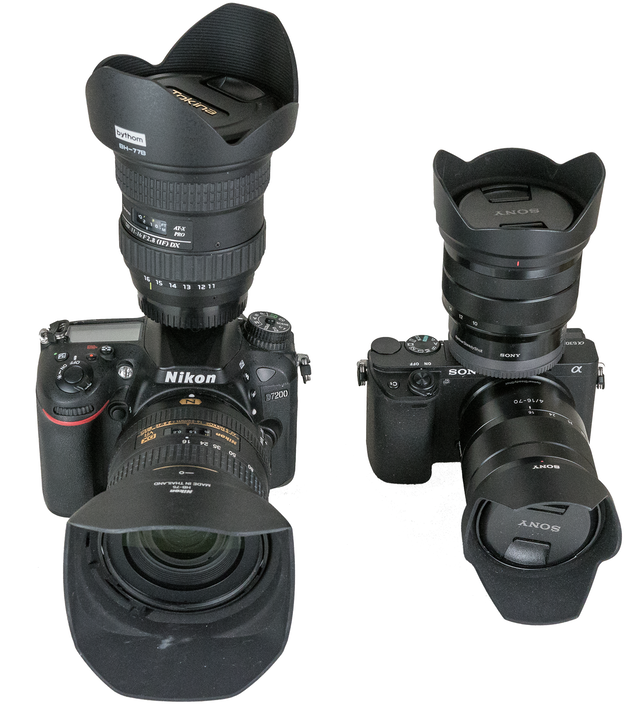
My contention with travel kits is that they need to be compact and versatile, and that you need to be willing to carry everything with you at all times , lest you miss photographic opportunities. As it is, the Nikon DSLR kit just illustrated maxes out at 120mm equivalent, the Sony mirrorless kit on the right maxes out 100mm equivalent, so neither has much telephoto oomph. On the other hand, they’re both capable of shooting very wide (16.5 mm equivalent for the Nikon, 15mm equivalent for the Sony) and in close, tight spaces, which happens a lot when you’re traveling, especially inside museums and other tourists spots. That’s why the above two choices are my current basic go-to, bare-bones travel kits.
So yes, you can build a DSLR travel kit. I’ve given my basic suggestions above (D7500, 16-80mm, 70-300mm; or D7500, 11-16mm, 16-80mm; depending upon whether you favor telephoto or wide angle). If you want to substitute a D500 for the D7500, I wouldn’t stop you, but you’re adding cost and weight. I would probably try to dissuade you from picking a D5600, as you don’t save any tangible size/weight and the only real gain you receive is a tilting LCD and fewer dollars spent, but at the expense of a bunch of real losses in focus system, features, and even in image quality (unless all you shoot is JPEG).
But wait, you say, what about FX?
Anyone who asks that question is basically saying “I don’t want to compromise.” Yes, you can build an FX DSLR travel kit, but I think you’re starting to increase cost, vulnerability, and fatigue. You’re certainly not in the target that my original article attempted to address. Moreover, you may start compromising lens very quickly.
For example, I’d suggest that a D610, D750, or D780 with the 24-85mm f/3.5-4.5 would be a good base to start from. You can add the 18-35mm f/3.5-4.5 for wide, or the 70-300mm f/4-5.6 for telephoto. But these lenses are aperture compromised at extremes, so you’re giving back some if not all of what you gained by picking FX over DX. These are decent lenses, but not top quality lenses: center sharpness is fine, but all three tend to perform less well than someone arguing for “I don’t want to compromise” would want when used wide open or when you need corner performance. You’re also not getting any additional subject isolation from the larger sensor.
So why was it you wanted FX in the first place? I’m just not convinced that Nikon FX (or Canon full frame) is the right choice to center a travel package around.
Okay, there’s one travel possibility with FX I didn’t mention: lose the zooms. A D750 with the 20mm/24mm, 35mm, 50mm, and 85mm f/1.8 lenses is a bit of a powerhouse in modest proportions. The lenses are all light and relatively small, and they perform quite well. The combo of the D750 sensor and the f/1.8 apertures gives you deep flexibility in low light, plus you’ve re-gained the ability to use subject isolation with the fast apertures.
But the cost is juggling. You’re juggling four lenses. That almost certainly means that some (or all) are in a pack or bag you’re carrying. And you’ve just compromised your shooting spontaneity. Heck, you may have lost it entirely. Moreover, you’re now juggling a bag. You’re either keeping that bag handy and partly in your way all the time, or you’re setting it down to shoot (remember the vulnerability factor I mentioned in the original article; we’re trying to avoid that).
So maybe two or three well chosen primes. Now we’re starting to compromise flexibility. I’m okay with that if you are, but be careful. One of the things about impromptu travel photography is that you’re going to encounter situations that are spontaneous and that you’re not able to micromanage (e.g. quickly moving into a shooting position because you’ve only got a 24mm lens on the camera).
Yes, I know HCB (that would be Henri Cartier-Bresson) managed his street photography with only one lens, but he also spent weeks getting one great photo. The premise of the original travel article I wrote was that you had two weeks and were moving from place to place, and you want to come home with a good variety of images that reflect what you saw in your travels.
We all choose photographic gear to balance our needs for any given situation we intend to shoot in. What I’ve tried to give you in these two articles is some advice on how I think about achieving a reasonable balance. But don’t just willy-nilly take my advice. Think about your goals, your needs, your impediments, plus what you want to accomplish, and then figure out what gear set best helps you achieve that.
I hope I’ve given you something to think about and focus those thoughts with these articles.
New: 7 Best cameras for travel
Updated March 2024
Travel can expose you to once-in-a-lifetime sights and experiences, and a good camera can be the perfect way to preserve those memories. We've looked at a range of models that offer great image quality, good autofocus and excellent video, so that you can capture whatever you encounter on your travels. We've also tried to select relatively small cameras so they don't interfere with your trip.
Our selections include relatively compact cameras with fixed lenses, perfect for just documenting what you saw on your trip; they also include Micro Four Thirds and APS-C models that allow smaller camera/lens combinations, if you're looking to travel light. Full-frame cameras open up the potential for even better image quality but the lenses can get pretty big, so it's worth checking how big the total package is, before committing to a large-sensor model.
Our recommendations
Best pocketable travel camera: ricoh gr iii, the classic choice: fujifilm x100vi, truly compact mirrorless: om system om-5, all-round compact capability: sony a6700, the great travel kit: fujifilm x-s20 with 18-55mm f2.8-4.0 ois, the stylish travel companion: nikon zf, portable full-frame: sony a7cr.
24MP APS-C sensor | 28mm equiv. F2.8 lens | Wi-Fi + Bluetooth
What we like:
- Excellent image quality
- Good controls and ergonomics
- Truly pocketable
What we don't:
- Short battery life
- No built-in flash
- Sluggish AF in low light
The Ricoh GR III is the latest in a series of classic compact cameras with a large APS-C sensor and a 28mm equivalent lens. It's not the most flexible camera but it's one of the most pocketable and has built up a dedicated following of photographers who find it a joy to shoot with.
Our only concern, in terms of using the GR III for travel are that some users have found dust can get into the lens. So it's worth trying to find some sort of protective bag to keep it in.
There's also the GR IIIx , a variant with a longer, 40mm equivalent lens on it. This may be a little tight for documenting your travels, but it's historically a popular focal length.
Read our Ricoh GR III review
See the Ricoh GR III studio scene

40MP BSI CMOS APS-C X-Trans sensor | 35mm equiv F2 lens | Hybrid viewfinder
- Excellent build quality
- Subject-detection autofocus
- Now with in-body image stabilization
- Lens not especially fast to focus
- Hard to find in stock
Like the Fujifilm X100V before it, the Fujifilm X100VI is a classically styled fixed lens camera with a 35mm equivalent F2 lens. But being in active production following its 2024 launch, the X100VI is somewhat easier to buy than its constantly out-of-stock forebear.
Updated with in-body image stabilization rated at up to 6EV of correction and a 40MP BSI CMOS APS-C X-Trans sensor, the X100VI is a significant upgrade over its predecessor despite looking virtually identical. And those improvements in part explain the X100VI's $200 increase in list price to $1,600.
Like its older brother, the X100VI isn't the smallest or most inconspicuous camera, but its fixed focal length means you develop an 'eye' for the photos it'll take, essentially making it a better quality, more engaging alternative to snapping away with your phone.
The addition of subject-detection autofocus has given the X100VI the ability to recognize animals, birds, automobiles, motorcycles and bikes, airplanes, and trains though human (face/eye) detection is a separate mode. However, the lens the X100VI shares with the X100V is not the fastest to autofocus, prioritizing sharpness over speed.
The X100VI brings a level of polish you would expect from a sixth iteration of a camera. Fujifilm has done a great job keeping the X100-series up to date without messing with the formula that's made it so popular. No surprise, this is the best X100 yet.
Unfortunately, despite ramped-up production, demand for the X100VI seems to have outstripped supply with the camera already on backorder at virtually all dealers. With any luck, however, its release will depress the over-inflated sale price of previous generation X100V cameras, which are still quite capable if you can find them for prices befitting used gear.
Read our Fujifilm X100VI review

20MP Four Thirds CMOS sensor | 4K/30p video | In-body stabilization rated to 6.5EV (7.5 with some lenses)
- Attractive JPEG output
- Selection of clever photo features
- Excellent image stabilization
- IP53 rating supports claims of weather sealing
- AF tracking is disappointing
- Image quality is behind larger sensor cameras
The OM System OM-5 is a compact interchangeable lens camera with a 20MP Four Thirds sensor in a compact body with plenty of external control.
That relatively small sensor means it can remain fairly small, even with a lens attached, and the Micro Four Thirds lens system provides extensive options in that regard, from compact zooms to small prime lenses.
Read our OM System OM-5 review
See the OM System OM-5 studio scene

26MP BSI CMOS sensor | 4K/60p video capture | Fully articulating screen
- Front and rear command dials
- Excellent AF in stills and video
- 4K/120p capture (with crop)
- No AF joystick
- JPEG sharpening can be aggressive
The Sony a6700 is built around a 26MP APS-C-sized sensor. Its excellent autofocus performance means it excels at both stills and video capture. There's a good choice of relatively compact lenses available, too. We'd suggest avoiding the really small 16-50mm F3.5-5.6 though: it's not the lens to get the most out of this camera.
Fast, dependable autofocus with a selection of subject recognition modes means the a6700 will help maximize your chances of capturing the unexpected moments on a trip.
Read our full Sony a6700 review
See the Sony a6700 studio scene

26MP X-Trans APS-C sensor | Up to 6.2K/30P 10-bit video | In-body image stablization
- Excellent still and video quality
- Long battery life
- Comfortable, simple ergonomics
- AF tracking still lags behind peers
- Small electronic viewfinder
- Micro HDMI instead of full-size
Fujifilm's X-S20 is also worth considering. Like the a6700, it's built around a 26MP BSI CMOS sensor and is strong at both stills and video. Its autofocus isn't as simple and powerful as the Sony's, but its JPEG color modes produce really attractive results, and there's a wide choice of lenses including compact prime and the well-priced, supremely useful 18-55mm F2.8-4.0 OIS, which is a great travel option.
Read our Fujifilm X-S20 initial review
See the Fujifilm X-S20 studio scene

24MP full-frame BSI CMOS sensor | Full-width 4K/30 video, cropped 4K/60 | Stabilization rated to 8EV
- Distinctive design with direct controls
- Effective subject recognition
- Strong stills and video features
- Weight and minimal grip can become uncomfortable
- Slow MicroSD second slot
- Few custom buttons
The Nikon Zf is a classically styled full-frame camera built around a 24MP full-frame sensor that's used by many of its peers. The angular 80s-style body isn't the most comfortable to hold in your hand for extended periods, but the lack of stick-out grip makes it smaller than many of its rivals, making it a tempting travel companion.
At least in its all-black form, there's a chance of it being mistaken for a film camera, which may help avoid the wrong kind of attention, when you're out and about in an unfamiliar setting.
Read our initial review of the Nikon Zf

61MP BSI CMOS sensor | 4K/60p video with 10-bit color | Dedicated ‘AI’ processor for AF system
- Big camera features in a small body
- Outstanding AF performance
- Auto Framing video mode
- Small, low-res viewfinder
- No joystick control
- No fully mechanical shutter
The Sony a7CR is a relatively compact full-frame camera with an image-stabilized 61MP CMOS sensor. You sacrifice the convenience of an AF joystick and get a pretty small and basic viewfinder to keep the camera's size down, but there's little else that delivers this much image quality in such a compact package.
You'll need to pick your lenses carefully to keep the camera portable but the a7CR's autofocus means it can respond rapidly to just about anything you encounter on your travels.
Read our Sony a7CR initial review

Why you should trust us
This buying guide is based on cameras used and tested by DPReview's editorial team. We don't select a camera until we've used it enough to be confident in recommending it, usually after our extensive review process. The selections are purely a reflection of which cameras we believe to be best: there are no financial incentives for us to select one model or brand over another.
Gear in this story

- Discuss in the forums
- See full product details
- Read our review
- Watch the video review
- View sample images

When you use DPReview links to buy products, the site may earn a commission.

You may also like
More about gear in this article.

We've been pretty busy testing cameras over the past few weeks. Here's a quick roundup of video test reels we've shot recently for those who may have missed them.

Updates from Fujifilm, Nikon, Sony and Panasonic help expand their cameras' capabilities.

The arrival of the Fujifilm X100VI reignites the debate on what it means for its most direct competitor, the 40mm equiv. Ricoh GR IIIx. Which is the better photographer's compact? We think there's an obvious answer, but you'll have to find out for yourself which it is.

Panasonic's Lumix DC-S5 II and Nikon's Zf are two very different answers to the question: "what's the best enthusiast full-frame camera for $2000." They share more than you might expect, but with different areas of appeal. Discover the difference.

The Nikon Zf is a 24MP full-frame mirrorless camera with classic looks that brings significant improvements to Nikon's mid-price cameras. We just shot a sample reel to get a better feel for its video features and have added our impressions to the review.
Latest sample galleries

Latest in-depth reviews

The Pentax 17 is the first Pentax film camera in two decades. It's built around a half-frame film format and includes design cues inspired by previous Pentax models. Is the experience worth the price of admission? We tested it to find out.

Nikon has announced the Z6III, its third-generation mid-range full-frame mirrorless camera. A new 24MP sensor brings speed to every part of the camera, and all the key features have been upgraded.

The newest version of Panasonic's Micro Four Thirds video-oriented flagship camera has arrived, and it includes features like internal ProRes RAW recording, 32-bit Float audio capture, phase-detect autofocus, and compatibility with Panasonic's Real-Time LUT system and Lumix Lab app.

The Lumix S9 is Panasonic's newest full-frame mirrorless camera. It allows users to create their own custom looks for out-of-camera colors and is the first full-frame Lumix camera aimed squarely at social media content creators.

The Sony a9 III is the world's first full-frame mirrorless camera to feature a global electronic shutter with simultaneous readout. After extensive testing of this 120 fps sports camera, to see what you gain (and, perhaps, lose).
Latest buying guides

What’s the best camera for around $2000? This price point gives you access to some of the most all-round capable cameras available. Excellent image quality, powerful autofocus and great looking video are the least you can expect. We've picked the models that really stand out.

What's the best camera for travel? Good travel cameras should be small, versatile, and offer good image quality. In this buying guide we've rounded-up several great cameras for travel and recommended the best.

If you want a compact camera that produces great quality photos without the hassle of changing lenses, there are plenty of choices available for every budget. Read on to find out which portable enthusiast compacts are our favorites.

'What's the best mirrorless camera?' We're glad you asked.

Above $2500 cameras tend to become increasingly specialized, making it difficult to select a 'best' option. We case our eye over the options costing more than $2500 but less than $4000, to find the best all-rounder.
- Gear Patrol
- Work for us
- Advertise with us
- Feedback / Contact us
- Camera reviews
- Lens reviews
- Printer reviews
- Buying guides
- Sample images
- Editorial enquiries
- Camera search
- Camera comparison
- Lens search
- Product timeline
- Browse all products
- Community Guidelines
- My Settings
- My GearList
Covering the Nikon Z Mount Cameras and Lenses
Site Navigation [Skip]
- Z System User
- 2023 News/Views
- 2022 News/Views
- 2021 News/Views
- 2020 News/Views
- Concise Z Reviews
- Nikon Z5 Review
- Nikon Z6 Review
- Nikon Z6 II Review
- Nikon Z7 Review
- NIkon Z7 II Review
- Nikon Z8 Review
- Nikon Z9 Review
- Nikon Z30 Review
- Nikon Z50 Review
- Nikon Zfc Review
- Nikon Zf Review
- Nikon Z5 Specs
- Nikon Z6 Specs
- Nikon Z6 II Specs
- Nikon Z6 III Specs
- Nikon Z7 Specs
- Nikon Z7 II Specs
- Nikon Z8 Specs
- Nikon Z9 Specs
- Nikon Zf Specs
- Nikon Z30 Specs
- Nikon Z50 Specs
- Nikon Zfc Specs
- Where are Z's Made?
- The Z9 in Africa Blog
- A Nikon Z Mirrorless Safari
- Smaller and Lighter, or Not?
- Comparing Nikon Z to Sony A
- Recommended Z50 Kit
- Thom's Zfc Quick Advice
- The Z System Wish List
- Using a Z as a Webcam
- Z System Upgrade Advice
- Z Warranties/Repairs
- About Z-mount Lenses
- FX versus other mounts
- DX versus other mounts
- Categorizing The Z Nikkors
- Lens Sizes and Nicknames
- Travel Lens Combos (2022)
- Best Telephoto Options in the Z Mount
- The Second Safari Lens
- Rational Z DX Lens Kits
- Macro Lens Info
- Missing Patented Lenses
- More About VR
- Clearing Up Aperture Confusion
- 20mm f/1.8 S Review
- 24mm f/1.8 S Review
- 28mm f/2.8 Review
- 35mm f/1.8 S Review
- 40mm f/2 Review
- 50mm f/1.2 S Review
- 50mm f/1.8 S Review
- 50mm f/2.8 MC Review
- 85mm f/1.2 S Review
- 85mm f/1.8 S Review
- 105mm f/2.8 VR S Review
- Nikon 135mm f/1.8 Review
- 400mm f/2.8 TC VR S Review
- 400mm f/4.5 VR S Review
- 600mm f/6.3 VR S Review
- 800mm f/6.3 PF VR S Review
- 14-24mm f/2.8 S Review
- 14-30mm f/4 S Review
- 17-28mm f/2.8 Review
- 24-50mm f/4-6.3 Review
- 24-70mm f/2.8 S Review
- 24-70mm f/4 S Review
- 24-120mm f/4 S Review
- 24-200mm f/4-6.3 Review
- 28-75mm f/2.8 Review
- 28-400mm f/4-8 VR Review
- 70-180mm f/2.8 Review
- 70-200mm f/2.8 VR S Review
- 100-400mm f/4.5-5.6 VR S Review
- 180-600mm f/5.6-6.3 VR Review
- 12-28mm f/3.5-5.6 DX Review
- 16-50mm f/3.5-6.3 DX Review
- 18-140mm f/3.5-6.3 DX Review
- 50-250mm f/4.5-6.3 DX Review
- Nikkor Zoom Lens Optical Designs
- 14-24mm f/2.8 S
- 14-30mm f/4 S
- 17-28mm f/2.8
- 24-50mm f/4-6.3
- 24-70mm f/2.8 S
- 24-70mm f/4 S
- 24-120mm f/4 S
- 24-200mm f/4-6.3 VR
- 28-75mm f/2.8
- 28-400mm f/4-8
- 70-180mm f/2.8
- 70-200mm f/2.8 VR S
- 100-400mm f/4-5.6 VR S
- 180-600mm f/5.6-6.3 VR
- Nikkor Prime Lens Optical Designs
- 20mm f/1.8 S
- 24mm f/1.8 S
- 35mm f/1.8 S
- 50mm f/1.2 S
- 50mm f/1.8 S
- 50mm f/2.8 macro
- 58mm f/0.95 NOCT
- 85mm f/1.2 S
- 85mm f/1.8 S
- 105mm f/2.8 VR S macro
- 135mm f/1.8 S
- 400mm f/2.8 TC VR S
- 400mm f/4.5 VR S
- 600mm f/4 TC VR S
- 600mm f/6/3 PF VR S
- 800mm f/6.3 PF VR S
- Nikkor DX Lens Optical Designs
- 12-28mm VR PZ VR DX
- 16-50mm f/3.5-6.3 VR DX
- 24mm f/1.7 DX
- 18-140mm f/3.5-6.3 VR DX
- 50-250mm f/4.5-6.3 VR DX
- Lenses with Firmware Updates
- Nikkor Lens Filter Sizes
- Where Are Z Lenses Made?
- 7Artisans 60mm f/2.8 MF
- Laowa 9mm f/2.8 MF
- Laowa 25mm f/2.8 macro MF
- Meike 25mm f/1.8 MF
- Meike 50mm f/1.7 MF
- Opteka 420-800mm MF
- Tamron 35-150mm f/2-2.8 Di III Lens Review
- Tamron 70-300mm f/4.5-6.3 Lens Review
- TTartisans 11mm f/2.8 MF
- Viltrox 23mm f/1.4 AF
- Viltrox 56mm f/1.4 AF
- Viltrox 85mm f/1.8 AF
- Voigtlander 40mm f/1.2 Lens Review
- Voigtlander 65mm f/2 Macro Lens Review
- 50mm f/1.8 AF
- 10mm f/4 DX MF
- 55mm f/1.4 AF DX
- 85mm f/1.8 AF
- 16mm f/1.4 AF DX
- 30mm f/1.4 AF DX
- 56mm f/1.4 AF DX
- 27mm f/2.8 AF
- 32mm f/2.8 AF
- 35mm f/1.8 AF DX
- 56mm f/1.8 AF DX
- 13mm f/1.4 AF DX
- 20mm f/2.8 AF
- 23mm f/1.4 AF
- 24mm f/1.8 AF
- 27mm f/1.2 DX
- Viltrox 28mm f/1.8
- 33mm f/1.4 AF
- 35mm f/1.8 AF
- 40mm f/2.5 AF
- 56mm f/1.4 AF
- Viltrox 75mm f/1.2
- 7.5mm f/2.8 fishehe MF
- 9mm f/5.6 MF
- 10mm f/2.8 fisheye MF
- 12mm f/2.8 MF
- 15mm f/4 MF
- 18mm f/6.3 MF
- 25mm f/0.95
- 35mm f/1.2 MF
- 35mm f/0.95 MF
- 35mm f/1.4 MF
- 35mm f/5.6 MF
- 50mm f/1.05 MF
- 55mm f/1.4 MF DX
- 60mm f/2.8 MF Macro
- 60mm f/2.8 MF macro
- 12mm f/2 MF DX
- 50mm f/1.1 MF
- 60mm f/2.8 macro MF
- 10mm f/8 MF
- 20-70mm t/2.9
- 14mm f/4.5 MF
- 18mm f/8 macro MF DX
- 35mm f/1.8 MF
- 50mm f/1.4 Tilt MF
- 12mm f/5.6 MF DX
- 18mm f/8 MF
- 11mm t/4.3 MF
- 15mm t/2.6 MF
- 45mm t/1.5 MF
- 150mm t/3 MF macro
- 55mm f/1.4 MF
- 71mm f/1.1 DX MF
- 420-800mm f/8.3 MF
- 24mm f/2.4 MF
- 35mm f/2.4 MF
- 50mm f/2.4 MF
- 75mm f/2.4 MF
- 90mm f/2.4 MF
- 4mm f/2.8 fisheye DX MF
- 7.5mm t/2.9 MF
- Laowa 8-16mm f/3.5-5 C-Dreamer
- 9mm f/2.8 DX MF
- 10-18mm f/4.5-5.6 MF
- 11mm f/4.5 MF
- Laowa 12-24mm f/5.6
- 14mm f/4 MF
- 15mm f/2 FX MF
- 15mm f/2 MF Shift
- 20mm f/4 MF Shift
- 24mm f/14 macro probe MF
- 25mm f/2.8 MF Macro
- 33mm f/0.95 DX MF
- 35mm f/0.95 FX MF
- 58mm f/2.8 macro DX MF
- 65mm f/2.8 macro DX MF
- 85mm f/5.6 macro (MF)
- 100mm f/2.8 MF Macro
- 6.5mm f/2 fisheye DX MF
- 10mm f/2 MF
- 12mm f/2 MF
- 25mm f/0.95 MF
- 25mm f/1.8 MF
- 35mm f/1.7 MF
- 50mm f/0.95 MF
- 50mm f/1.2 MF
- 50mm f/1.7 MF
- 30mm f/3.5 MF
- 50mm f/2.8 MF
- Meyer-Optik 58mm f/1.5 II Biotar
- 58mm f/1.9 MF
- Meyer-Optik 75mm f/1.5 II Biotar
- 75mm f/1.9 MF
- 100mm f/2.8 MF
- 85mm f/1.2 MF
- 135mm f/2.5 MF
- 9mm f/2.8 MF
- 7.5mm f/2.8 MF fisheye
- 60mm f/2.8 MF
- 14mm f/2.8 MF
- 85mm f/1.4 MF
- 24mm f/2.8 1.33x MF
- 75mm f/1.8 MF anamorphic
- 7.5mm f/2 fisheye DX MF
- 10mm f/2 MF DX
- 11mm f/2.8 MF
- 17mm f/1.4 MF
- 21mm f/1.5 MF
- 25mm f/2 MF
- 40mm f/2.8 macro MF
- 50mm f/0.95 MF DX
- 50mm f/1.2 MF DX
- 50mm f/2 MF
- 20mm f/1.8 MF
- 15mm f/4.5 MF
- 23mm f/1.2 MF
- 35mm f/2 MF
- 40mm f/1.2 MF
- 50mm f/1 MF
- Zhongyi Optics
- FTZ Adapter Compatibility
- Available Automated F-Mount Adapters
- Sigma FTZ Compatibility
- Tamron FTZ Compatibility
- Tokina FTZ Compatibility
- The Ideal FTZ Adapter Wish List
- Nikon TC-1.4x Teleconverter
- Nikon TC-2x Teleconverter
- A Teleconverter Assessment
- Other Z-Mount Adapters
- Speed Adapters
- Extension Tubes
- Stitching Z Simple Way
- Filters Specifically for Z Lenses
- Tripod Collars and Feet
- MB-N10 Grip
- The Better Case of the MB-N11
- To Cover Up or Not?
- Z6/Z7 Batteries
- Zf, Z5, Z6 II, Z6 III, Z7 II, and Z8 Batteries
- Z30, Z50, and Zfc Batteries
- Z9 Batteries
- Battery Packs and Vertical Grips
- Z5/Z6/Z7 Brackets/Plates
- Brackets and Plates for the Nikon Z8
- Brackets and Plates for the Nikon Z9
- DX Brackets/Plates
- Brackets, Plates, and Grip for the Zf
- Cage Your Z
- The Card Situation
- CFExpress Cards
- Nikon Flash for Z Cameras
- Filters (body/FTZ)
- Wired/Wireless Remotes
- Vertical Grips
- Replacement Parts
- Nikon Software Versions
- Thom's Z-mount Bags
- Nikon Z5 Guide
- Nikon Z6/Z7 Guide
- Nikon Z6 II/Z7 II Guide
- Nikon Z8 Guide
- Nikon Z9 Guide
- Nikon Z50 Guide
- Configuring/Using Z f
- Configuring/Using Z fc
- Are your books just rewrites of the manual?
- Why can't I find your works in bookstores?
- Why can't I find your works in the Kindle (Nook, Apple, Android) store?
- Do you ever update your works?
- What do your books work on?
- Can I copy the eBook file to my other computers?
- What Happens if I Lose my Downloaded File?
- How Do I Get Updates for my Book?
- Can I Buy a Printed Copy of Your Books?
- Mission Statement
- Code of Ethics
- Privacy Info
Z-Mount Travel Lens Combos (2024 Edition)
We're over five years into the Z-mount, and we now have many more lens options for travel with the Z cameras than we used to, so it's time to update my suggestion for travel. By "travel lens options" I tend to mean a lens or combination of two lenses that minimize what you have to carry but provide you great flexibility in what you can do.
My earliest travel lens combo suggestion was made back in 2018 when we didn't have much lens choice. Back then I suggested this kit:
- 70-300mm f/4.5-5.6E AF-P on an FTZ adapter
That combo is relatively light and small, and provides you a very usable 24-300mm in just two lenses. There's still nothing particularly wrong with that combo, though I tend to avoid using an FTZ adapter these days if I can. However, you can get 24-200mm in a single lens now (24-200mm f/4-6.3), so I think that really becomes the most simple choice here in 2022: one lens, reasonably small and light, and adequate for pretty much anything other than really low light.
So, from simple, small, light, and adequate to more complex and more capable but bigger and heavier, here are my current travel kit lens suggestions for the full-frame Z user:
- 24-200mm f/4-6.3 VR . One of Nikon's best-ever superzooms. It doesn't net a "Recommended" in my review, but that was a very close call complicated by how good the other lens choices are. As a one-lens solution, I'm willing to put up with some compromises to keep from carrying extra lenses and the lens changing that ensues. Curiously, this lens sort of works for DX users, too, though you end up with 36-300mm effective and forgo the true wide angle for more telephoto reach (I prefer the 18-140mm f/3.5-6.3 VR DX lens on the DX bodies, though). If you're worried about low light, I'd consider also carrying the 40mm f/2 with you, which nets you a two-stop gain in the mid-range while remaining compact enough to be negligible in carrying.
- 28-400mm f/4-8 VR . Another Nikon superzoom. It, too, doesn't net a "Recommended" in my review, but again that was a very close call. The issue here is twofold: 28mm isn't particularly wide, so if you're thinking of this as a travel lens in close quarters (e.g. European cities), it might not give you enough field of view. The other problem is that this lens plummets from a maximum aperture of f/4 very rapidly, reaching f/8 by 200mm. This makes if less usable for low light, indoor, and night work. On the other hand, it's small and light for its focal range, so if you're looking for a one-lens solution, you really need to consider this lens.
- 14-30mm f/4 S (or 17-28mm f/2.8) and 28-75mm f/2.8 . This is the two-lens set that most satisfies the common travel needs (e.g. city-based travel), though it comes up somewhat short on the telephoto end. In two good lenses you have the 14-75mm range well covered, and with reasonable aperture speed that should help you deal with low light. Both lenses are lighter and smaller than the alternative combo that covers about the same range (14-24mm f/2.8 S and 24-70mm f/2.8 S). If you really need more telephoto, then substitute the 24-120mm f/4 for the 28-75mm f/2.8. You'll gain 75-120mm at the expense of one stop of light in the mid-range as well as a bit of extra weight (2 ounces [57g]). That combo—14-30mm and 24-120mm—is my personal travel kit these days. But I can see times when I'd prefer f/2.8 in the mid-range. With the introduction of the Tamrikon 17-28mm f/2.8, you have another choice for the wider end that’s faster and takes the same size filters as the 28-75mm. Sub it for the 14-30mm f/4 S if you’d like, but you’re trading light for wide angle, basically.
- 24-120mm f/4 S and 100-400mm f/4.5-5.6 VR S . This two-lens set nets you an impressive 24-400mm range that's actually really, really good. The bad news is that both lenses are on the chunky side: you're sacrificing light weight and small size for extreme competence and a really wide focal length range. What you're really doing here is minimizing the number of lenses you carry overall while maximizing the optical quality, which is not making your kit small and light. You also don't have a "fast" lens. The thing I like about this kit is the crossover point: you can easily photograph into the moderate telephoto end without changing lenses (e.g. up to 120mm). If you need more reach, then it's obvious you want the telephoto zoom on the camera, but it can still handle down to the portrait focal lengths. I find it rare that I need, say, 28mm for one image and then 280mm for the next one. Most of the time the 24-120mm stays on the camera, but if I'm photographing small, distant subjects, out comes the 100-400mm. Both lenses focus somewhat closer than other options, not quite into macro range, but close enough to pull out detail. If you need wider, I suggest adding a third lens, either the 20mm f/1.8 S or the 14-30mm f/4 S. However, three lenses starts the "juggling" situation that you should probably be avoiding when traveling.
As you can see from my suggestions, Nikon still has some missing lenses for true travel optimization. The key missing lens is a smaller, lighter telephoto zoom, either a 70-200mm f/4 or a 70-300mm f/4.5-5.6. That's particularly true because the 24-70mm f/4 S is such a good lens that's small and light, but it doesn't pair up with anything well natively in the Z-mount for a two-lens kit. I'd tend to say that if you find yourself in this category, my original 2018 recommendation still stands: use the 24-70mm f/4 with the 70-300mm AF-P on an FTZ adapter.
Okay, but what about "best possible FX travel kit"? Well, Nikon's got that covered in three (+) lenses: the 14-24mm f/2.8 S, the 24-70mm f/2.8 S, and the 70-200mm f/2.8 S (coupled with a 1.4x teleconverter). But these lenses start to tally up the size and weight, which makes you less likely to travel with them. Moreover, juggling three lenses starts to work against the notion of a simple travel kit where you're not constantly in your bag to get something else out to use.
And what about DX? The Z50 two-lens kit that Nikon sells is tough to top: 16-250mm (24-375mm equivalent) in two highly competent lenses. They're just not fast aperture at their long ends. And the Zfc? I don't find its grip-less, VR-less nature conducive to a full travel kit that reaches into the telephoto realm. If you decide to go there with the Zfc, do yourself a favor and get the SmallRig plate/grip , or else you're going to find it tough to handhold things out beyond 50mm.
Support this site by purchasing from the following advertiser:
Your browser does not support iFrame.
The best Nikon camera bag in 2024: keep your Nikon gear safe and carry it in style
Discover the best Nikon camera bag to keep your kit safe including pouches, backpacks and messenger style bags

If you want to find out the best Nikon camera bag to carry your kit in, we've put together a list of our favorites. We've included some of the best camera bags and cases and the best camer a backpacks to help you make the right decision. Regardless of whether you're a street photographer, a lover of landscapes or a fan of portraiture, there's bound to be a bag here to suit your needs.
Nikon cameras come in all shapes and sizes and have a huge variety of uses. From the compact, easy-to-use Coolpix cameras to medium-sized bridge cameras all the way up to big, professional DSLRs and mirrorless systems. While some of these bags are just about big enough to fit in your camera, others have enough space for all your Nikon lenses , flashguns , ND filters and some even have tripod attachments! The best bag for you will depend on how long you need to carry it for, how much kit you need to have on you, how accessible it needs to be and what conditions you'll be using it. You'll also need to think about whether you want space for non-camera-related equipment such as a raincoat, water bottle, wallet and keys or if you're strictly after compartments for camera gear.
If you have a weightier DSLR outfit with numerous lenses, and maybe a backup body and multiple flashguns, camera backpacks tend to be a better solution. These enable you to spread the load across both shoulders, as well as your back and your pelvis, making carrying your kit much less of a strain.
Yet another option is to go for a split camera/daypack. These backpacks have two separate compartments, typically with a lower section for stowing camera gear, and an upper compartment for daily essentials.
No matter which style you prefer – or what budget you have to spend – we've found all the best Nikon camera bags on the market right now, below...
Best Nikon camera bag in 2024
Why you can trust Digital Camera World Our expert reviewers spend hours testing and comparing products and services so you can choose the best for you. Find out how we test.
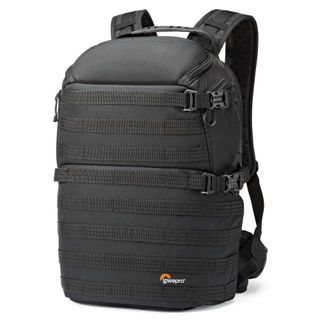
1. Lowepro ProTactic 450 AW
Specifications, reasons to buy, reasons to avoid.
One of Lowepro ’s bigger backpacks, the Lowepro ProTactic 450 AW can hold one or two pro-grade Nikon DSLRs and up to eight additional lenses or other accessories, so you don’t need to leave anything behind that you might need on a shoot. It’s equally suitable for hiking into the hills, touring the city, or just about anything else. Access to kit is quick and easy, thanks to four separate access points on the top, rear and both sides of the backpack. For negotiating tricky terrain and climbing over obstacles, there’s a waistband that adds stabilizing support as well as providing extra storage for small items, but you can remove this if you need a more streamlined approach. Lowepro’s ActivZone System design ensures a really comfortable fit.
If you're looking for something slightly smaller, why not try the Lowepro ProTactic 350 AW which we think is the best camera backpack . It comes with a lot of the same features as the 450 AW such as external straps, a tripod pouch, a rigid top and adjustable waist and chest straps only in a more compact design. It's perfect for carrying a Nikon D850 or a Nikon Z7 II plus two or three additional lenses, a flash and smaller accessories.
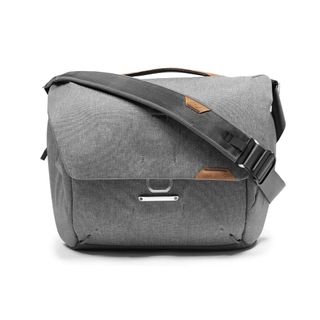
2. Peak Design Everyday Messenger
For everything from nipping out for coffee, navigating the daily commute or embarking on a grand day out, the Peak Design Everyday Messenger is a really smart messenger bag for stashing your Nikon camera kit. Available in 13-inch and 15-inch options, it’s ideal for carrying a medium-sized Nikon DSLR kit, plus either a 13-inch or 15-inch laptop, respectively. Innovative design elements include quick-action MagLatch closures, plus a zippered top flap for even faster access to your camera, without opening the whole bag. ‘FlexFold’ dividers are said to be origami-inspired and, while they work very well to cosset your kit, they can seem a bit unintuitive at first. The Version 2 editions have enhanced weatherproofing and their small inner pockets are made from a more durable fabric. This is a brilliant bag for your Nikon camera.
Read more: The best messenger bags for photographers

3. Billingham Hadley Pro
The Billingham Hadley Pro is hard to beat. It’s super-stylish and impeccably made, featuring a fully waterproof canvas-look outer, coupled with full-grain leather and brass fixings. For a photographic shoulder bag, the design is refreshingly slim, and yet there’s enough room inside for a full-frame DSLR body like the D850 with an attached 24-70mm f/2.8 lens, plus a 70-200mm f/2.8 zoom (without tripod collar) and a pro-grade flashgun like the SB-5000. Two additional front pockets enable extra gear to be stashed away, and the rear zippered pocket is big enough for a tablet. For heavier collections of kit, the optional shoulder pad is worth buying, and additional AVEA pockets that can attach to both ends are also available, in two sizes.

4. Tenba Fulton v2 16L backpack
Our expert review:
The Tenba Fulton v2 16L is perfect for mirrorless Nikon shooters looking for a comfortable day bag that looks smart but is also very practical. It has space for a body and several extra lenses although it's not really big enough for a professional Nikon DSLR such as the Nikon D850 and telephoto lenses. The dividers are easily customisable and could even be arranged to fit a drone in as well as a camera with lens attached. There are external pockets to attach a tripod and water bottle and plenty of compartments for smaller accessories such as memory cards and spare batteries. We loved using the Tenba Fulton and found it especially great for city shooting and content creators. The one downside is it doesn't have a quick side access pocket so you do need to take the bag off every time you want to access the camera section but that's not the end of the world.
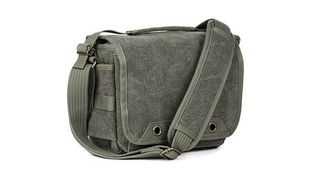
5. Think Tank Retrospective 5 V2
This Think Tank messenger may be on the small size but it's perfect for those times when you really want to minimize the kit you've got on you. It's available in two colors, Pinestone as pictured or black if you prefer something more traditional. It's got a thick, padded strap for extra comfort and is easily adjustable. There's enough room for a DSLR OR CSC and one of the best Nikon standard zoom lenses plus small accessories such as filters or an extra battery. The Think Tank Retrospective 5 V2 Shoulder Bag would be perfect for a street photographer who wants easy access to their kit or to a landscape photographer who wants to carry one wide-angle lens and one zoom lens. There is a zip close fastening as well as a flap for additional security and like the original bag, it's made of a soft flexible material. Perhaps not the best bag for traveling with as it could get crushed in overhead lockers on trains or planes but definitely perfect for a city wander.
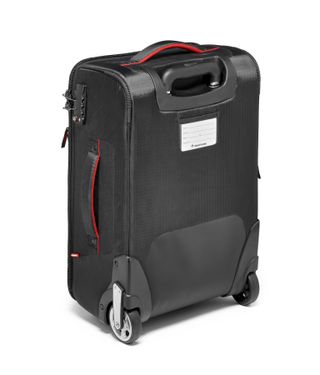
6. Manfrotto Reloader Air-55 PL Roller Bag
Giving great protection to your camera kit, this Manfrotto Reloader Air-55 PL Roller Bag has a cavernous main compartment with endlessly adjustable dividers. It therefore adapts to snugly cosset just about any collection of Nikon camera bodies, lenses and other accessories. Additional pockets are built into the lid for safeguarding both a tablet and a laptop of up to 17-inches in size. Further pouches are built into the underside of the flap for smaller accessories. Typical of roller bags, it has a sturdy set of wheels and an extending handle, for easy maneuvering around anything from train and coach stations to airport terminals. However, when you do need to lift the bag, it’s rather weighty at nearly 5kg even when empty.
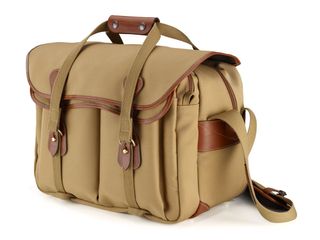
7. Billingham 445
The Billingham 445 is the middle-sized bag in Billingham’s ‘5 Series’ range. It can swallow up one or two Nikon DSLR bodies and up to eight additional lenses, flashguns and the like. There’s also a full-length front pocket that can accommodate a 13-inch laptop, for which a laptop slip is available as an optional extra. Nine different pockets are included, which can be arranged at will to suit different photographic items, and external Delta pockets are also available separately, for attaching to the bag. The quality is fabulous throughout but it’s a relatively heavy bag and, even though a shoulder pad is included, it can be a strain to carry when fully laden.
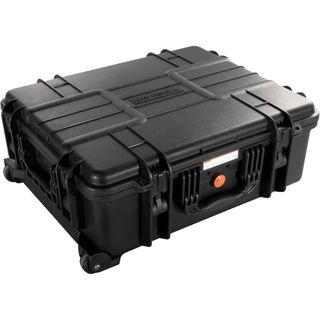
8. Vanguard Supreme 53D Hard Case with Divider Bag
The best hard Nikon camera case: Keep your Nikon camera kit safe from harm, this Vanguard Supreme 53D Hard Case with Divider Bag offers supreme protection. It’s super-tough, fully dust-proof and waterproof, has steel reinforced padlock rings and an automatic pressure release valve to cope with changes in air pressure and altitude, for example when stowed in the baggage hold of an aircraft. It’s also O-ring sealed to withstand being submerged in water, down to a depth of five metres. The softer side of the case is within, as it comprises a removable soft inner bag with adjustable dividers. There are no less than three carrying handles for lifting the case, plus a set of wheels and a retractable pull-along handle. The wheels are most welcome, given that the case weighs almost 8kg even without anything in it.
More buying guides
- The best camera backpacks
- The best camera sling bags
- The best messenger bags for photographers
- The best luxury leather and canvas camera bags
- Hard cases for cameras
- The best roller bags for your camera
- The best camera accessories
- The best Nikon flashguns
- The 10 best travel cameras
- The best cheap cameras
- The best tripods for travel
Get the Digital Camera World Newsletter
The best camera deals, reviews, product advice, and unmissable photography news, direct to your inbox!
Having studied Journalism and Public Relations at the University of the West of England Hannah developed a love for photography through a module on photojournalism. She specializes in Portrait, Fashion and lifestyle photography but has more recently branched out in the world of stylized product photography. For the last 3 years Hannah has worked at Wex Photo Video as a Senior Sales Assistant using her experience and knowledge of cameras to help people buy the equipment that is right for them. With 5 years experience working with studio lighting, Hannah has run many successful workshops teaching people how to use different lighting setups.
Related articles
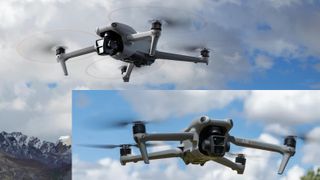
Travelling is ultimately a tool for growth. If you want to venture further, click this banner and take the leap 😉
- Meet the Team
- Work with Us
- Czech Republic
- Netherlands
- Switzerland
- Scandinavia
- Philippines
- South Korea
- New Zealand
- South Africa
- Budget Travel
- Work & Travel
- The Broke Backpacker Manifesto
- Travel Resources
- How to Travel on $10/day
Home » Gear » best nikon travel lenses
The 16 Best Travel Lenses for Nikon • Comprehensive Guide
Nikon is one of the oldest and most respected camera manufacturers in the world. For over 100 years, this company has been producing photographic equipment that is used and loved by all types of people.
Nikon gear is used by professional photographers, journalists, enthusiasts, and everyday-folk alike; it is thanks to their mutual love for Nikon that the company has been so successful.
Nikon is well-known for its camera sensors, which are among the most advanced camera bodies on the current market. That said, a sensor is nothing without a lens. Nikon users should be just as concerned with their travel lens selection as they are with their camera body, which is what we’re going to talk about today.
There are over 90 Nikon lenses to choose from and even more when you consider 3rd parties like Sigma, Tamron, and Rokinon. If you’re having trouble sorting through these lenses and choosing the best Nikon travel lens for yourself then we don’t blame you.
That’s why we’re here to help! We at Broke Backpacker have an extensive knowledge on Nikon’s lens library are ready to help you out with any and all of your questions.
We’ve compiled a list of the 16 best Nikon lenses for travel photography. Each lens is uniquely designed and will appeal to a certain type of photographer. Whether you’re a run-and-gunner, a Zen landscape master, or a pro at portraiture, there is a lens out there made just for you.
So let’s get to it then! Here are the best Nikon lenses for travel photography currently available!
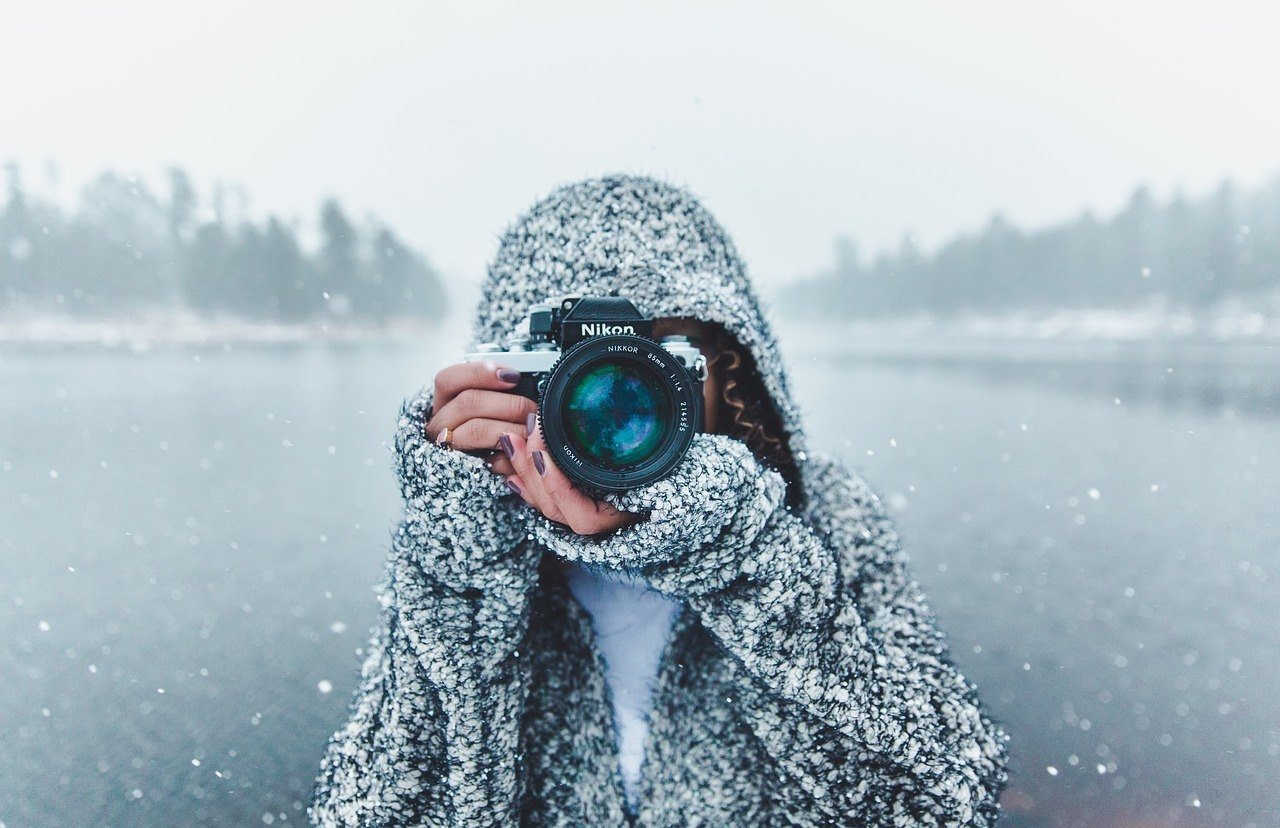
The Broke Backpacker is supported by you . Clicking through our links may earn us a small affiliate commission, and that's what allows us to keep producing free content 🙂 Learn more .
Quick Answers: Best Nikon FX Travel Lenses of 2024
Quick answers: best nikon dx travel lenses of 2024, best nikon travel lenses for fx mount, best nikon travel lenses for dx mount, things to consider when buying the best nikon travel lenses, faq about the best nikon travel lenses.
- Overall Best Travel Lens for Nikon FX – Nikon AF-S FX NIKKOR 24-120mm f/4G ED VR
- Best Budget Travel Lens for Nikon FX – Nikon 24-85mm F/3.5-4.5G ED VR AF-S
- Best Professional Travel Lens for Nikon FX – Nikon AF-S FX NIKKOR 24-70mm f/2.8G
- Best Prime Travel Lens for Nikon FX – Nikon 50mm f/1.4G SIC SW
- Jump to -> The List of Best Nikon FX Travel Lenses of 2024
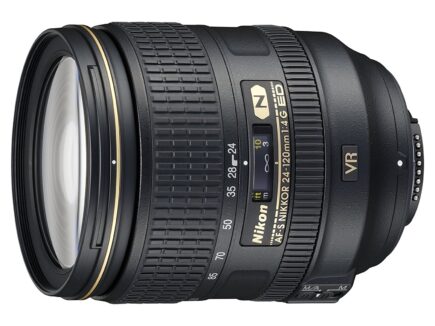
Nikon Nikkor 24-120mm f/4.0
- > Great focal range
- > Lightweight
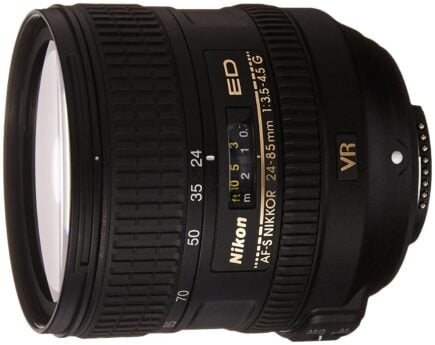
Nikon Nikkor 24-85mm f/3.5-4.5
- > Good center sharpness
- > Good autofocus
- > Affordable
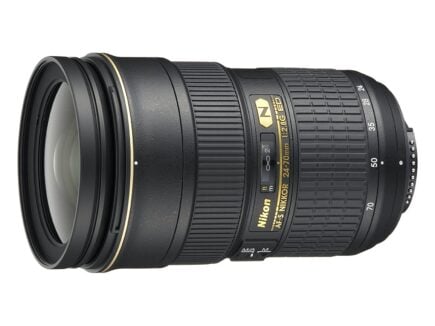
Nikon Nikkor 24-70mm f/2.8
- > Outstanding sharpness
- > Very robust
- > Great autofocus
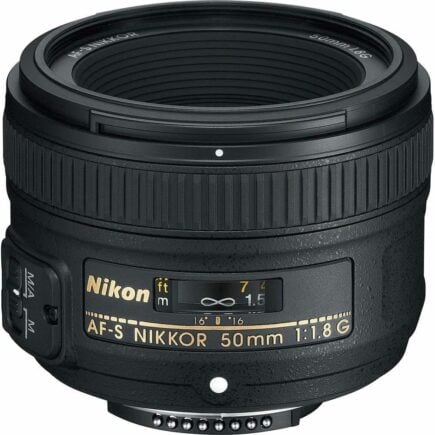
Nikon Nikkor 50mm f/1.8
- > Light and durable
- > Very affordable
- Overall Best Travel Lens for Nikon DX – Sigma 18-300mm F3.5-6.3 DC Macro OS HSM
- Best DX Budget Travel Lens for Nikon DX – Sigma 17-50mm f/2.8 EX DC OS HSM FLD
- Best DX Professional Travel Lens for Nikon DX – Sigma Art 18-35mm f/1.8
- Best EF-S Prime Travel Lens for Nikon DX – Nikon AF-S DX NIKKOR 35mm f/1.8G
- Jump to -> The List of Best Nikon DX Travel Lenses of 2024
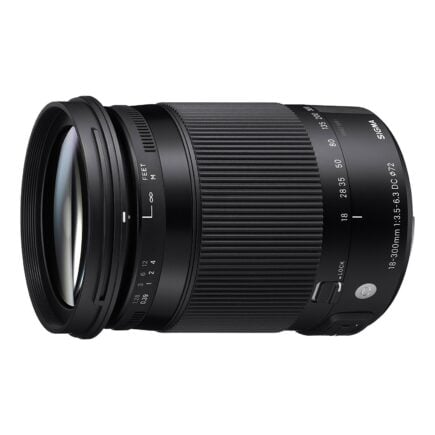
Sigma 18-300mm f/3.5-6.3
- > Good optics
- > Well designed
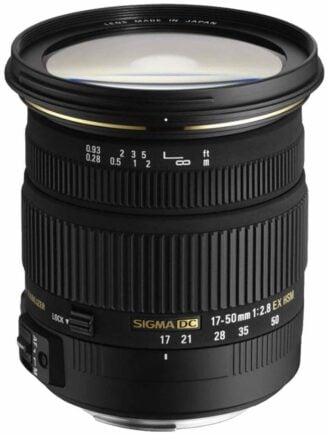
Sigma 17-50mm f/2.8
- > Fast aperture
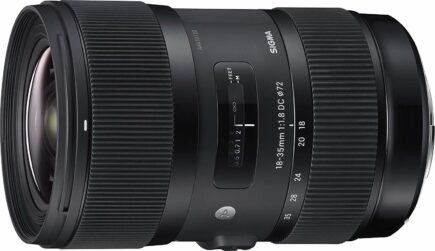
Sigma Art 18-35mm f/1.8
- > Unbeatable resolution
- > Unbeatable resolution Very fast aperture
- > Limited optical imperfections
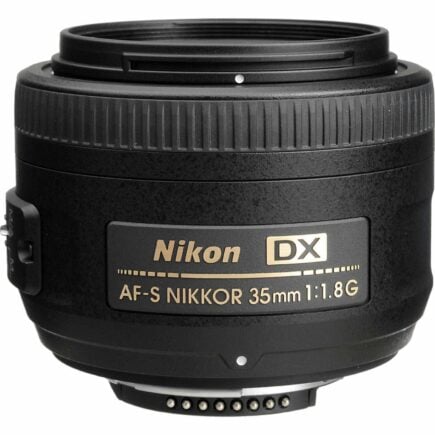
Nikon Nikkor 35mm f/1.8
- > Great performance
- > Amazing price
- > Very portable

REI is one of America’s biggest and most-loved outdoor gear retailers.
Now, for just $30, get a lifetime membership that entitles you to 10% OFF on most items, access to their trade-in scheme and discount rentals .
Overall Best Nikon Travel Lens (FX): Nikon AF-S FX NIKKOR 24-120mm f4 G ED VR
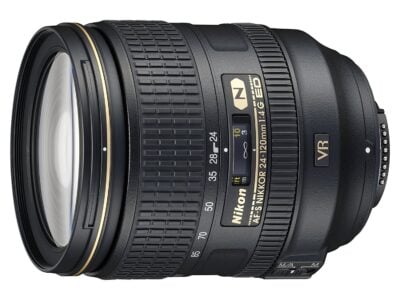
- Price: $1096.95
- Weight: 1.56 lb / 710 g
- Dimensions: 3.31 x 4.06″ / 84 x 103 mm
- Filter Size: 77mm
- Optical Stabilization: Yes
The Nikkor 24-120mm f/4 ED VR is our pick for the best Nikon travel lens! This iteration of the classic “do-everything travel zoom” is a worthy piece of equipment, thanks in part to its solid optical performance, effective vibration reduction, and relative lightweight.
Those who are traveling the world and need something both powerful and portable will find the 24-120mm is one of the best options.
The Nikon Nikkor 24-120mm f/4G ED VR appealing because of its useful focal range. At 24-120mm, this lens can capture all sorts of subjects and will appeal to many types of photographers.
Landscape photographers will appreciate the relatively wide 24mm angle while portrait photographers will get some pretty solid headshots at the telephoto end.
Optically, the Nikon Nikkor 24-120mm f/4 performs very well. Images are super sharp, particularly in the center, from the widest aperture. The corners are bit soft but improve dramatically when the lens is stopped down.
Vignetting and distortion are visible at both ends of the focal range but luckily these problems can easily be fixed in post-processing. The bokeh created by the 24-120mm isn’t the best, and many photographers find it too busy or chaotic.
To be honest, the problems that the Nikon Nikkor 24-120mm f/4G ED VR suffers from are to be expected. Travel zooms like this one are usually prone to optical imperfections but, given the usefulness of the lens’ focal range, these tradeoffs are almost always acceptable.
The Nikon Nikkor 24-120mm f/4 is made of high-grade plastics. Although these plastics are pretty durable, they are not weather resistant. Those who expose their lenses to elements frequently may be concerned with the Nikon 24-120mm’s ruggedness or lack thereof.
- Excellent sharpness.
- Very useful focal range and VR.
- Relatively lightweight.
- Vignetting/distortion when shot wide or telephoto.
- Unattractive bokeh.
- Plastic construction.
Best Budget Nikon Travel Lens (FX): Nikon 24-85mm F/3.5-4.5G ED VR AF-S
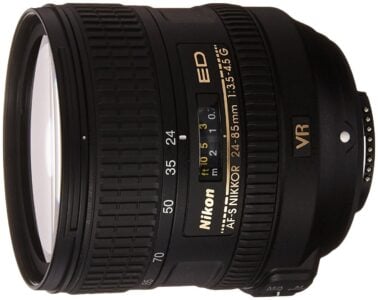
- Price: $325.55
- Weight: 1.02 lb / 465 g
- Dimensions: 3.07 x 3.23″ / 78 x 82 mm
- Filter Size: 72mm
For those who don’t want to shell out $1,000+ for a professional zoom, the Nikon 24-85mm f/3.5-4.5G ED VR is an excellent alternative. For around $500, you can have a lens with good image quality, a solid set of features, and excellent packability. Though the Nikon 24-85mm f/3.5-4.5 is far from perfect, it still does a great job of capturing beautiful images.
Optically, the Nikon 24-85mm f/3.5-4.5G ED VR performs pretty well. Center sharpness is excellent throughout the entire focal range. The vibration reduction and autofocusing systems are very capable as well and should increase photo quality in either dimly lit or fast-paced environments.
The Nikon 24-85mm f/3.5-4.5G ED VR does suffer from quite a few optical blemishes. Distortion, both the barrelling and pincushion varieties, is noticeable throughout the focal range. Vignetting and corner softness are also strong when the lens is used wide open.
Even though it was designed to be used on the FX mount, the Nikon 24-85mm f/3.5-4.5G ED VR oddly enough feels more suited for a DX camera. Because of the sensor cropping, the corners suffer less from softness and vignetting while on a DX body.
Regardless of its inherent flaws, the Nikon 24-85mm f/3.5-4.5G ED VR is still an effective lens that is capable of delivering excellent photos. It will require a little extra effort to get the most out of this camera but, once you master it, the Nikon 24-85mm f/3.5-4.5G ED VR can be one of the best budget travel lenses for Nikon FX users.
- Good center sharpness throughout the focal range.
- Quick, silent autofocus.
- Affordable.
- Distortion throughout the range.
- Heavy vignetting.
- Optical blemishes more apparent on FX mount.
Best Professional Nikon Travel Lens (FX): Nikon AF-S FX NIKKOR 24-70mm f/2.8G
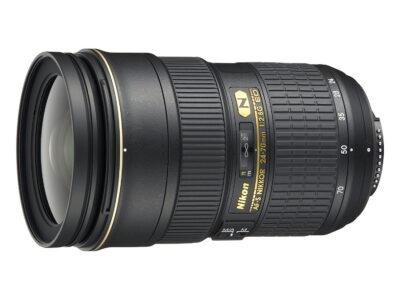
- Price: $629
- Weight: 1.98 lb / 900 g
- Dimensions: 3.27 x 5.24″ / 83 x 133 mm
- Optical Stabilization: No
For those looking for a superlative lens and are willing to fork out the necessary dough, the Nikon AF-S FX Nikkor 24-70mm f/2.8G is one of the best that money can buy.
Thanks to its stellar image sharpness, blazing fast autofocus, and superb build quality, the Nikon AF-S FX Nikkor 24-70mm f/2.8G is our choice for the best travel lens for professional Nikon photographers.
The Nikon AF-S FX Nikkor 24-70mm f/2.8G is a worthy addition to the photographic world. Like most other fixed-aperture zooms, the Nikon AF-S FX Nikkor 24-70mm f/2.8G is near-flawless optically.
More than that, it just performs amazingly well – autofocus is some of the fastest in the Nikon line, and construction is of such high quality the lens can handle most forms of weather.
All and all, the Nikon AF-S FX Nikkor 24-70mm f/2.8G strives to be a perfect lens and, for the most part, comes close. As is the case with pro medium zooms though, the question is “what doesn’t this lens have?”
Like a lot of Nikon lenses, distortion and vignetting are present in the Nikon AF-S FX Nikkor 24-70mm f/2.8G, but to a much lesser degree. Many photographers will not notice these imperfections. Those that do can easily fix them with post-processing software as always.
The Nikon AF-S FX Nikkor 24-70mm f/2.8G also lacks vibration reduction tech, perhaps to keep costs and/or size down to a minimum. The fast f/2.8 aperture should do well enough in low light. For those that really want the VR though, there’s a newer, more expensive model that comes equipped with it.
- Outstanding sharpness.
- Extremely quick autofocus.
- Very robust build-quality.
- Some corner softness and vignetting.
- No vibration reduction tech.
Best Prime Nikon Travel Lens (FX): Nikon 50mm f/1.8G
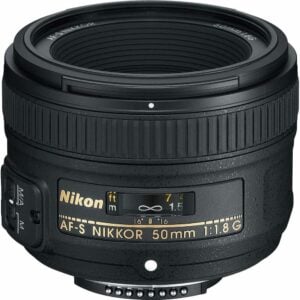
- Price: $149.98
- Weight: 6.53 oz / 185 g
- Dimensions: 2.84 x 2.06″ / 72.1 x 52.4 mm
- Filter Size: 58mm
Almost every photographer’s first prime lens is a 50mm, or “nifty fifty.” These lenses are popular first choices because they’re almost always a) useful b) effective and c) affordable. Nikon’s own 50mm f/1.8 is no exception to this trend!
The Nikon 50mm f/1.8G is everything that you’d expect from a nifty fifty – it’s sharp, portable, very fast, and, best of all, a screaming deal.
Optically, the Nikon 50mm f/1.8G is a solid performer. Sharpness is respectable when shot wide open and becomes impressive when stopped down to f/2.8 and f/4.
Vignetting and corner sharpness are present in the Nikon 50mm f/1.8G when it’s shot wide open. Most will hardly recognize these faults since the background will probably be thrown out anyways and lost in the lens’ bokeh, which is gorgeous by the way. Distortion is a bit heavy for a prime lens but this can easily be fixed in post-processing.
It goes without saying that the Nikon 50mm f/1.8G is very portable, weighing only a paltry 185 grams. The lens doesn’t have the best depth of field markings, which may or may not turn off traditional photographers who like to know their hyperfocal values.
At the end of the day, what makes the Nikon 50mm f/1.8G so great is its unbeatable price. For around $200 new, you can have an extremely useful lens that sacrifices little in the way of performance.
Those looking for the best prime lens for Nikon then should look no further than the Nikon 50mm f/1.8G.
- Light yet durable.
- Amazing price.
- Distortion.
- Vignetting/corner softness at widest aperture.
- Poor DOF markings.
Best Nikon Travel Lens for Landscape Photographers (FX): Nikon AF-S FX NIKKOR 16-35mm f/4G ED VR
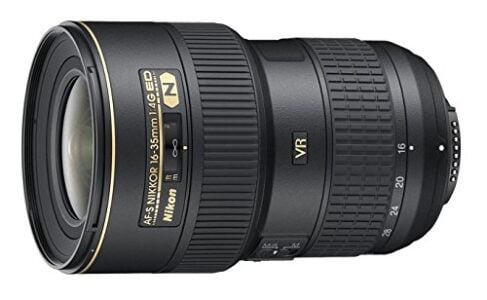
- Price: $398
- Weight: 1.50 lb / 680 g
- Dimensions: 3.25 x 4.92″ / 82.5 x 125 mm
The Nikon Nikkor 16-35mm f/4G ED VR is an exceptional wide-angle lens. The photos that this camera produces have an awesome resolution, are generally free of optical blemishes and just drop-dead gorgeous.
For landscape photographers, the Nikkor 16-35mm f/4G ED VR is one of the best Nikon travel lenses that they can own.
There’s little to begrudge of the Nikon Nikkor 16-35mm f/4G ED VR in terms of image quality. From f/4.0, center sharpness is superb and by f/8.0 the entire frame is crisper than a fresh set of bed sheets. Corners do show a bit of softness when the lens is used wide-open but this is to be expected from an ultra wide angle.
Distortion is very apparent when the lens is set to 16mm. This distortion is nothing debilitating – modern post-processing software can fix this imperfection – but it just really stands out within the focal range.
Luckily, all other forms of optical blemishing are well controlled in the Nikon Nikkor 16-35mm f/4G ED VR. Chromatic aberrations are nearly absent and vignetting is limited throughout the focal range.
The Nikon Nikkor 16-35mm f/4G ED VR comes equipped with vibration reduction technology, which is great for those using their DSLR for filmmaking. Pure landscape photographers may use this feature less frequently but it doesn’t hurt to have.
- Impressive sharpness.
- Well controlled vignetting and chromatic aberrations.
- VR tech for filmmaking.
- Corners are a bit soft at wide apertures.
- Heavy distortion when shot at 16mm.
- Perhaps a bit large (but only).
Best Nikon Travel Lens for Portrait Photographers (FX): Nikon AF S NIKKOR 85mm f/1.8G
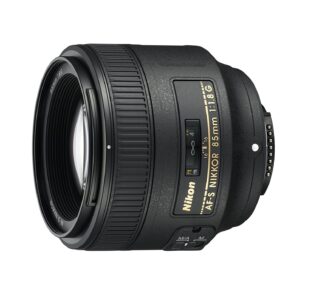
- Price: $479.95
- Weight: 12.35 oz / 350 g
- Dimensions: 3.15 x 2.87″ / 80 x 73 mm
- Filter Size: 67mm
85mm lenses are some of my favorites because, aside from their useful focal length and portable size, they almost always have near-perfect optics. The Nikon 85mm f/1.8G is such a lens.
With stellar sharpness and not too much else to complain about, the Nikon 85mm f/1.8G is one of the best Nikon travel lenses for portrait photographers.
Optically, there’s not a lot that the Nikon 85mm f/1.8G could improve on. Images are very sharp even at the widest aperture. Corners are a bit soft at the widest aperture but these will probably go unnoticed since this lens is primarily a portrait lens. When the lens is stopped down, images are tack sharp from corner to corner.
Any and all other optical blemishes are not an issue in the Nikon 85mm f/1.8G. Vignetting and distortion are practically non-existent and chromatic aberrations are very limited.
Unfortunately, the autofocus is a bit of head scratcher in the Nikon 85mm f/1.8G, at least when compared to its predecessor. The Nikon 85mm’s new autofocus system is quieter but is for some reason slower than the older model.
Even with its slightly slower autofocusing system, we still believe that this model is the best version of the lens. Most photographers will find that they don’t need the autofocus to be any faster.
Construction-wise, the Nikon 85mm f/1.8G is small and well-built. Overall, it’s a sturdy lens and should hold up quite well although its plastic construction may not appease photographers that don’t care for the material in the first place.
- Fantastic image quality.
- Fast and light.
- Great price.
- A little soft at larger apertures (but still great!).
- Autofocus is a bit slower than its predecessor.
- Plastic construction may irk some purists.
Best Nikon Travel Lens for Astrophotographers (FX): Rokinon 20mm f/1.8 AS ED UMC
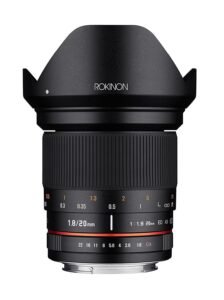
- Price: $429
- Weight: 1.09 lbs/497 g
- Dimensions: 3.27” x 3.48”
- Image Stabilization: No
Lenses produced by the Korean company Rokinon, or Samyang as it’s sometimes referred to, are very popular with astrophotographers mostly due to their excellent performance and price. The Rokinon 20mm f/1.8 AS ED UMC is one of the best lenses from this company. With an ultra-wide angle and super fast aperture, you can capture the night sky in all of its splendor and not have to break the bank in the process.
For these reasons, we think that the Rokinon 20mm f/1.8 AS ED UMC is the best Nikon travel lens for astrophotography.
Rokinon lenses are cheaper because they do not use a lot of expensive electronics that are usually included in modern day lenses. As such, most if not all of Rokinon lenses do not have autofocusing capabilities. This means that you’ll have to focus the Rokinon 20mm f/1.8 AS ED UMC manually.
Honestly, focusing manually isn’t as much of a pain as some make it out to be; it is, sometimes, preferable. The zoom ring is smooth and easy to understand, thanks to the detailed DOF markings on the side of the barrel.
Optically, the Rokinon 20mm f/1.8 AS ED UMC performs very well. Sharpness is great but CA is noticeable at wider apertures. To alleviate chroma, try stopping the lens down a tad to eliminate CA but not so much too much to cause diffraction, which sets in about f/11.
The body of the Rokinon 20mm f/1.8 AS ED UMC is built from high-grade plastics while the mount is metal; both are quite sturdy. The whole lens can feel quite bulky, though not as much as some other full frame lenses.
- Great bang for your buck.
- Limited distortion.
- Awesome aperture for an ultrawide.
- Manual only.
- CA and vignetting present at the widest aperture.
Best Nikon Travel Lens for Telephoto Lovers (FX): Nikon 70-300mm f/4.5-5.6G ED IF AF-S VR
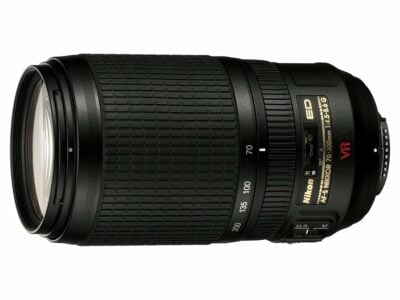
- Price: $298
- Weight: 26.3 oz / 745 g
- Dimensions: 143.5mm x 80mm / 5.6 in. x 3.1 in
The Nikon 70-300mm f/4.5-5.6G VR is one of the most surprising lenses on this list. For less than $500, this lens is, somehow, shockingly sharp, very lightweight, and functionally complete thanks to additions like VR and internal zooming.
In short, we love this lens and think it’s not only one of the best telephotos but hands-down one of the best lenses for Nikon.
There is a lot to like about the Nikon 70-300mm f/4.5-5.6G VR. Optically, this lens impresses, beginning sharp at its widest aperture and staying respectably sharp throughout its entire range.
The resolution does drop a bit as the lens approaches the 200mm mark but the degradation is marginal. CA also picks up as you zoom in but, as the image resolution, is relatively unobtrusive.
Since the Nikon 70-300mm f/4.5-5.6G VR has a slower aperture, it’s not very adept at shooting in low-light situations. The normally responsive autofocus tends to get lost and shutter speeds can become dangerously low. Vibration reduction tech is thankfully included in the lens, which helps a lot when the light is dim.
Construction-wise, the Nikon 70-300mm f/4.5-5.6G VR is made from high-grade plastics that are assembled very well. The lens feels robust in your hands yet still light.
What more is there to say about this lens except that it’s fantastic. Granted, it does have a few shortcomings and it obviously can’t match the resolution of the more expensive telephotos e.g. the Nikon 70-200mm f/2.8. These points being made, what the Nikon 70-300mm f/4.5-5.6G VR accomplishes for its price point is still remarkable.
- Awesome sharpness.
- Very light body that includes VR, internal zooming, and sealing.
- Struggles in low-light.
- Sharpness drops as you zoom in.
- CA present.

Do You Want to Travel FOREVER??
Pop your email in below to get a FREE copy of ‘How to Travel the World on $10 a Day!’.
Overall Best Nikon Travel Lens (DX): Sigma 18-300mm F3.5-6.3 DC Macro OS HSM
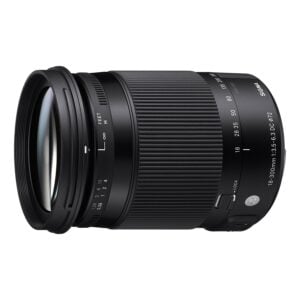
- Price: $598
- Weight: 20.6 oz / 585 g
- Dimensions: 4.0 in. x 3.1 in / 101.5mm x 79mm
Superzoom lenses get a bit of a bad rap sometimes. Many of them, in the process of doing so much, sacrifice a lot of optical quality.
Though every once in a while, a superzoom comes along that doesn’t give away too much, and is able to perform up to and beyond the call of duty; the Sigma 18-300mm f/3.5-6.3 DC Macro OS HSM is one such lens.
The Sigma 18-300mm f/3.5-6.3 DC Macro OS HSM is able to capture excellent photos and does a good job of covering up its inherent flaws.
The inclusion of optical stabilization helps to mitigate the lens’ limited aperture and an excellent build quality ensures both durability and portability.
Price-wise, there’s little to complain about with the Sigma 18-300mm f/3.5-6.3 as well. Given these points, we think that the Sigma 18-300mm f/3.5-6.3 DC Macro OS HSM is the best overall travel lens for Nikon DX users who want to have their cake and eat it too.
The Sigma 18-300mm f/3.5-6.3 DC Macro OS HSM offers commendable image resolutions. Sharpness is excellent at wider angles but does drop marginally as the lens is zoomed in. This lens also produces some excellent colors and contrast but not so much a pleasing bokeh.
Chromatic aberrations in the Sigma 18-300mm f/3.5-6.3 DC Macro OS HSM are well controlled. Distortion and vignetting are predictably present, as is the case usually with superzooms, but these are never debilitating.
Most users will be shocked at and probably even sold by how light the Sigma 18-300mm f/3.5-6.3 DC Macro OS HSM is. At 585 grams, this baby is practically feather-like especially when you consider how much it does.
The body still feels solid, although the zoom ring is somewhat fiddly at times.
- Solid optical performance for a superzoom.
- Durable, lightweight construction that includes optical stabilization.
- Very affordable.
- Bokeh is unattractive.
- Focus ring is tedious.
- Does more but at a sacrifice of quality.
Best Budget Nikon Travel Lens (DX): Sigma 17-50mm f/2.8 EX DC OS HSM FLD
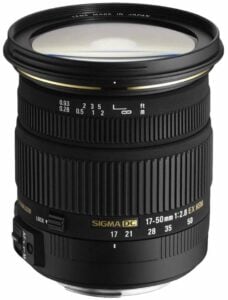
- Price: $699.95
- Weight: 1.24 lb / 565 g
- Dimensions: 3.3 x 3.6″ / 8.38 x 9.14 cm
- Image Stabilization: Yes
Like its 18-300mm cousin, the Sigma 17-50mm f/2.8 EX DC OS is a well-performing piece of equipment that is made unignorable by its low cost. For only $300 (!!!!), you can own a fixed aperture medium zoom lens that performs admirably.
Given this amazing deal, it’s no wonder that we think the Sigma 17-50mm f/2.8 is the best budget lens for Nikon DX users.
The Sigma 17-50mm f/2.8 EX DC OS HSM performs very well. Sharpness is overall very good though the edges can be a little soft when the lens is used wide open. Vignetting is present at wider apertures as well but chromatic aberrations and distortion are both well-controlled.
Image stabilization is built into the Sigma 17-50mm f/2.8 and works as it should. Combined with fast aperture, the Sigma 17-50mm f/2.8 EX DC OS HSM is a stud in low light situations. Filmmakers will especially appreciate this setup when trying to film in dim interiors or dusky streets.
The Sigma 17-50mm f/2.8 EX DC OS HSM is an overall lightweight lens, more so than many of Nikon’s other zooms. This is due to its all-plastic construction, which is great for cutting weight but does make the lens feel a little more fragile.
The focus ring of the Sigma Sigma 17-50mm f/2.8 EX DC OS HSM feels a little more finicky than usual and can be difficult to use sometimes.
- Excellent price point.
- Great center resolution.
- Fast aperture and image stabilization
- Visible corner softness when shot wide open.
- Tedious focus ring.
Best Professional Nikon Travel Lens (DX): Sigma 18-35mm F1.8 Art DC HSM
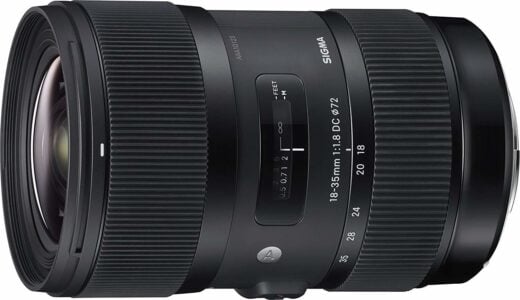
- Price: $699
- Weight: 1.78 lb / 811 g
- Dimensions: 3.07” x 4.76” / 78 x 121 mm
If I were trying to convince someone to invest in a DX system over the full frame FX one, I would submit to them the Sigma Art 18-35mm f/1.8.
Simply put, this lens is one of the most gorgeous, useful, and respected lenses in all of photography. It is, without a shadow of a doubt, one of the greatest lenses made in recent years and is, deservingly, the best professional travel lens for Nikon’s DX mount.
The Sigma Art 18-35mm f/1.8 has it all – supreme image quality, a super fast aperture, robust construction, and lightning-quick autofocus. The Sigma Art 18-35mm f/1.8 is amazingly sharp, frame-wise from corner to corner and focal-wise from end to end.
Chromatic aberrations, vignetting, and distortion is present but in microscopic amounts. Optically this lens is superlative.
The Sigma Art 18-35mm f/1.8 is made from various alloys and feels very robust, perhaps tank-like. Topping out at over 800 grams, this lens is definitely on the heavier side. Many photographers enjoy the weightiness though and find that it adds a nice balance to the lens.
The focal range of the Sigma Art 18-35mm f/1.8 is pretty small and one may wonder if it can be considered a travel lens at all.
At the very least, the range of the Sigma Art 18-35mm lies in that sweet spot where many of the most useful focal lengths lie. Given the unprecedented performance of this lens as well, we think that it’s a worthy tradeoff.
- Ridiculously sharp at all times.
- Extremely fast.
- Very few optical blemishes (CA, distortion, vignetting, etc)
- Big and fat.
- Pretty limited focal range for a travel lens.
Best Prime Nikon Travel Lens (DX) : Nikon AF-S DX NIKKOR 35mm f/1.8G
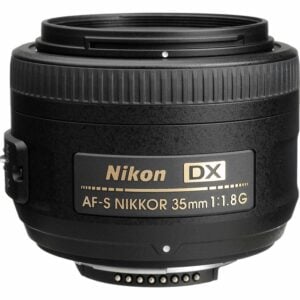
- Price: $117.8
- Weight: 10.76 oz / 305 g
- Dimensions: 2.83 x 2.81″ / 72 x 71.5 mm
Much in the same way every full frame owner needs a “nifty fifty,” every owner of an APS-C camera should own 35mm prime lens. The best 35mm prime lens that a DX owner can buy is the Nikon AF-S DX NIKKOR 35mm f/1.8G.
With excellent optics, solid performance, and an insignificant price tag, the Nikon 35mm f/1.8 is one of the most reliable Nikon lenses available.
Like the Nikon 50mm f/1.8, the 35mm will be very useful to every kind of photographer, and may end being the most used lens in their kits.
The Nikon AF-S DX NIKKOR 35mm f/1.8G performs much in the same as the other enthusiast-level f/1.8 primes in the Nikon library – images produced by the 35mm, though not devoid of problems, are for the most part very attractive.
Sharpness is excellent even at the widest aperture and peaks at around f/2.8 and f/4.0. Distortion is present, sometimes in disconcerting levels although editing software can still fix this. Chromatic aberration and vignetting are well controlled.
True to the other f/1.8 Nikon primes, the body of the Nikon 35mm f/1.8 is very small and portable. That being said, the Nikon 35mm f/1.8 is still made primarily of plastics and is not meant to withstand extreme weather.
The key consideration when buying this lens – and the thing that will most likely convince people to do so – is the fact that it’s so cheap. For only a few hundred dollars, you get a lens that works very well and produces some really beautiful photos.
For the amount of money you’re putting up, the Nikon 35mm f/1.8 is an excellent investment.
- Great performance.
- Very portable.
- A bit more distortion than usual for a prime.
- Some CA and vignetting.
Best Nikon Travel Lens for Landscape Photographers (DX): Nikon AF-P DX NIKKOR 10-20mm f/4.5-5.6G VR
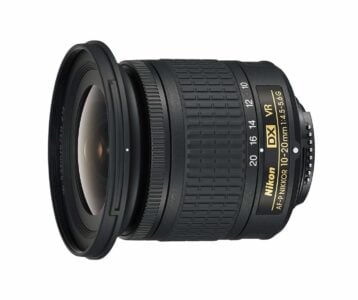
- Price: $214
- Weight: 8.11 oz / 230 g
- Dimensions: 3.03 x 2.87″ / 77 x 73 mm
For the price you pay, the AF-P DX NIKKOR 10-20mm f/4.5-5.6G VR is a total diamond in the rough and certainly one of the best lenses for Nikon shooters who like wide angles!
Though somewhat unimpressive on paper, the Nikon 10-20mm f/4.5-5.6 offers excellent image quality, packability, and even vibration reduction, which is a bit of treat considering this lens is than $300!
Resolution-wise, the Nikon 10-20mm does pretty well. Center sharpness is great throughout the zoom range while the corners catch up once the lens is stopped down. 15mm appears to be the sweet spot as well as 10mm and 20mm are both admirably sharp as opposed to being excellently sharp.
Vignetting and distortion are all present in the Nikon 10-20mm f/4.5-5.6G but no more than what should be expected from a wide angle zoom. Chromatic aberrations are the most obvious optical blemish with this lens and will have to be addressed in post-processing.
The vibration reduction and autofocusing systems in the Nikon 10-20mm f/4.5-5.6 both perform very well. The autofocus is quick, accurate, and virtually silent. The VR does a great job making up for the Nikon 10-20mm f/4.5-5.6G’s less than inspiring aperture, and promises up to 3.5 stops of compensation.
Aside from the price, one of the best features of the Nikon 10-20mm f/4.5-5.6G is its size. This pint-sized lens is so small that it could fit in a pocket. For those traveling light, the ability to do this is hard to turn down.
- Great image quality.
- Very light and small.
- VR tech compensates for aperture.
- Pretty slow aperture.
- Noticeable CA that will have to be corrected.
Best Nikon Travel Lens Portrait Photographers (DX): Nikon 50mm f/1.8G
If you know a bit about the physics of photography, then you probably know that a full frame lens can be mounted on an APS-C camera. When a full frame lens is used a such, the focal length is effectively lengthened as well.
If this concept is foreign to you, please refer to the Sensor Size section located at the end of this guide for a brief explanation.
When the Nikon 50mm f/1.8G is mounted on a DX body, it makes for a great alternative to the classic 85mm. With a new, equivalent length of 75mm and without sacrificing any optical quality, the Nikon 50mm f/1.8G is a very capable tool and one of the best travel Nikon lenses for portrait photographers.
In terms of optics, the Nikon 50mm f/1.8G barely changes at all when mounted on a DX body. This lens is still as sharp, responsive, and useful as ever.
For a more detailed explanation of the Nikon 50mm f/1.8G’s performance, refer to our earlier review in the Best Travel Lenses for Nikon FX section.
With an extra 25mms of length comes a narrower field of view with more isolated subjects. Portrait photographers will immediately latch on to these changes and take advantage of them in their work.
Using the Nikon 50mm f/1.8G primarily as a portrait lens also limits its flaws, as the inherent corner softness and vignetting become less noticeable. All-in-all, the Nikon 50mm f/1.8G is just as impressive on a DX if not an improvement.

Best Nikon Travel Lens for Astrophotographers (DX): Rokinon 16MAF-N 16mm f/2.0
- Price: $339
- Weight: 1.26 lb / 571 g
- Dimensions: 3.27 x 3.42″ / 83 x 86.9 mm
Rokinon delivers another winning lens! With excellent image quality, a fast aperture, and a low price tag that Rokinon 16mm f/2.0 is one of the best travel lenses for Nikon astrophotographers, so long as they don’t mind focusing manually.
Like the Rokinon 16mm f/1.8 reviewed prior, the Rokinon 16mm f/2.0 performs more than admirably. Center resolution is excellent at all apertures and by f/5.6 the entire frame is tack-sharp. CA, vignetting, and distortion are all well controlled in this lens and are only present in moderate amounts.
As is commonplace with Rokinon lenses, there are no electronic components in the 16mm f/2.0, which means that there is no autofocus. Users will have to manually focus this lens like they used to do in the good ol’ days.
Manual focus isn’t so bad. Landscape photographers will hardly miss autofocus as it’s not like their subjects are moving all that fast. Astrophotographers will not sweat the exclusion of it either as they usually just leave the lens set to infinity to capture those stars.
The Rokinon 16mm f/2.0 is made from high-grade plastics and has a solid metal mount. Those who are apprehensive of buying plastic lenses should feel good about the Rokinon 16mm f/2.0 as it feels very sturdy.
I’ve taken Rokinon lenses into some pretty hairy situations and they’ve held up just as well if not better than my weather-sealed equipment.
Ultra-wide angles lenses with fast apertures are usually very pricey. You can get the Rokinon 16mm f/2.0 for around only $300, which should be a convincing price. Granted, you don’t have autofocus but who needs it anyway?
- Distortion, CA, and vignetting are well controlled.
- Inexpensive.
- Manual focus.
- Softer corners and more imperfections when used wide-open.
Best Nikon Travel Lens for Telephoto Lovers (DX): Nikon 55-200mm f/4-5.6G ED IF AF-S DX VR
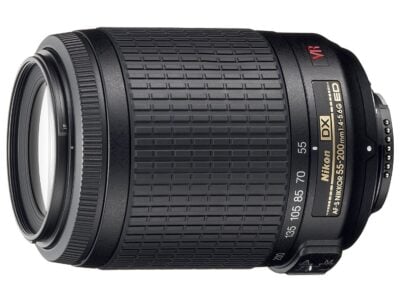
- Price: $199.95
- Weight: 10.58 oz / 300 g
- Dimensions: 2.78 x 3.27″ / 70.5 x 83 mm
- Filter Size: 52mm
Though not the sharpest telephoto lens nor the fastest one, both in terms of autofocus and aperture, the Nikon 55-200mm f/4-5.6G ED IF AF-S DX VR still manages to impress, thanks to its small size and price point.
For DX users who need something longer, this is one of the best Nikon travel lenses available.
Sharpness is pretty good in the Nikon 55-200mm f/4-5.6G – centers are crisp throughout the focal range while the corners are acceptable.
You’ll have to stop down to about f/8.0 to achieve maximum sharpness. Luckily, the VR is effective and helps to counteract the slower shutter speeds that occur when stopping down.
In terms of optical blemishes, chromatic aberrations are well-controlled, distortion is average, and vignetting is pronounced. Any and all of these can be addressed in post-processing, of course.
Unfortunately, the autofocus of the Nikon 55-200mm f/4-5.6G is a bit slow. Taking the slower aperture into account, action photographers may become frustrated with this lens. Those who shoot fast moving targets (e.g. sports or wildlife) may want to look for a different lens.
Like many of the best Nikon travel lenses on this list, the biggest selling point of the Nikon 55-200mm f/4-5.6G is the fact that it’s so small and affordable.
Travel photographers who don’t want to fork out $1,000 for a giant telephoto lens and don’t mind the slower performance should take fancy to the Nikon 55-200mm f/4-5.6G.
- Good center sharpness.
- Effective vibration reduction.
- Small and affordable.
- Slow autofocus.
- Corners are just ok.
- Not so good for action photographers.

Now, you could spend a fat chunk of $$$ on the WRONG present for someone. Wrong size hiking boots, wrong fit backpack, wrong shape sleeping bag… As any adventurer will tell you, gear is a personal choice.
So give the adventurer in your life the gift of convenience: buy them an REI Co-op gift card! REI is The Broke Backpacker’s retailer of choice for ALL things outdoors, and an REI gift card is the perfect present you can buy from them. And then you won’t have to keep the receipt. 😉
Photographers should value lenses just as much as their travel camera ! Lenses are one of the most important aspects of photography because they are the ones that actually refract the light and create the image (which is then written by the camera sensor).
Sharpness, contrast, color, composition; all of these aspects are influenced greatly by the quality of your lens. As one photographer once aptly put it: “you don’t invest in cameras; you invest in good glass.”
There are several things to consider when you are looking for the best travel lenses for a Nikon camera. Aspects like size, weight, vibration reduction, and more are all vital components to the making of a great travel lens.
Below is a list of features to consider when searching for the best travel lens for your Nikon camera.
Note that I’m going to be giving a crash course on several photographic concepts here. I’ll try to explain them as best as possible; otherwise, feel free to post any question regarding photography in the comment section below.
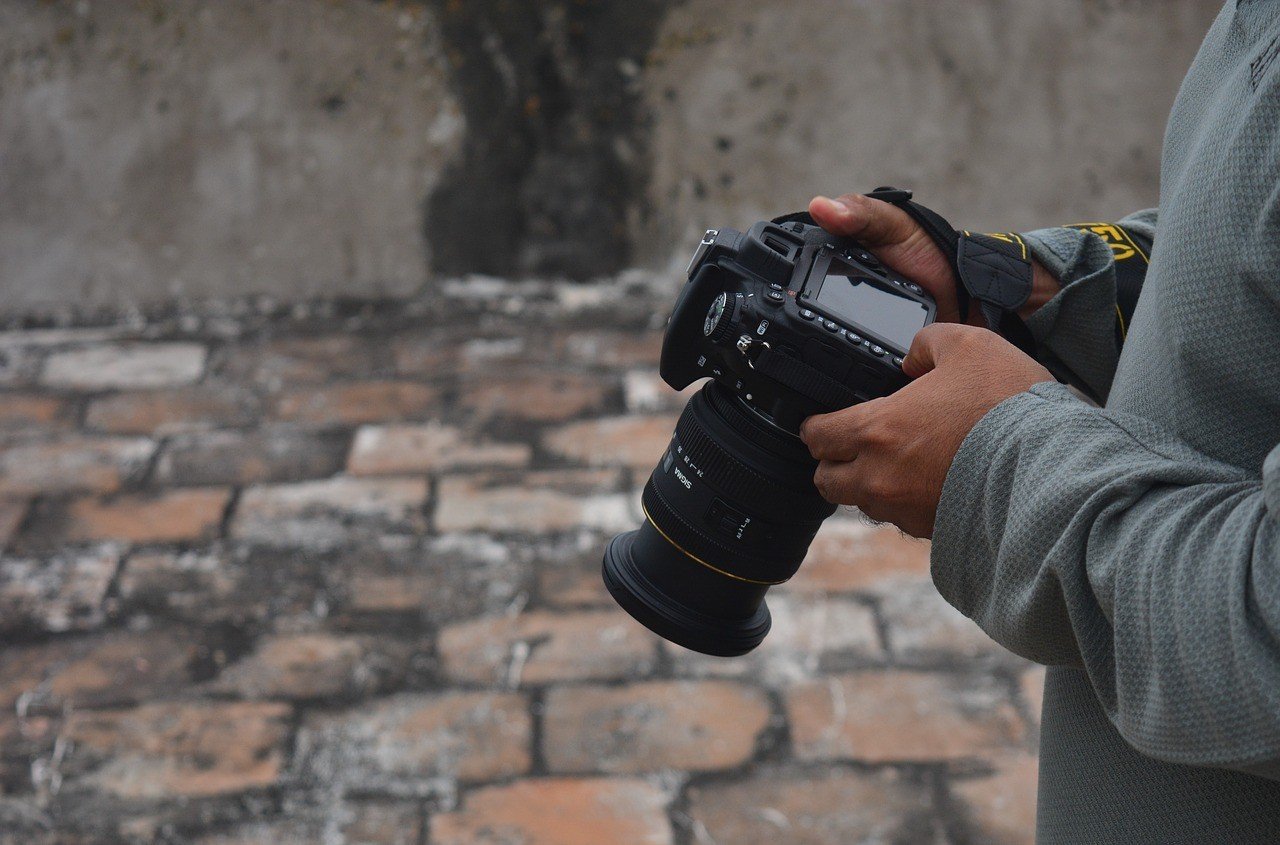
Size/Weight
Lenses vary greatly in size and shape; some are small enough to fit in your pocket, others are gargantuan pieces of equipment that require special storage. A lens’ mass and dimensions will play a large part in the size of a photographer’s bag and how they conduct themselves in the field.
Larger lenses obviously take up more space and add more weight to your pack. Sure, that lens appears small when it’s by itself but add 3 or 4 more to your pack and things quickly add up.
I have carried both ultralight and heavy camera packs and can attest that even a moderately heavy bag feels good for about a half-mile of walking.
If your camera bag has limited space and/or you like larger, higher-grade lenses, you’ll have to pick and choose your equipment wisely. Be very conscious of how much a lens weighs and how it measures. Be sure to think hard about how much you’re willing to carry.
If your camera bag is looking a bit shabby, maybe consider upgrading it as well. A good camera bag should fit your body like a glove and be able to hold all of the necessary equipment. Be sure to read our guide on the best travel camera bags for some ideas!
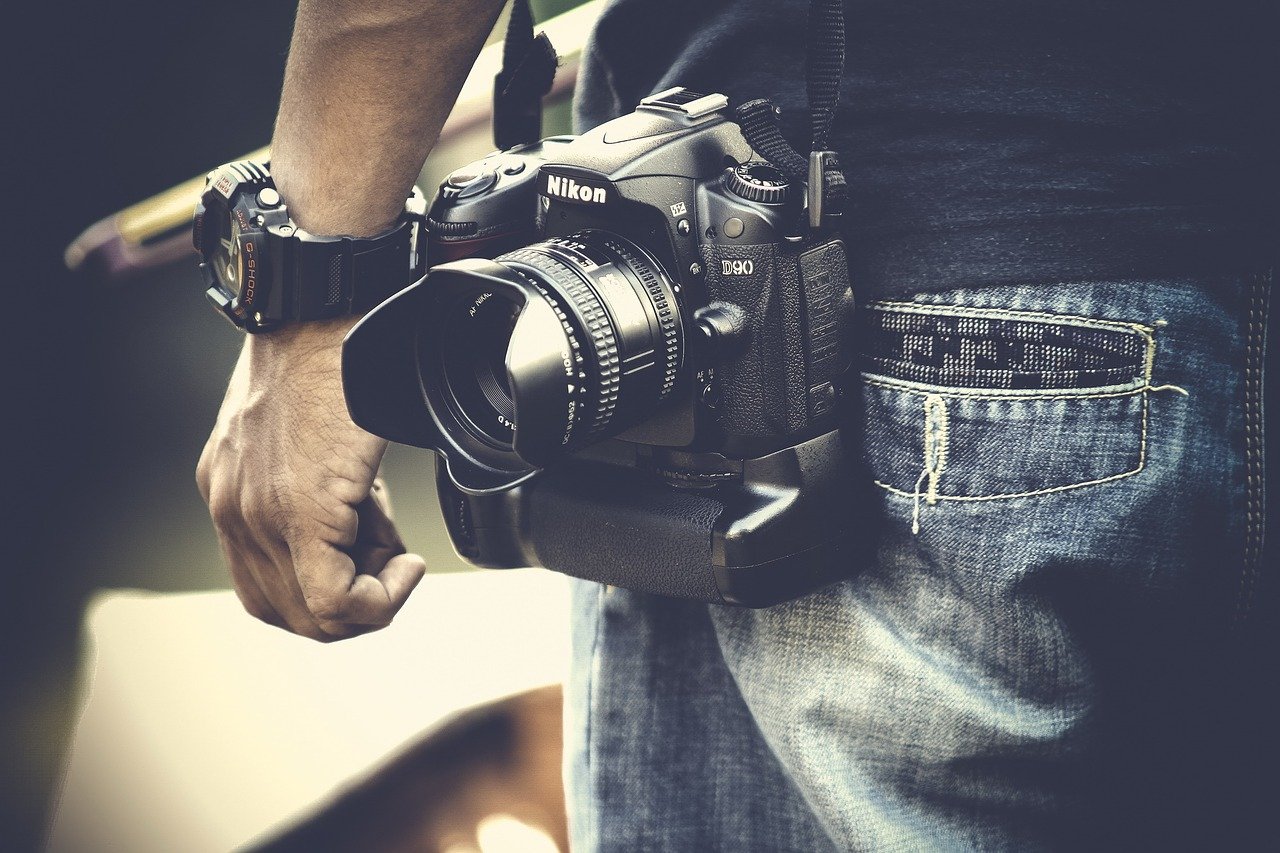
Along with shutter speed and ISO, the aperture is a vital part of the exposure triangle , which every photographer should be well-versed in.
Though shutter speed and ISO fall within the jurisdiction of the camera, the aperture is controlled via the lens. With the proper aperture and ability to use it, photographers will have much more power when it comes to creating the photos that they want.
Fast apertures – those that have a value of around f/2.8 or less – are usually the most desirable. Though not always the case, a faster aperture is usually indicative of optical quality. Regardless, fast apertures are usually most useful during situations that call for bokeh or those that are dimly lit .
In zoom lenses, constant aperture s are much more important as these definitely lead to higher quality images. The most common constant aperture ratings are f/2.8 and f/4.0. Both offer excellent quality of images.
A quick aperture is not always necessary as lots of lenses with slower apertures offer exceptional image quality.
Peak sharpness isn’t usually reached until around f/5.6 or f/8.0 anyway and shooting at extremely low apertures (e.g. f/1.4) can be more difficult than you think. Unless you really want a fast aperture, you may not need to spend the extra money.
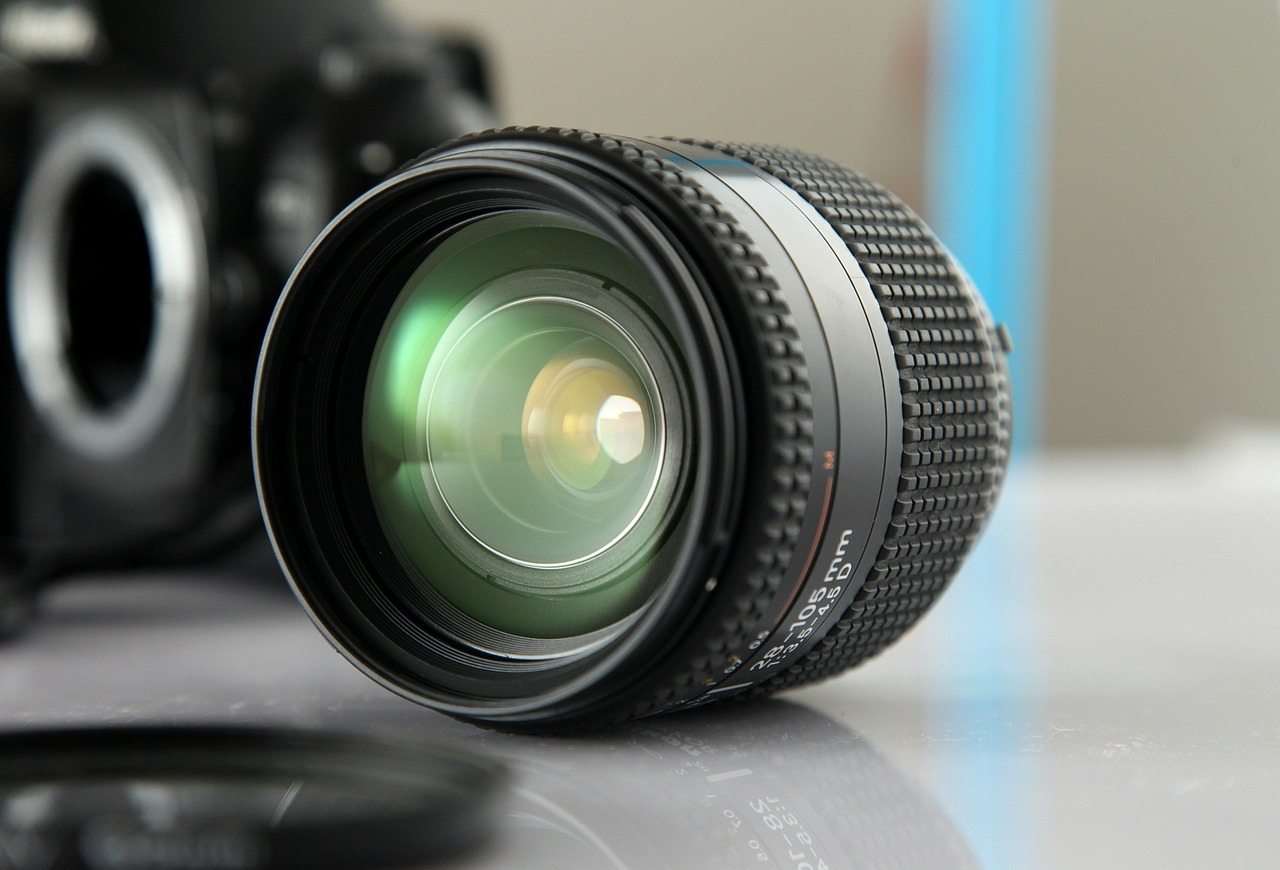
Focal Length/Type
Without getting into the physics of focal lengths , I will simply say that certain lenses with certain focal lengths are better for capturing certain scenes. Longer lenses, renowned for their shallow depth of field and isolating qualities, are great for portraits. Wider lenses, with their expansive fields of view, are great for interior shots when space is tight or for capturing big vistas.
It is very important to think about whether or not you want a lens that covers a single focal length or many.
If you’re like many photographers then you’ll probably value optical flexibility with a lens that covers more than one focal length. Lenses that can change their field of view are called zoom lenses , and these are among the most popular types of lenses.
Some zoom lenses o have trouble with certain optical imperfections (vignetting, chromatic aberrations, etc) and with maintaining sharpness. Generally speaking, the more expensive zooms do handle these issues better.
If you’re ok with shooting at only one focal length then consider a good prime lens . Prime lenses are usually sharper, cheaper, and more durable than zooms.
What type of photographer you are will determine what kind of focal length you find most useful. You’ll often find that certain lengths are more suitable to your style of shooting, or that you favor a particular lens over another.
Do not feel handicapped by what kind of lens you own though. With a bit of creativity and skill, you can make a lens do whatever you want. Remember: a lens is only as good as the photographer that uses it.
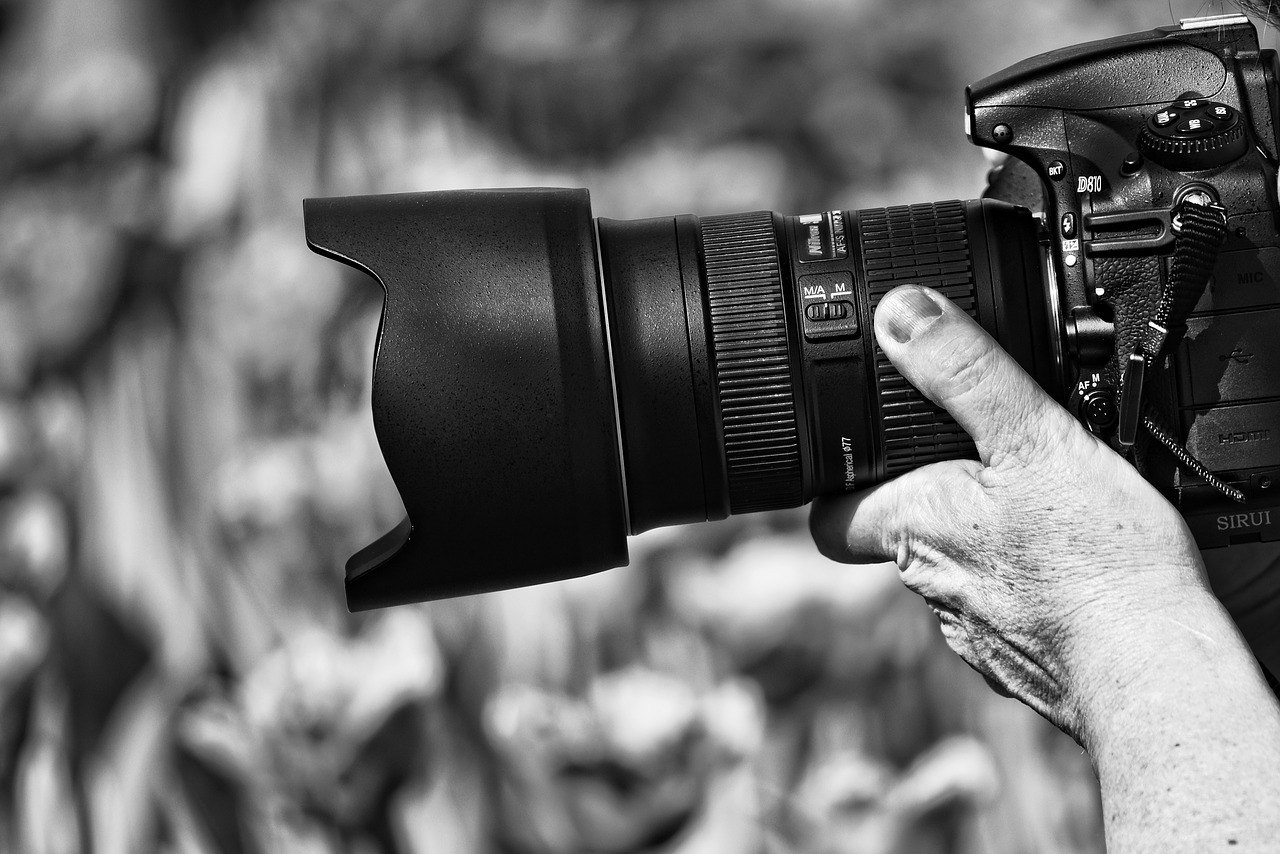
Not every autofocusing system is created equal – some are lightning-fast, utilizing state-of-the-art technology, while others are sluggish doofuses that can’t make heads or tails of a subject. How well an autofocus system behaves in a lens may or may not be a deal breaker for you.
Those who photograph fast-moving subjects – like in sports, concerts or wildlife photography – will need a lens that can keep up. In these cases, a quicker and more accurate autofocus system will be very beneficial.
These types of photographers also need to know that camera sensors play a role in autofocus as well – it’s not always just the lens doing the work.
Some photographers may not need fast autofocus or even autofocusing at all for that matter! Manual focusing lenses are still prevalent today and, aside from being markedly cheaper, can be very useful in certain situations.
Astrophotographers may actually prefer manual lenses because of their superb focus rings and because autofocus is usually useless in the pitch-black anyways.
Other photographers may even enjoy the vintage-like feel that comes with manual lenses, much like a musician might enjoy an old record.
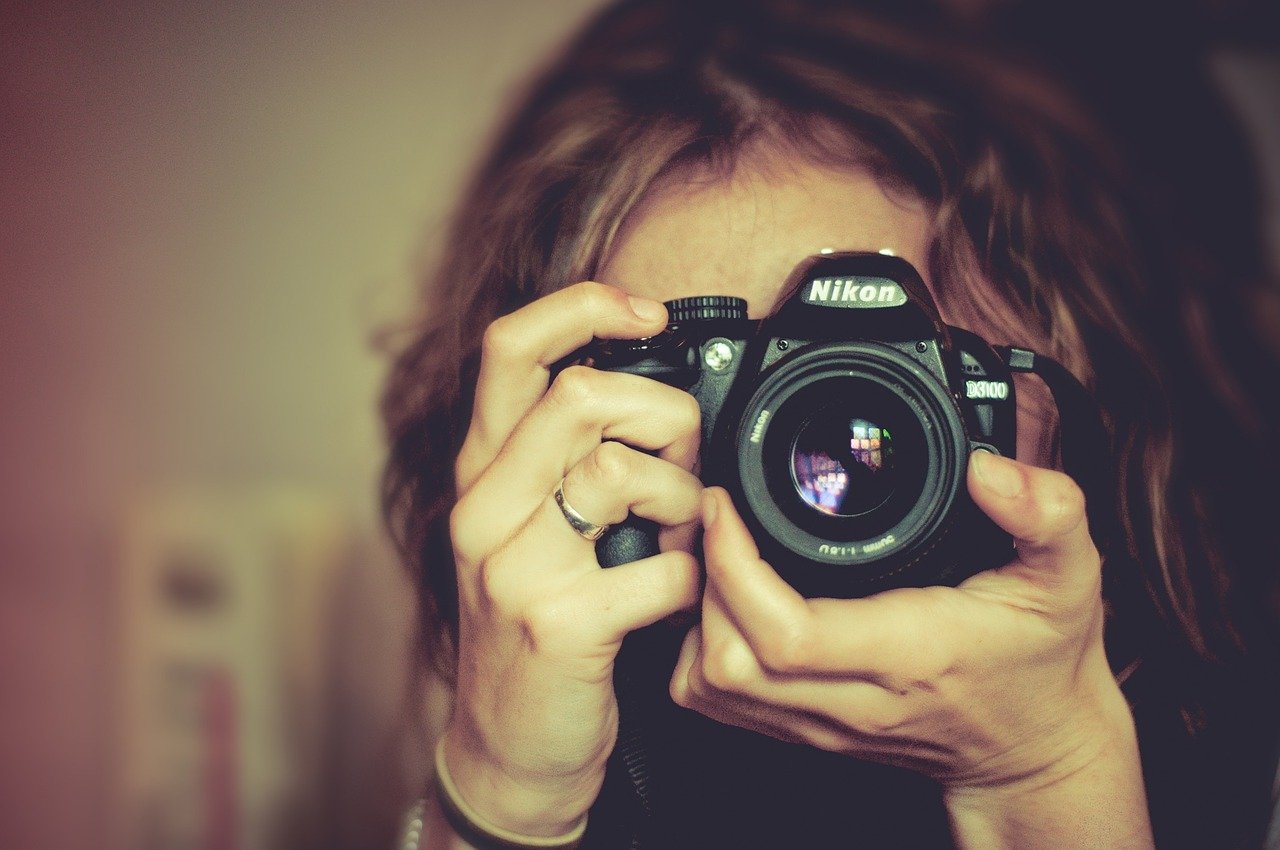
Filter Thread
Filters are used in photography to achieve creative effects as well as provide extra protection to a camera. These filters are attached to the front of a lens along a threading that has a unique rating (e.g. 58mm. 77mm, 82mm, etc).
There really isn’t such a thing as a proper filter threading. Most filter sizes have become standardized and there is almost always a full set of filters for each threading. No matter your lens, there’s a filter that will fit it.
One big reason to consider filter sizes has to deal with costs. As you buy more lenses you may end up with multiple filter threadings and, in turn, have to invest in filters for each one. This can be frustrating, especially when you know that filters behave in the same regardless of their size. Who wants to spend more money on the same?
A good way to avoid this annoyance is to invest in step-down rings, which then be used to adapt larger filters onto smaller threadings. Simply buy a set of filters that you know will be large enough for all of your lenses and then adapt to different threadings using the step-down rings.
Or think about investing in a slot-in filter system, which uses a screw-in adapter to hold a plate-like filter. Polarizer filters are not effective with slot-in filter systems.
For more information on filters, refer to the filter section of our Best Camera Accessories guide . You’ll also read about more general tools for your travel camera.
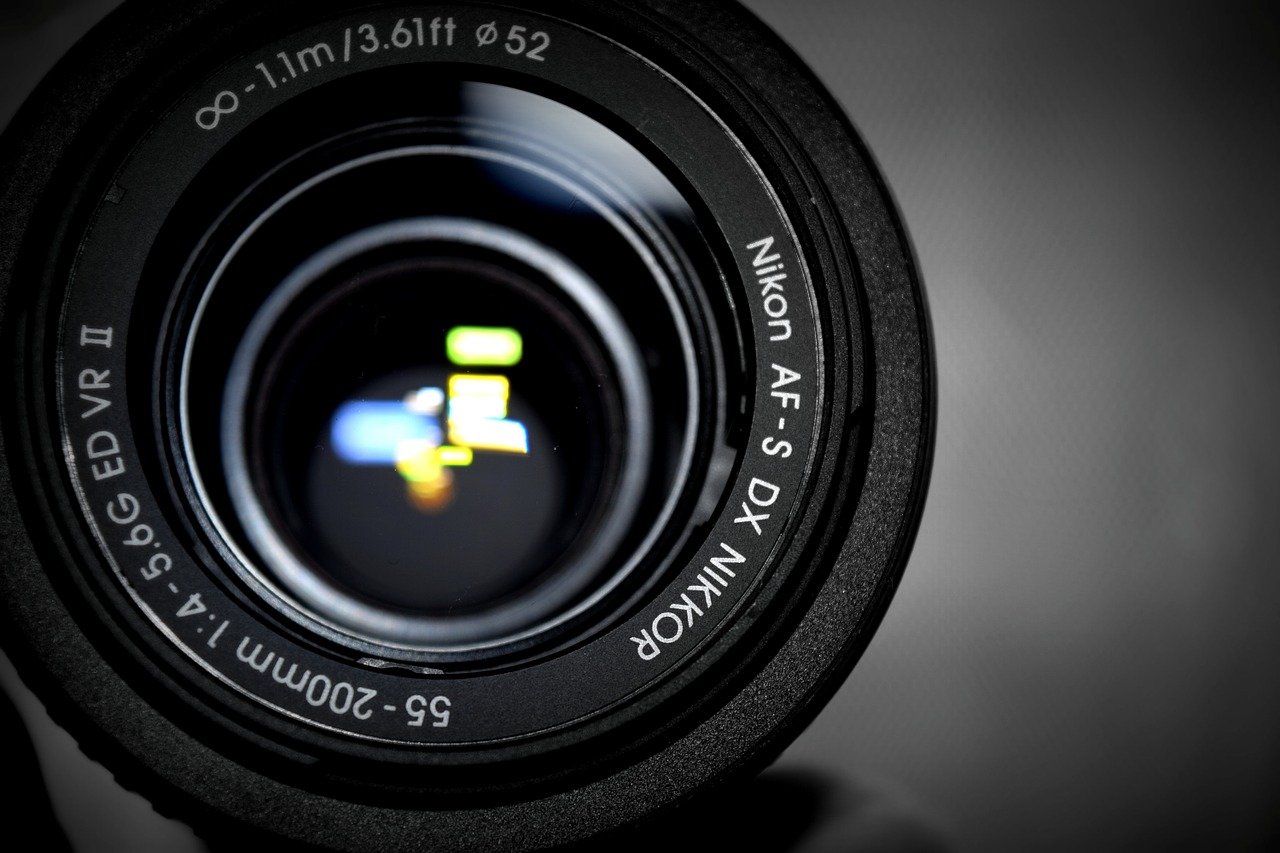
Vibration Reduction/Optical Stabilization
Optical stabilization technology has become extremely commonplace in modern-day lenses. This tech is found in all sorts of lenses, from cheap pieces of shit to luxurious, professional-grade glass. It is, at the end of the day, a very useful feature to have in your lenses as it can allow for some very crisp images.
Optical stabilization is referred to differently by different companies (e.g. image stabilization, IBIS, etc). Nikon refers to their optical stabilization tech as vibration reduction.
Vibration reduction (VR) works by compensating for shake caused by hand holding a camera. Handshake causes blurry images, which appears as a distinct softness, and most photographers tend to dislike this.
This shakiness is often unavoidable unless you’re using a tripod. With VR, blurriness caused by shaky hands is much less noticeable and sometimes eliminated altogether.
Whether or not you need optical stabilization is something to consider when you choose from the best Nikon travel lenses. If you’re a landscape photographer who constantly has their camera mounted on a tripod, optical stabilization is pretty redundant.
On the other hand, if you shoot subjects that require you to move often or you just like to have your camera ready in your hands, then VR would be useful.
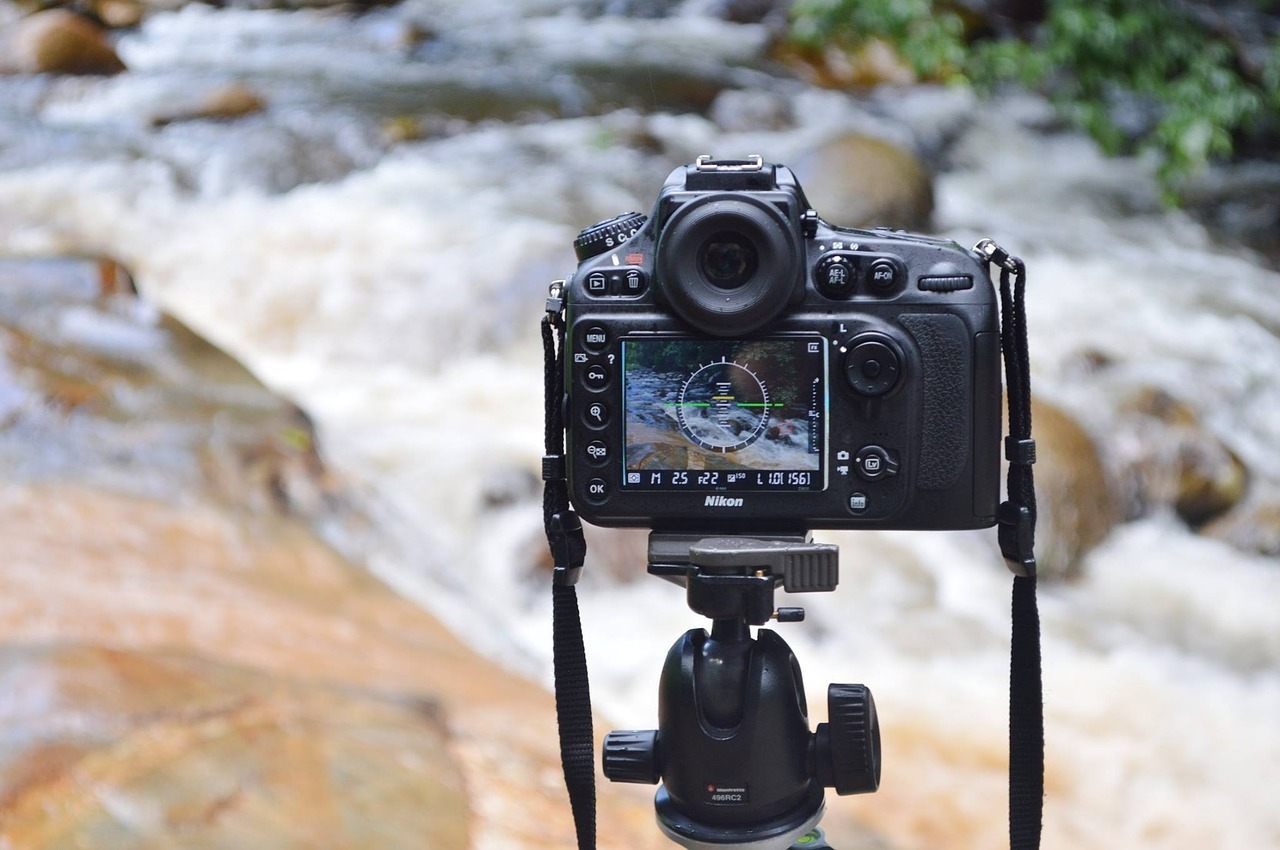
Sensor Size
Nikon makes a full frame DSLR and an APS-C DSLR. Each type of camera has its own lens library as well – Nikon’s full-frame system is referred to as FX while the APS-C one is referred to as DX .
DX lenses can only be mounted on an APS-C mount while FX lenses, though functional on an APS-C camera, work best on a full frame body.
If you mount an FX lens onto an APS-C body, then there are a few things to consider. 1) vignetting is possible; 2) certain lenses will behave differently on certain bodies; and, most importantly 3) the lens’ focal range will be lengthened i.e. a 24mm EF lens mounted onto EF-S camera will behave more like a 35mm lens.
For more on what happens when you mount a full frame lens onto an APS-C body, you can read this informative article here .
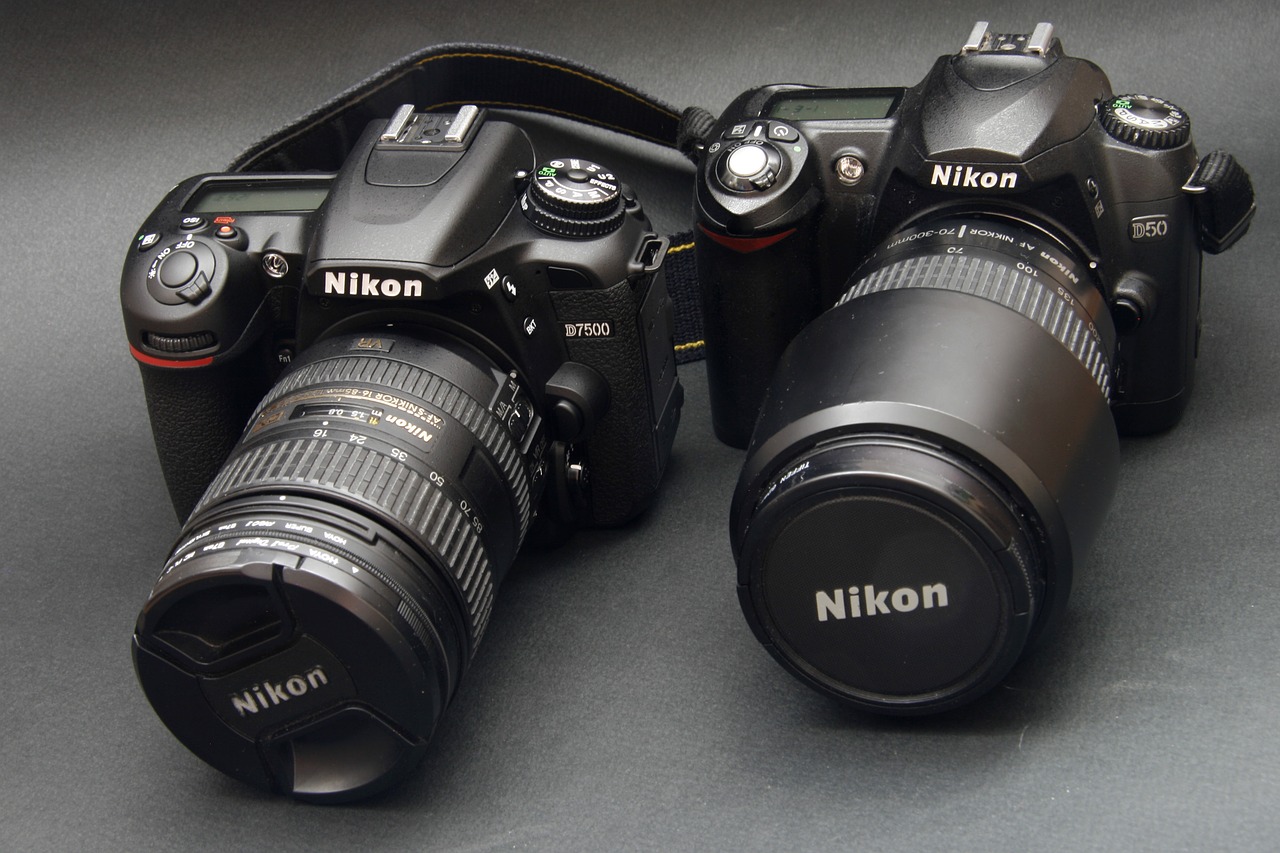
Still have some questions? No problem! We’ve listed and answered the most commonly asked questions below. Here’s what people usually want to know:
What is the best Nikon FX lens for travel photography?
The Nikon Nikkor 24-120mm f/4.0 is the best lense for travel photography and our favorite. For a Nikon DX camera, check out the Sigma 18-300mm f/3.5-6.3 .
What is most affordable Nikon lense?
Check out these budget lenses: – For Nikon FX – Nikon Nikkor 24-85mm f/3.5-4.5 – For Nikon DX – Sigma 17-50mm f/2.8
What do you need to consider when buying a Nixon lense?
Aspects like size, weight, vibration reduction, and more are all vital components that need to be considered when purchasing a lense.
What are the best Nikon lenses for professional travel photographers?
If you’re shooting with a Nikon FX consider getting the Nikon Nikkor 24-70mm f/2.8 . For the Nikon DX, check out the Sigma Art 18-35mm f/1.8 .

Our GREATEST Travel Secrets…
Pop your email here & get the original Broke Backpacker Bible for FREE.
Final Thoughts
There you have it folks – the 16 best travel lenses for Nikon users! Over the course of explaining these 16 lenses, we have given photographers all sorts of shooting options.
Each lens will be catered to a different type of photographer and each will have its own strengths and weaknesses. Figure out what kind of photographer you are and then choose from the best Nikon travel lens for yourself.
Know that each one will be different and dramatically affect the quality of your pictures.
Are you a traveling portrait photographer who wants some creamy bokeh? Then get the Nikon 85mm f/1.8 ! Do you want a DX lens that is optically flexible but affordable at the same time? Perhaps the Sigma 17-50mm f/2.8 will be right up your alley.
Think carefully about these 16 best Nikon travel lenses. The fact that you’re here reading this article means that you’re ready to take the next step into travel photography; perhaps you’re even ready to become a freelancer ?!
Look sharp out there my fellow backpacking photographers and make sure your lens is just as sharp too.
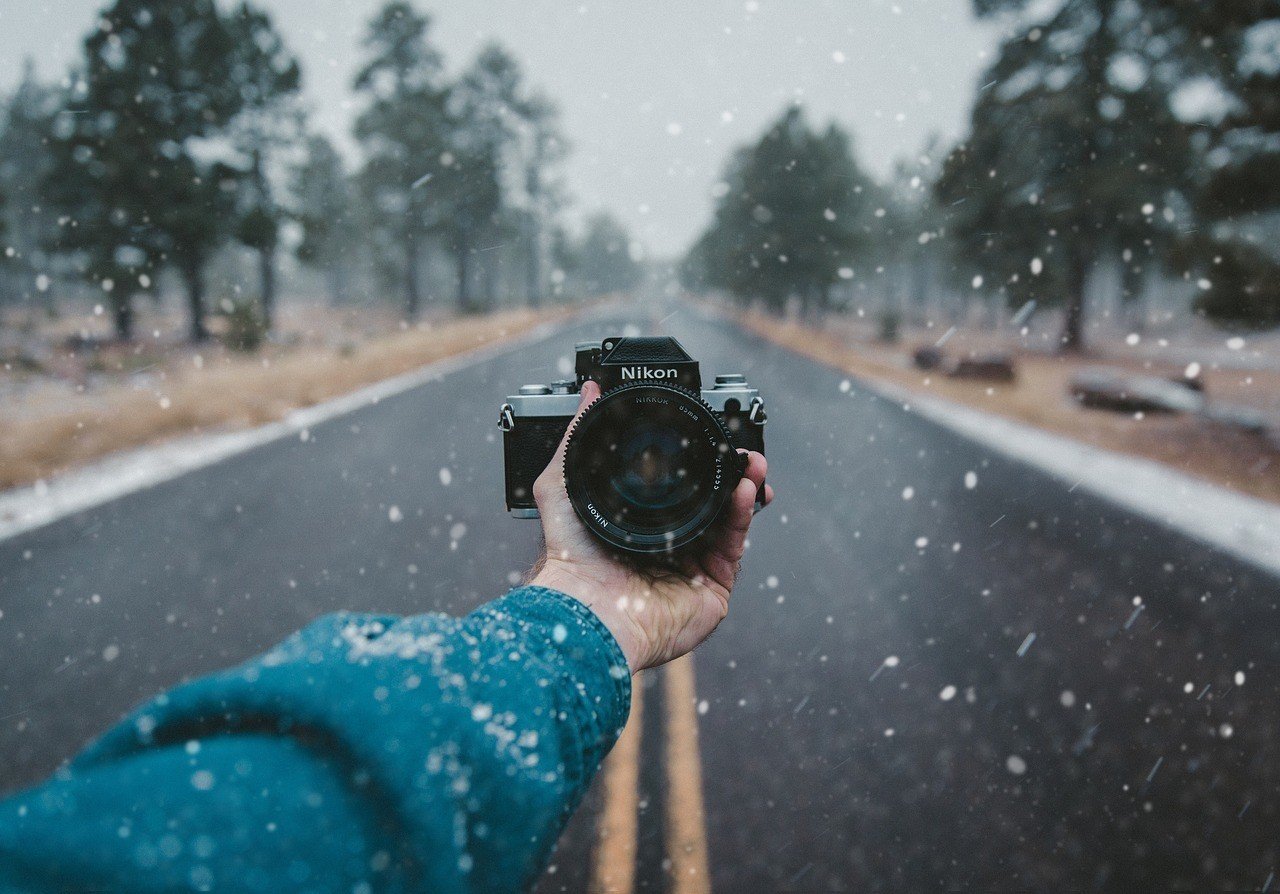
Share or save this post

I’ve had both Nikon 24-70s and would always choose the newer one with VR, especially for travel since, even if you bring a tripod, you won’t want to use it any more than necessary. Also, for travel, the better edge to edge sharpness is welcome. Having said that, it IS more expensive and heavier.
Good information. Note, the latest version of the Nikon 24-70mm F2.8 ED VR has VR, but really expensive. The newer Tamron G2 maybe an option at much lower cost but has external zoom. I have no experience with Tamron so comments are my opinion only.
Leave a Reply Cancel reply
Your email address will not be published. Required fields are marked *
Save my name, email, and website in this browser for the next time I comment.
Notify me of followup comments via e-mail.
The best travel camera for 2024: the finest choices for your adventures
The best travel cameras for your next big trip
- Best overall
- Best travel compact
- Best-looking
- Best action cam
- Best tough camera
- Best premium compact
- Best small full-frame
- Best hybrid vlogger
Best for moving subjects
- Best superzoom
How to choose
- How we test
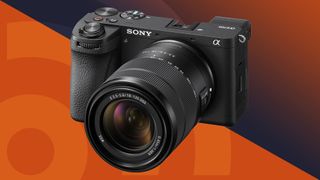
1. The list in brief 2. Best for most people 3. Best compact 4. Best-looking 5. Best action 6. Best tough 7. Best premium compact 8. Best small full-frame 9. Best hybrid travel vlogger 10. Best for moving subjects 11. Best superzoom bridge 12. How to choose 13. How we test
We’re often asked about the best travel camera, but the answer depends on what you plan to do with it. Adventurous travellers might want a rugged action camera; a city break will demand a discreet device that shoots sharp and steady handheld. There's no one size fits all and that’s why we’ve tested a wide range of travel cameras. In our round-up below, you’ll find everything from premium compacts to mirrorless hybrids – all ranked by our expert team.
After countless hours on the road, we think the best option for most people is the OM System OM-5. Thanks to a Micro Four Thirds sensor, it’s usefully portable. It’s also weatherproof and shoots better images than a smartphone, while offering the flexibility of interchangeable lenses. That said, we know it might not be the right choice for every traveller.
We recommend reading through our whole guide, to get a full picture of the best travel cameras you can buy right now. We’ve reviewed each model in the real world, to see how well it stacks up when shooting on the move. We assess factors such as handling, image stabilization and battery life, as well as image quality and autofocus performance. By listing the positives and negatives of each option, as well as who we think it’s best for, we’ve tried to make it as simple as possible to find your ideal travel camera. If compact size is your number one criteria, it's also worth checking out our best compact cameras guide.
Tim is TechRadar's Cameras editor, with over 15 years in the photo video industry and most of those in the world of tech journalism, Tim has developed a deeply technical knowledge and practical experience with all things camera related. Tim notes: "There's no one-size fits all travel camera, but all of the options recommended here share a few key traits: each is relatively portable, handles well while on the move and is capable of producing impressive holiday photos."
The quick list
If you don’t have time to read our full list of the best travel cameras, use the summary for a quick overview of to the top options for your needs and budget. If you find one that takes your fancy, use the links to jump to our full write-up.

The best travel camera overall
Squeezing a host of features into a compact, weatherproof body that’s compatible with a range of lenses, the OM-5 is the ideal travel camera.
Read more below

The best compact travel camera
If you want a camera that slips in your pocket but has smartphone-beating image quality, then the GR IIIx is well worth a look.
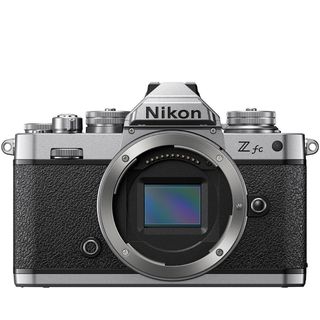
The best-looking travel camera
Don’t be fooled by its lovely retro looks: the Nikon Z fc is every bit the modern travel camera, with a useful touchscreen and top image quality.
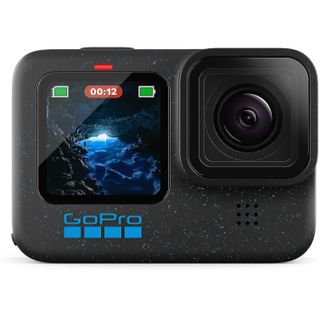
The best action camera for travel
With superlative stabilization and a useful 8:9 sensor for sharing videos to social, this is the best action camera for capturing intrepid travels.
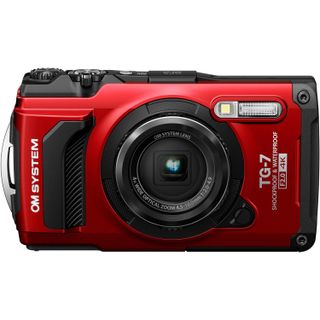
The best tough travel camera
When travels get tough, you need a camera that can keep up – which is where the rugged TG-7 comes into its own, with a hardcore build and simple interface.

The best premium compact
With a large sensor, 23mm focal length and small form factor, the X100VI is a powerful tool for street photography on your travels.
Load the next 4 products...

The best small full-frame camera
Combining a small form factor with a high-res 61MP sensor and fantastic autofocus, the Sony A7C R is the best full-frame camera for travel photography.

The best hybrid for travel vlogging
A capable sensor and automated settings, including a Vlogging mode, make the Fujifilm X-S20 an accessible tool for stills and video on the go.
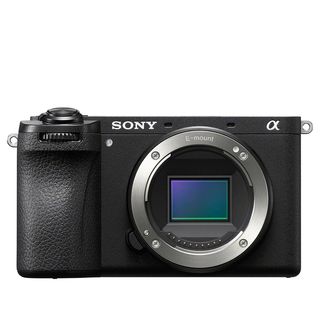
The best for moving subjects
The compact A6700 uses AI-powered autofocus to reliably snap on to animals, insects, cars and more. The Fuji X-S20 is better for video, though.
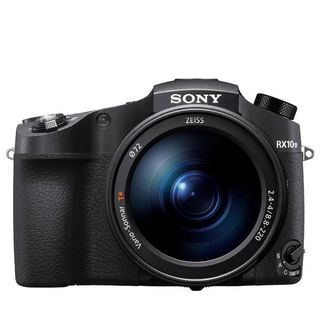
The best superzoom camera
Even with a 1-inch sensor, the Sony RX10 IV delivers sharp stills and video, with the added versatility of a generous 24-600mm zoom range.
The best travel cameras in 2024
Why you can trust TechRadar We spend hours testing every product or service we review, so you can be sure you’re buying the best. Find out more about how we test.
Below you'll find full write-ups for each of the best travel cameras in our list. We've tested each one extensively, so you can be sure that our recommendations can be trusted.
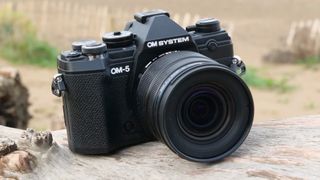
1. OM System OM-5
Our expert review:
Specifications
Reasons to buy, reasons to avoid.
✅ You want a robust travel camera: Light enough to travel with but tough enough to deal with bad weather, the OM-5 is a ruggedly dependable camera.
✅ You shoot handheld a lot: The OM-5 has excellent image stabilization for stills, meaning you can cross a tripod off your packing list.
❌ You want the best image quality: Its Micro Four Thirds sensor is decent enough, but some rivals offer more pixels and better low light performance.
❌ You have large hands: Handling is surprisingly good for a small camera, but the grip is not very deep, especially for those with bigger hands.
The OM-5 is only a relatively minor update of the Olympus OM-D E-M5 Mark III , but its combination of talents make it an ideal travel camera in our book – particularly if you want the flexibility of interchangeable lenses. It shoehorns a lot of features into a compact, weatherproof body that's compatible with a wealth of equally small lenses. Most of its skills, including excellent in-body image stabilization and computational photography modes, are also designed with travelers and adventurers in mind.
Our tests found that the OM-5 delivers excellent video and stills quality for its size, helped by a stabilization system (good for 6.5-stops of compensation) that gives you a high hit-rate of keepers. We also enjoyed the high-quality feel of the camera's dials, as well as in-camera software tricks, like Live ND and in-camera focus stacking, which are ideal for macro shots or blurring skies for an ethereal effect. Less good are the fairly average EVF resolution, 4K /30p limit for video and relative limitations of its smaller sensor, but these are all acceptable trade-offs considering this camera's size and price.
Read our in-depth OM System OM-5 review
- ^ Back to the top

2. Ricoh GR IIIx
✅ You go on city breaks: It's small and discreet for city photography, where its poor battery life and less than desirable build quality aren't so much of an issue.
✅ You want smartphone-beating picture quality: Being a niche camera is the GR IIIx's strength: its large sensor and sharp lens, together with gorgeous color profiles, make picture taking a joyful experience.
❌ You want a powerful zoom: The GR IIIx's lens is fixed, which means it's sharp but it can't zoom in on distant action and landmarks.
❌ You shoot video a lot: With a basic video spec of just FHD video and mono audio, the GR IIIx is a photography first camera way behind today's smartphones for video recording.
If you'd rather a truly pocketable camera with excellent image quality for city breaks over a rugged shooter for outdoorsy adventures, then the Ricoh GR IIIx is one of our top picks. It packs a larger APS-C sensor, the kind you get on much bigger cameras like DSLRs, and a fixed 40mm f/2.8 lens capable of pin sharp photos. It's a particularly popular camera with street photographers, and one of the few true compact cameras still being manufactured in 2024, thanks to some smartphone-beating features.
You get a handy macro photography mode, clever snap focus setting for preset focus distances, and some lovely color profiles and in-camera photo editing – you might just discover a love for black and white photography with the GR IIIx. The 40mm lens is a versatile focal length for every day photography offering a similar perspective to the portrait lens on your phone, while the Ricoh GR III alternative has a wider 28mm lens and a similar field of view to your smartphone's main camera.
The GR IIIx isn't perfect: there's no built-in flash, battery life is poor, the touchscreen is fixed and it won't stand up to rigorous treatment. However, you're making those compromizes to obtain what is the best image quality of any camera this small, and for city breaks its weaknesses aren't so much of an issue.
Read our in-depth Ricoh GR IIIx review
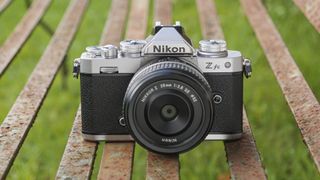
3. Nikon Z fc
✅ You care about camera design: From the retro dials to the circular viewfinder, the Nikon Z fc channels classic style to fantastic effect.
✅ You like manual exposure control: Dedicated dials for ISO, shutter speed and exposure, complemented by a lens control ring, give excellent manual control.
❌ You need a wide choice of lenses: There are only a handful of Z-series kit lenses designed for the APS-C format, limiting your options for expansion.
❌ You want a rugged camera: Although it looks like the sturdy FM2, the Z fc isn’t weather-sealed, so it’s not one to take on rainy adventures.
Travel photography is all about capturing memories and Nikon’s Z fc fully embraces the concept of nostalgia: it’s a stunning homage to the 30-year-old Nikon FM2 – complete with retro styling, dimensions and dials. Despite the throwback design, it’s a very modern camera inside, sharing many of its specs with the capable Nikon Z50. While some photographers might wish for a full-frame sensor, the Z fc’s APS-C number does a stellar job of capturing stills and 4K video, aided by reliable tracking autofocus. Our tests found that its 20.9MP sensor had an excellent handle on noise, especially under ISO 800, while dynamic range was impressive.
Its vari-angle touchscreen is also a brilliant addition, making it easy to frame travel selfies – or folding away completely for a leather-back look that lets you pretend it's the Eighties. The Nikon Z fc isn’t as sturdy as the camera that inspired it (there’s no weatherproofing, for example), but it’s still a beautifully unique camera for casual use. And with dedicated dials for ISO, shutter speed and exposure, plus a customizable lens ring, it’s also an easy one to control on the go.
Read our in-depth Nikon Z fc review

4. GoPro Hero 12 Black
✅ You want a rugged travel camera: Waterproof down to 10m, the GoPro Hero 12 Black is a great choice for capturing action-packed travels.
✅ You plan to share on social: The 8:7 aspect ratio of its sensor gives you lots of flexibility to crop footage for social, including vertical videos.
❌ You plan to shoot in low light: Its 1/1.9in sensor shoots sharp footage, but it still struggles with noise handling in lower lighting conditions.
❌ You want a hybrid for stills: While the sensor can shoot 27MP stills, you’ll get a better photography experience from a standard alternative.
If you're looking for a high resolution action camera for your travels that's as comfortable shooting smooth videos as it is crisp photos, then the GoPro Hero 12 Black tops the bill. It was an underwhelming update of the Hero 11 Black, but that's not necessarily a bad thing because that camera was already highly capable. There's the same 1/1.9in sensor with versatile 8:9 aspect ratio – you can reframe footage for different social channels without sacrificing quality, and its max resolution of 5.3K/60p beats the DJI Osmo Action 4. You can capture dramatic TimeWarps at the full 5.3K resolution, shoot photo sequences as a rapid 30fps, and pull 24.7MP stills from 5.3K video.
Design-wise, there's no change to the Hero 11 Black, the two rugged models are physically identical and come with a large Enduro battery as standard, giving more time between recharges on the road. The same interface lets you tweak the user experience, with ‘Easy’ and ‘Pro’ modes to suit your skill level. Superior Horizon Lock and HyperSmooth 5.0 smarts do a remarkable job of stabilizing handheld video. Minor updates from the Hero 11 Black are mainly for pros, including flat Log color profiles, 10-bit video, and multi-channel audio capabilities. For most people however, there's little reason to upgrade or to pick the Hero 12 Black over its predecessor which could save you a little money.
Read our in-depth hands-on GoPro Hero 12 Black review
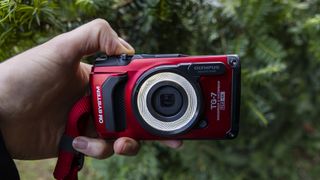
5. OM System Tough TG-7
✅ You want a hardcore camera: With a case that’s waterproof, shockproof and freezeproof, the OM System Tough TG-7 is built to take a beating.
✅ You like a simple interface: Premium features include RAW shooting and 4K video, but the camera itself is easy to operate, even in tricky conditions.
❌ You want the best image quality: Results from the 1/2.3in sensor are fine, but the TG-7 tends to overexpose, and detail is lost at the telephoto end.
❌ You like using a viewfinder: The Tough TG-7 doesn’t have a viewfinder, and the 3-inch LCD screen has limited visibility in bright sunlight.
Tough cameras like the TG-6 are freeze-proof, shockproof and waterproof and can therefore be used in scenarios that you simply wouldn't consider with your phone or expensive camera, and for that reason the TG-7 is still one of the best travel cameras you can buy. Its industrial design feels reassuringly rugged, while large buttons make it convenient to operate beneath the waves or while wearing gloves, plus its 3-inch LCD display offers decent visibility in most conditions.
We found image quality to be reasonable for a camera with a 1/2.3-inch sensor, with nice, rich colors – although there was a tendency to overexpose and blow out highlights. An equivalent zoom range of 25-100mm is fair, plus the inclusion of 4K video and raw shooting enhance flexibility. Its image quality might not match your phone for regular photos, but the TG-7 will allow you to be capturing extreme travel memories when you otherwise couldn't, plus there's a range of useful accessories such as a ring light for close up photography.
Read our in-depth OM System Tough TG-7 review
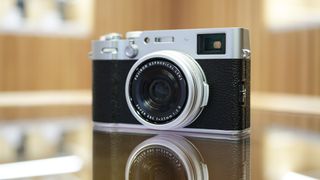
6. Fujifilm X100VI
✅ You're exploring the city: With a fixed 23mm f/2 lens, Fujifilm's best autofocus, tilt screen and hybrid viewfinder, the X100V is a fantastic choice for street photography.
✅ You want a premium camera: From its retro design to its metal body, the X100V feels well-made and looks the business.
❌ You don’t want a fixed focal length: The 23mm lens is fantastic, but some users will find it limiting, especially if you value the ability to zoom.
❌ You’re on a tight budget: The X100VI is a popular but niche premium camera, and its increased price will put it out of budget for many.
We'd class the Fujifilm X100VI as a niche premium compact camera, but the range is more popular than ever. The sixth-generation model keeps all that users have grown to love about the X100 series: sharp fixed lens, large sensor, retro design, and unique hybrid viewfinder. But it also builds on the X100V with a higher-resolution 40MP sensor and in-body image stabilization. The result is a significantly more versatile camera, for example the digital teleconverter can crop into the full image for 50mm (at 20MP) and 70mm (at 10MP) focal length looks, while stablization lets you shoot slower shutter speeds in low light.
Other key improvements over the X100V include more detailed 6K video and Fujifilm's best-ever autofocus that includes advanced subject detection for photo and video. You can rely on the X100VI as a discreet everyday camera to document the world around, especially your travels, and it comes with 20 film simulation color profiles inspired by actual Fujifilm 35mm film that you can customize with recipes to develop your own style.
Read our in-depth Fujifilm X100VI review
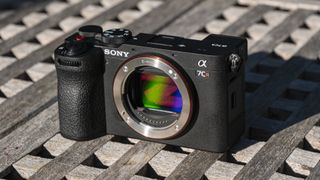
7. Sony A7C R
✅ You want the sharpest stills: With a 61MP full-frame sensor, you won’t get sharper travel snaps from any other camera in this list.
✅ You want a small, powerful camera: Despite the full-frame sensor inside, the A7C R is very compact and fits neatly in the hand.
❌ You value good handling: The small design has drawbacks, including a compromised viewfinder and absent AF joystick.
❌ You plan to use big lenses: Its compact proportions mean the Sony A7C R is mismatched with larger telephoto lenses.
By combining a small, travel-friendly form factor with a 61MP full frame sensor and fantastic autofocus, Sony has created arguably the ultimate travel camera. Successor to the Sony A7C – already one of our favorite travel photography tools – and announced alongside the A7C II , the A7C R fits nicely in the hand, while a flip screen and new dials offer welcome control.
Equipped with Sony’s top-grade autofocus and AI-powered subject tracking, the A7C R can cleverly and reliably track a broad range of subjects. You won’t find a better full frame sensor, either: borrowed from the A7R V , it captures stunning, pin-sharp stills in all conditions. Cropping potential is vast, and video footage is decent too.
There are trade-offs, though. In testing, we found that the A7C R’s compact proportions come with handling compromises, especially compared to the traditional design of the A7R V. The viewfinder feels small and fiddly, and we wish Sony had included an AF joystick. It’s also not a camera to pair with large telephoto lenses. But the real kicker is the cost: it’s significantly more expensive than the A7C II. That premium means it’s only a camera to consider if you need absolutely the best possible image quality on your travels.
Read our in-depth Sony A7C R review
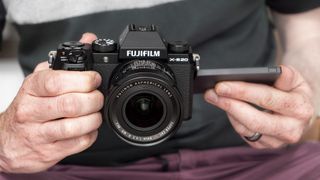
8. Fujifilm X-S20
✅ You value longevity: The X-S20 has double the battery life of the X-S10, making it a great choice for long days of travel photography.
✅ You shoot video, too: Capturing sharp 26MP stills and 6K/30p open gate video, the Fujifilm X-S20 is a true mirrorless hybrid.
❌ You need weather proofing: Build quality of the X-S20 is good, but you’re better off with the Sony A6700 if you need a weatherproof camera.
❌ You have a limited budget: Its additional features come at the cost of a steep price hike compared to the Fujifilm X-S10, which makes it a harder sell.
Channelling everything we liked about the X-S10 – including a compact, well-balanced body – the Fujifilm X-S20 cements its position as a fantastic mirrorless cameras for travel. It handles comfortably, with simplified dials making it accessible for beginners. In testing, we found new novice-friendly features – such as a dedicated Vlogging mode – also make the X-S20 a forgiving camera for touring first-timers.
The X-S20 is blessed with a proven shooting system, utilising the same 26.1MP sensor as the X-S10 and X-T4 to produce quality stills. It also eases the way for beginners with an automatic scene detection mode, which harnesses the power of Fuji’s latest X-Processor 5 to reliably choose the correct settings. From our first impressions, it works better than the automatic subject tracking, which was a little hit and miss.
With 6K/30p 4:2:2 10-bit internal video recording also on offer, plus in-body image stabilization that worked well in testing, the Fujifilm X-S20 is a solid option for content creators on the move. The lack of weather-sealing will discourage adventurous travellers, while the price tag means it isn’t one to leave in an unattended bag. But at just 26g heavier than its predecessor, the X-S20 is a very capable all-rounder for travel.
Read our in-depth Fujifilm X-S20 review

9. Sony A6700
✅ You want a capable travel hybrid: A sharp APS-C sensor, five-axis stabilization and AI autofocus make the A6700 a great all-rounder to take on the road.
✅ You like to get hands-on: A more ergonomic grip and lots of direct-access buttons make the A6700 a nice camera to handle and use.
❌ You shoot mostly video: The A6700 can record sharp video, but there’s a heavy 1.6x crop on 4K/120p slow-mo and Active SteadyShot stabilization isn’t the best.
❌ You like simple menus: The interface on the A6700 has quite a learning curve, and it can be tricky to navigate when shooting out and about.
It's a close-run thing between the Sony A6700 and the Fujifilm X-S20 above, but if you shoot a lot of moving subjects then the Sony should be your choice. Like the Fuji, it has a 26MP APS-C sensor and comes in a compact, travel-friendly form. And like the Fuji, it's a genuine hybrid, offering decent video options to go with its stills prowess. But there are some key differences.
First, the good: the A6700 has the same AI-powered chipset as the far more expensive Sony A7R V , and this helps it deliver incredible subject tracking; seriously, this camera will lock on to humans, animals, insects, cars, trains, aircraft and more, then follow them unerringly around the frame. However, its video chops aren't as impressive as those of the Fuji. 4K 120p slow-mo footage is subjected to a heavy 1.6x crop, while the five-axis stabilization doesn't work as well when filming as it does when shooting stills. The complex menu system also leaves something to be desired.
Still, it handles well, has a great battery and would make an excellent all-rounder for your next trip - so long as you're slightly more focused on images than video.
Read our in-depth Sony A6700 review
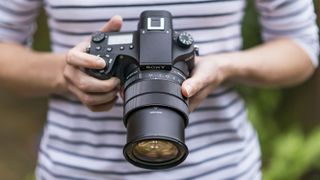
10. Sony Cyber-shot RX10 IV
✅ You like to zoom in: With a sharp, fast 24-600mm, the RX100 IV offers fantastic versatility to capture a range of subjects on your travels.
✅ You want an all-in-one option: The RX100 IV is a high-end bridge camera with a big zoom range, high-quality EVF and capable AF system.
❌ You want a small camera: While it ticks most of the boxes for travel photography, the RX100 IV is bigger and heavier than many rivals.
❌ You like a slick touchscreen: Its tilting touchscreen is a useful addition, but you can’t use it to navigate menus or swipe through images.
In terms of offering something for everybody, the RX10 IV ticks a lot of boxes. It's like having a bag full of lenses, but with the benefit of never having to change them. There's a very long zoom (going all the way from 24-600mm), while the maximum aperture is pretty wide throughout the lens.
The RX10 IV's sensor might not be as a large as the ones you'll find on a mirrorless camera or DSLR, but Sony's 20.1MP one-inch chip proved itself to be very capable in our tests. Noise was well-controlled, and you'd have no problem making an A3 print from one of its files (particularly if you shoot at under ISO 800).
You also get 24fps shooting, cracking 4K video quality and handling to rival a DSLR. The major downside? The high price – if your budget is tighter, don't forget about this camera's predecessor, the RX10 III .
Read our in-depth Sony Cyber-shot RX10 IV review
How to choose the best travel camera for you
Picking the right travel camera can be trickier than finding affordable flights. You’ll want a shooting tool that’s compact enough to conveniently carry on your travels, yet still capable of capturing sharp stills and stable video of your jet-setting adventures.
There are a few key things to keep in mind when choosing your ideal travel camera. Among the most important is size. While pocketable compacts offer convenience, the quality of your travel snaps will be boosted by the bigger sensors of larger mirrorless models.
If your adventures are likely to involve going off the beaten track, it’s worth considering a travel camera with rugged credentials. This could be one of the best action cameras , such as the GoPro Hero 11 Black – perfect if you plan to shoot quick, slick travel clips. Or it could be a sturdy compact such as the Olympic TG-6, which is one of the best waterproof cameras .
It’s also worth thinking about what subjects you might be shooting on your trip. A long zoom range will be handy on safari , while something light and fast is better for capturing street snaps on a city break. Travel compacts, such as the Panasonic Lumix ZS200 / TZ200, usually use a zoom lens to cover a range of shooting scenarios. Interchangeable lens cameras like the Fujifilm X-T30 II can similarly offer the flexibility of both worlds, but only if you’re happy to travel with extra barrels in your backpack.
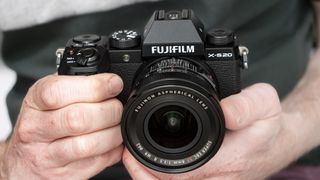
Which type of camera is best for traveling?
Travel cameras come in a range of shapes and sizes. Which style is best for you will depend on how you like to travel, what you like to shoot and how much gear you’re willing to cart around.
Travel zoom compacts such as the Panasonic Lumix ZS200 / TZ200 are pocket friendly, yet offer a broad scope for capturing a range of subjects. Thanks to generous zoom ranges, they give you the opportunity to get close to the action, or to shoot wide. The trade-off for having all of this flexibility in a compact body is generally a smaller sensor, which is less useful for shooting in low light.
If you’d like neat proportions but don’t need the versatility of a zoom lens, premium compact cameras could be worth considering. Models such as the Fujifilm X100V sacrifice zoom range in favour of larger sensors that are better at gathering light – usually a one-inch or, in the case of the X100V, an APS-C chip.
Between compacts and mirrorless cameras is where you’ll find bridge cameras. Bulkier than a standard compact, they offer more comfortable handling and a large zoom range, but without the need to carry different lenses. New bridge cameras are increasingly rare, but the Sony Cyber-shot RX10 IV remains a great example.
If you don’t mind traveling with multiple lenses, many of the best mirrorless cameras have been specifically designed with travel in mind. In the case of models like the OM System OM-5 , that means a portable, weatherproof body, useful image stabilization for shooting on the move, plus a versatile Micro Four Thirds sensor that balances size and performance. And with lots of different lenses to choose from, you can pack different optics depending on the type of trip you’re taking – or opt for a reliable all-round option.
Is a DSLR or mirrorless camera better for travel photography?
When it comes to travel photography, most photographers look for a balance between portability and performance. If this is the combination you’re after, mirrorless cameras will almost aways have the edge over their DSLR rivals. Mirrorless models are generally smaller and lighter than DSLRs, making them easier to wield and travel with.
Despite their more compact proportions, many of the best mirrorless travel cameras can also match or outclass DSLR cameras when it comes to image quality, as well as autofocus abilities and video features. This makes them versatile tools for shooting on the move, especially if you choose a model with in-body image stabilization for sharp handheld results. If you pick a mirrorless camera with an established lens mount system, you’ll also find no shortage of glass to pack for your trip.
That said, there are reasons why you might still want to consider a DSLR camera for travel. Some photographers prefer the chunkier ergonomic grip for which the DSLR format is famous, especially if they plan on shooting for hours on end. The best DSLR cameras also offer superlative battery life, which can be useful if your travel plans include days away from electricity.
Budget might also be a factor, especially if you’re concerned about taking an expensive camera on your travels. Older DSLR cameras can offer great value, as can second-hand mirrorless models. It’s also worth looking at our round-up of the best cheap cameras , which includes some options that are a good fit for travel photography.
- Read our in-depth DSLR vs Mirrorless comparison
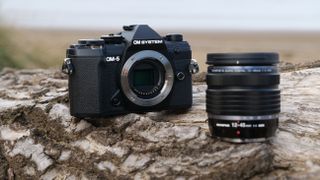
How we test travel cameras
Buying a camera these days is a big investment, and travel cameras are no different – so every camera in this guide has been tested extensively by us. For travel cameras in particular, real-world tests are the most revealing way to understand a camera's performance and character, so we focus heavily on those, along with standardized tests for factors like ISO performance.
To start with, we look at the camera's design, handling and controls to get a sense of how suitable it is for life on the road, and any particular features that might be particularly useful for globe-trotters. When we take it out on a shoot, we'll use it both handheld and on a tripod to get a sense of where its strengths lie, and test its startup speed.
When it comes to performance, we use a formatted SD card and shoot in both raw and JPEG (if available). For burst shooting tests, we dial in our regular test settings (1/250 sec, ISO 200, continuous AF) and shoot a series of frames in front of a stopwatch to see if it lives up to its claimed speeds. We'll also look at how quickly the buffers clears and repeat the test for both raw and JPEG files.

In various lighting conditions, we also test the camera's different autofocus modes (including Face and Eye AF) in single point, area and continuous modes. We also shoot a range of photos of different styles (portrait, landscape, low light, macro/close-up) in raw and JPEG to get a sense of metering and its sensor's ability to handle noise and resolve fine detail.
If the camera's raw files are supported by Adobe Camera Raw, we'll also process some test images to see how we can push areas like shadow recovery. And we'll also test its ISO performance across the whole range to get a sense of the levels we'd be happy to push the camera to.
Battery life is tested in a real-world fashion, as we use the camera over the course of the day with the screen set to the default settings. Once the battery has reached zero, we'll then count the number of shots to see how it compares to the camera's CIPA rating. Finally, we test the camera's video skills by shooting some test footage at different frame-rates and resolutions, along with its companion app.
We then take everything we've learned about the camera and factor in its price to get a sense of the value-for-money it offers, before reaching our final verdict.
Get daily insight, inspiration and deals in your inbox
Sign up for breaking news, reviews, opinion, top tech deals, and more.
Tim is the Cameras editor at TechRadar. He has enjoyed more than 15 years in the photo video industry with most of those in the world of tech journalism. During his time as Deputy Technical Editor with Amateur Photographer, as a freelancer and consequently editor at Tech Radar, Tim has developed a deeply technical knowledge and practical experience with cameras, educating others through news, reviews and features. He’s also worked in video production for Studio 44 with clients including Canon, and volunteers his spare time to consult a non-profit, diverse stories team based in Nairobi. Tim is curious, a keen creative, avid footballer and runner, and moderate flat white drinker who has lived in Kenya and believes we have much to enjoy and learn from each other.
- Mark Wilson Senior news editor
- Chris Rowlands
Nikon’s first f/1.4 lens for Z-mount is the classic that street photographers have been waiting for, and it’s surprisingly affordable
Canon EOS R1 and EOS R5 Mark II finally get rumored launch date – here's what to expect
Can data centers keep up with AI demands?
Most Popular
- 2 Virgin River season 6 on Netflix: everything we know so far
- 3 Report: Samsung's next Galaxy Buds might be the most useful model yet
- 4 Amazon announces the dates for Prime Day 2024 – and early deals start now
- 5 LockBit hackers claim to have cracked the US Federal Reserve
- 2 Ahead of GPT-5 launch, another test shows that people cannot distinguish ChatGPT from a human in a conversation test — is it a watershed moment for AI?
- 3 You can't escape it now — Gemini is officially part of Gmail, Google Drive, Docs, Sheets, and Slides
- 4 Discover the ultimate power-up for your iPhone
- Reviews TV REVIEWS v1.11 HEADPHONES REVIEWS v1.7 MONITOR REVIEWS v2.0 SOUNDBAR REVIEWS v1.3 MOUSE REVIEWS v1.5 KEYBOARD REVIEWS v1.3.1 PRINTER REVIEWS v1.2 VACUUM REVIEWS v1.3 PROJECTOR REVIEWS v0.9 TOASTER REVIEWS v1.0 BLENDER REVIEWS v1.0 AIR PURIFIER REVIEWS v1.0 KEYBOARD SWITCH REVIEWS v1.0 SPEAKER REVIEWS v0.8 CAMERA REVIEWS v0.12.1 LAPTOP REVIEWS v0.8.2
- 72 In Progress
- Newsletters
- Compact Travel
- Table of Contents
- Best Camera
- Best Mid-Range
- Best Budget
- Best Vlogging
- Best Large Sensor
Notable Mentions
Recent updates, all reviews, the 5 best compact cameras for travel - summer 2024 reviews.

Point-and-shoot cameras are a natural choice for travel thanks to their compact sizes and built-in zoom lenses, making it a breeze to capture all your memories abroad without having to lug around a bulky kit with multiple lenses. While smartphone cameras have continued to improve, and they're usually the camera you've already got on you, some point-and-shoots offer improved image quality with larger sensors than the ones typically found in phones, while others offer longer zoom ranges that you simply can't get with the physically limited lenses on your smartphone.
We've bought and tested over 100 cameras in our lab, and below, you'll find the best point-and-shoot cameras for travel that we recommend. If you don't mind carrying a larger kit with interchangeable lenses, check out our picks for the best mirrorless cameras for travel . If you want to capture beautiful images of destination vistas, you might also want to check out our best cameras for landscape photography . Alternatively, if you're less interested in snapping places and more interested in the people that populate them, see our picks for the best street photography cameras .
Best Compact Camera For Travel

It ain't cheap, but the Sony RX100 VII is the best compact travel camera we've tested. Sony has perfected the formula for compact zoom cameras with its RX100 series. This latest model features a stacked 1-inch sensor that delivers blazing-fast burst rates and great image quality for its class, along with a pop-up viewfinder and flash, a large tilting screen, and a zoom lens—all packed into an incredibly portable camera.
While it doesn't have the widest zoom range on this list, its 24–200mm full-frame equivalent focal length still gives you a fair amount of range, offering some flexibility for framing and composition. The camera also has a highly effective autofocus system, ensuring your subjects stay in focus, even in busier settings. That said, like most compact cameras, it has a pretty short battery life, though you can always pack a spare battery or portable power bank to charge it on the go.
See our review
Best Mid-Range Compact Camera For Travel

If you want to save money, the Canon PowerShot G7 X Mark III is a great mid-range option. Like other Canon cameras, its user interface is highly intuitive. It has a comfortable finger grip and thumb rest, and the tilt-out screen can flip up for selfies or vlogs. Plus, it features a 1-inch stacked sensor and quick 16 fps burst shooting.
The built-in lens has a fairly versatile 24–100mm equivalent focal length, which is a shorter zoom range than the Sony RX100 VII but still wide enough to give you some flexibility with framing. That said, its autofocus system isn't quite as reliable. Otherwise, this camera has plenty to offer for travelers who want something compact and comfortable to shoot with.
Best Budget Compact Camera For Travel

The Canon PowerShot SX740 is one of the best point-and-shoot cameras to get if you're on a tighter budget. It uses a smaller sensor than the more premium options above, so there's a slight trade-off in image quality. On the upside, its built-in lens has a 40x optical zoom range, giving you a remarkably wide focal length range of 24–960mm. Though it doesn't have a viewfinder, the camera's tilt screen can flip up for selfies or waist-level shots, and it's incredibly portable.
Of course, the most cost-effective choice if your budget is really tight is to simply use your smartphone! Most smartphone cameras these days feature pretty impressive processing to compensate for their smaller sensors, which means you can still get great results despite some hardware limitations. The best part is that you've likely already got a smartphone on you, so it won't cost you anything extra or take up more space in your luggage. Still, if you want the shooting experience of a dedicated point-and-shoot camera, the PowerShot SX740 has quite a bit of value for its price.
Best Compact Vlogging Camera For Travel

While the previous picks are more photography-oriented, travel vloggers should take note of the Sony ZV-1, the best point-and-shoot camera for travel vlogging. Though it doesn't have a viewfinder, it's the only option on this list to feature a fully articulated screen, making it easy to monitor yourself while recording or to take the odd selfie. On top of that, it has vlogging-specific features like a detachable windscreen to reduce ambient noise when recording outside.
The Sony ZV-1 II has since replaced it and features a wider-angle lens that's a good fit for walk-and-talk vlogs. However, the newer model doesn't have optical stabilization, and its digital stabilization feature crops in some of that wider field of view. For those reasons, the original ZV-1 is still our top pick here, especially since you can get it for cheaper. It checks all the boxes for a compact, all-in-one travel vlogging camera.
Best Large Sensor Compact Camera For Travel

The RICOH GR III is a fantastic option if image quality is your top priority. While you'll still get great images from 1-inch sensor cameras like the Sony RX100 VII or the Canon PowerShot G7 X Mark III , the RICOH boasts a larger APS-C sensor that delivers excellent image quality and better noise handling in low light. Its sleek, minimalist design makes it the most pocketable camera on this list, too, so you can bring it with you wherever your travels take you.
Of course, this isn't the travel camera for everyone. If you want the flexibility to zoom in on farther subjects or you like to shoot video on the side, you're out of luck here since the camera has a fixed 28mm equivalent focal length and has poor video capabilities. If 28mm is too wide for you, you can opt for the RICOH GR IIIx instead, which has a 40mm equivalent lens. Both of these also come in HDF variants, with a 'Highlight Diffusion Filter' in place of an ND filter for softer highlights. Whichever model you go for, the GR III is one of the best options if you want something super portable that doesn't compromise on image quality.
- Fujifilm X100V: The Fujifilm X100V is a beautifully designed point-and-shoot with an APS-C sensor. Unlike the RICOH GR III, it has a hybrid optical/electronic viewfinder and a tilting screen, making it more versatile. However, it isn't as compact as other options here, and the manufacturer has since replaced it with the in-demand Fujifilm X100VI. See our review
- Panasonic LUMIX ZS80: The Panasonic LUMIX ZS80 is one of the best budget options you can get, offering a ton of value for its price, and unlike the Canon PowerShot SX740, it even has a viewfinder. However, it's been discontinued and is harder to find. See our review
Jun 04, 2024: We replaced the Canon PowerShot G5 X Mark II with the Canon PowerShot G7 X Mark III as the mid-range pick because it has better availability. We also added mention of the HDF variant of the RICOH GR III.
Apr 10, 2024: We brushed up some of the text throughout the article for clarity and added a mention of the Fujifilm X100VI to ensure the article is up to date with the current market.
Mar 14, 2024: We've reviewed the article to ensure the text and recommendations are up to date.
Feb 14, 2024: Moved the Panasonic LUMIX ZS80 to the Notable Mentions because it's been discontinued and is hard to find in stock, and replaced it with the Canon PowerShot SX740 as the main budget pick.
Dec 18, 2023: Reviewed accuracy of picks with no change to recommendations.
Our recommendations above are what we think are currently the best compact cameras for most people to buy for travel, according to their needs. We factor in the price, feedback from our visitors, and availability (no cameras that are difficult to find or almost out of stock in the U.S.).
If you would like to choose for yourself, here's the list of all our compact fixed-lens camera reviews. Be careful not to get caught up in the details. There is no single perfect camera. Personal taste, preference, and shooting habits will matter more in your selection.
Ewan McGregor wouldn’t shave off any years. That mustache? Another story.

- Copy Link URL Copied!

Ewan McGregor is swiping through his camera roll, looking for the picture that explains why he will never grow another mustache — unless a job requires it. And even then, he’d probably argue that the character should be clean-shaven. Dalí without a mustache? Surreal.
Before our conversation, I had resolved not to ask McGregor anything about facial hair. It seems that most of the interviews he’s done to promote his terrific Paramount+ With Showtime limited series “A Gentleman in Moscow” have spent an inordinate amount of time focusing on the mustache he grew to play Count Alexander Ilyich Rostov, a Russian nobleman sentenced to house arrest in a luxurious hotel following the 1917 revolution. Over four decades (and eight episodes), the good gentleman learns to let go of formalities and appreciate simple pleasures and embrace family.

But he never shaves off that damn mustache.

A model of restraint, ‘A Gentleman in Moscow’ is unlike anything else on television
Ewan McGregor stars as a Russian nobleman under house arrest after the 1917 revolution in the Paramount+ with Showtime adaptation of Amor Towles’ novel.
March 27, 2024
McGregor keeps scrolling. He’s in Atlanta, shooting “Flowervale Street,” a movie so secret that when he mentions its name, he immediately panics. “Oh, no. I’m worried that I just blew the title.” When I tell him it’s out there, he’s relieved. He wrapped shooting at 6:30 this morning, and here he is with me on Zoom, 4½ hours later. “I’m somewhat upside down, but it’s all good,” he says.
And he’s not that out of it, because when I tell him all I know about “Flowervale Street” is that David Robert Mitchell (“It Follows,” “Under the Silver Lake”) wrote and directed it, and it’s a mystery, and it might be set in the 1980s, and it might have dinosaurs, he says, smiling:
“Well, I’m not at liberty to discuss that in any way, so it could be in the ’70s with, you know, rodents. But it’s great fun.”
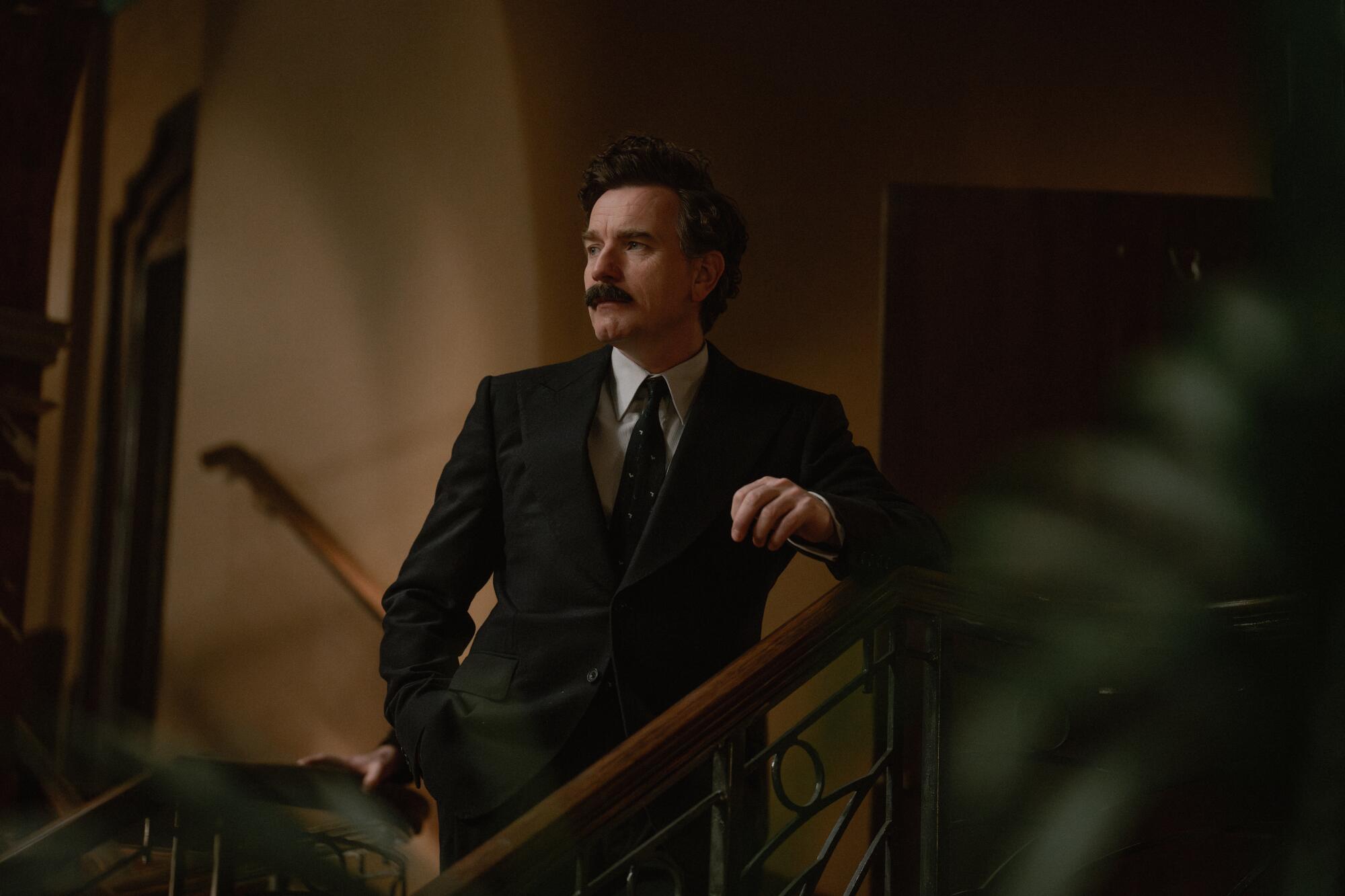
He finds the photo. He’s with his son, Laurie, who was just shy of 3 when it was taken. McGregor’s hair is light brown. His mustache is blond. He grimaces, saying, “There’s something about my blondie mustache that doesn’t look good on my face.” The picture was taken last year during the actors’ strike, which interrupted the filming of “A Gentleman in Moscow” with eight days remaining on the schedule. During the break, McGregor kept the mustache, grew a beard and waited. When shooting resumed in January, he finished his scenes and shaved it all off five minutes after production wrapped.
“There’s me in the makeup chair,” McGregor says with glee, finding another shot in his camera roll.
The experience of making this show is why I wanted to be an actor.
— Ewan McGregor on ‘A Gentleman in Moscow’
“I’m getting the feeling you’re never growing a mustache—”
“... again,” he interrupts, finishing my sentence. “Once it goes white, maybe. Then I think it might look good. Like, for instance, you’d look great with a mustache.” Which is funny because the last time I grew a beard, my kids, then little, called me Obi-Wan.
“There are worse things they could call you, believe me,” McGregor says, laughing.
McGregor played Obi-Wan Kenobi in the three “Star Wars” prequels and returned to the role for the 2022 Disney+ limited series. Shortly before we spoke, he surprised fans attending a 25th-anniversary showing of “The Phantom Menace” at the Atlanta Film Festival. He likes doing these kinds of drop-ins. A few years ago, he showed up at the El Capitan in Hollywood at 2 in the morning between films in a “Star Wars” marathon.
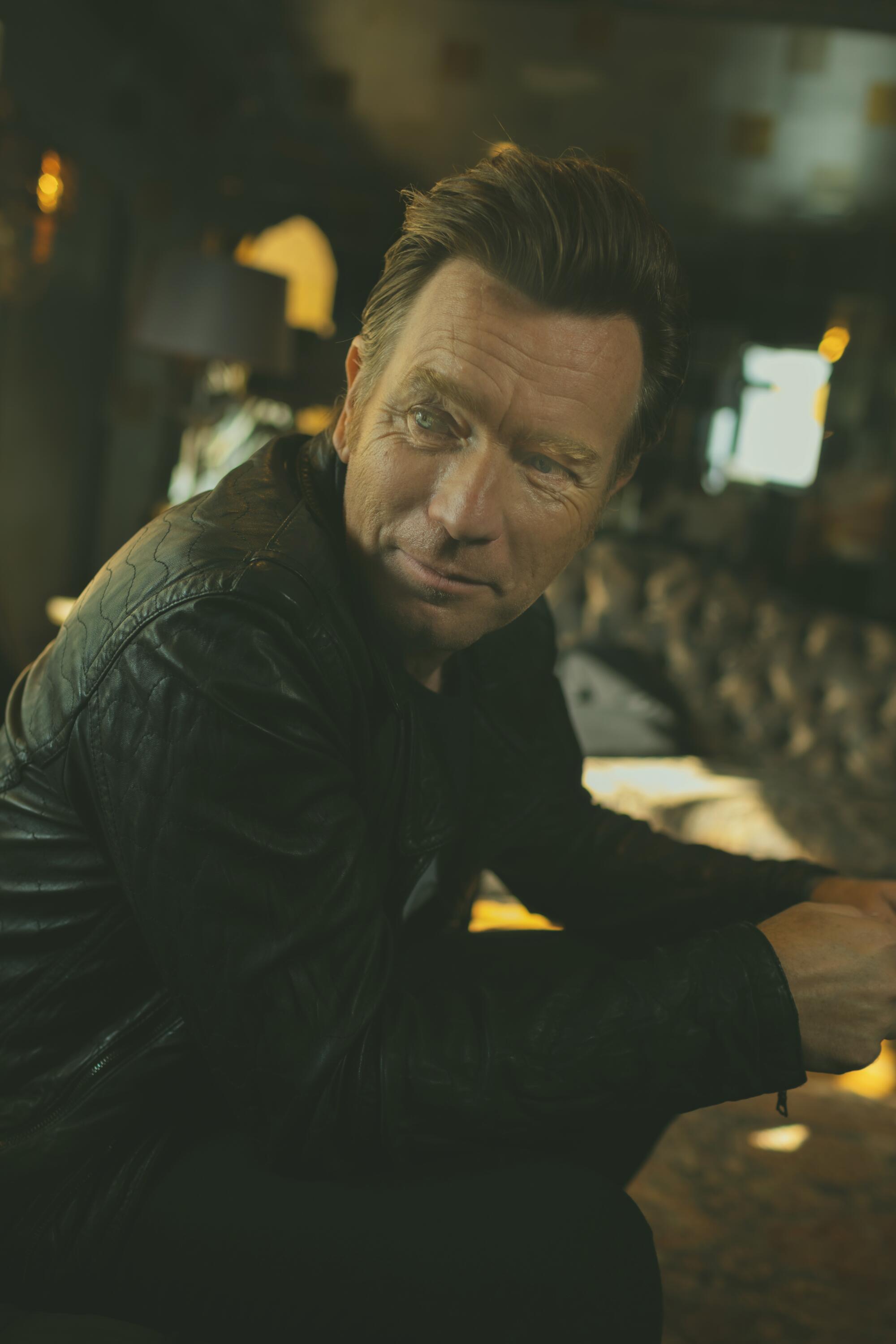
“They’re all in sleeping bags and blankets,” McGregor says. “It’s a good laugh. And it’s good for the ego when they give you a big cheer when they weren’t expecting you.”
Critics mostly hated “The Phantom Menace” when it was released, but the George Lucas-directed movie has been reassessed as the years have passed.
“We made the film for kids, but we didn’t hear from them then because they were kids and there was no Instagram, no social media. They didn’t have a voice like they do now,” McGregor says. “All we had was the critics and the noise of the people who didn’t like it. But those kids have grown up, and those movies are now their ‘Star Wars’ trilogy. It’s nice for me, that. Because at the time, the reaction was rough.”
We get to talking about the idea, explored in “A Gentleman in Moscow,” that less is more and the contentment that comes from casting aside what no longer serves us.
“You realize what things are not you,” McGregor says. “I’m 53. But I’ve got lots of friends who are about to be 60. And I keep noticing, watching shows on television, young people referencing 60 like it’s really old!” He stops, laughing. “You’re like, ‘Wait a minute.’ But it’s also learning about who you are, isn’t it? And you let go of the things that you don’t need.”

The funny thing about McGregor, though, is that he’s someone who picks up hobbies quickly, becomes obsessed with them and then moves on to the next thing, never quite letting them go. He can ride a unicycle. He can play the guitar. He can blow a few tunes on the bagpipes. There’s always something going on. It used to be that he’d beat himself up over knowing how to do a lot of things moderately well as opposed to mastering a single talent. Now he just accepts that’s how he is. He can go out to his shed, look at the unicycle he hasn’t used for three years and know that someday he’ll give it another go.
“What about the bagpipes?” I ask. “Are they in the corner somewhere, gathering dust?”
“They are at the moment,” McGregor says. “But they will get blown again.”
It turns out McGregor is even more interested in talking about the bagpipes than about his “Moscow” mustache. It wasn’t that long ago, in fact, that he broke out his bagpipes. This last year, he was in his native Scotland for Hogmanay , the country’s new year celebration. He was out with his brother, who repeatedly called out for songs that McGregor didn’t know. “C’mon, shut up. I don’t know that one,” McGregor kept telling him.
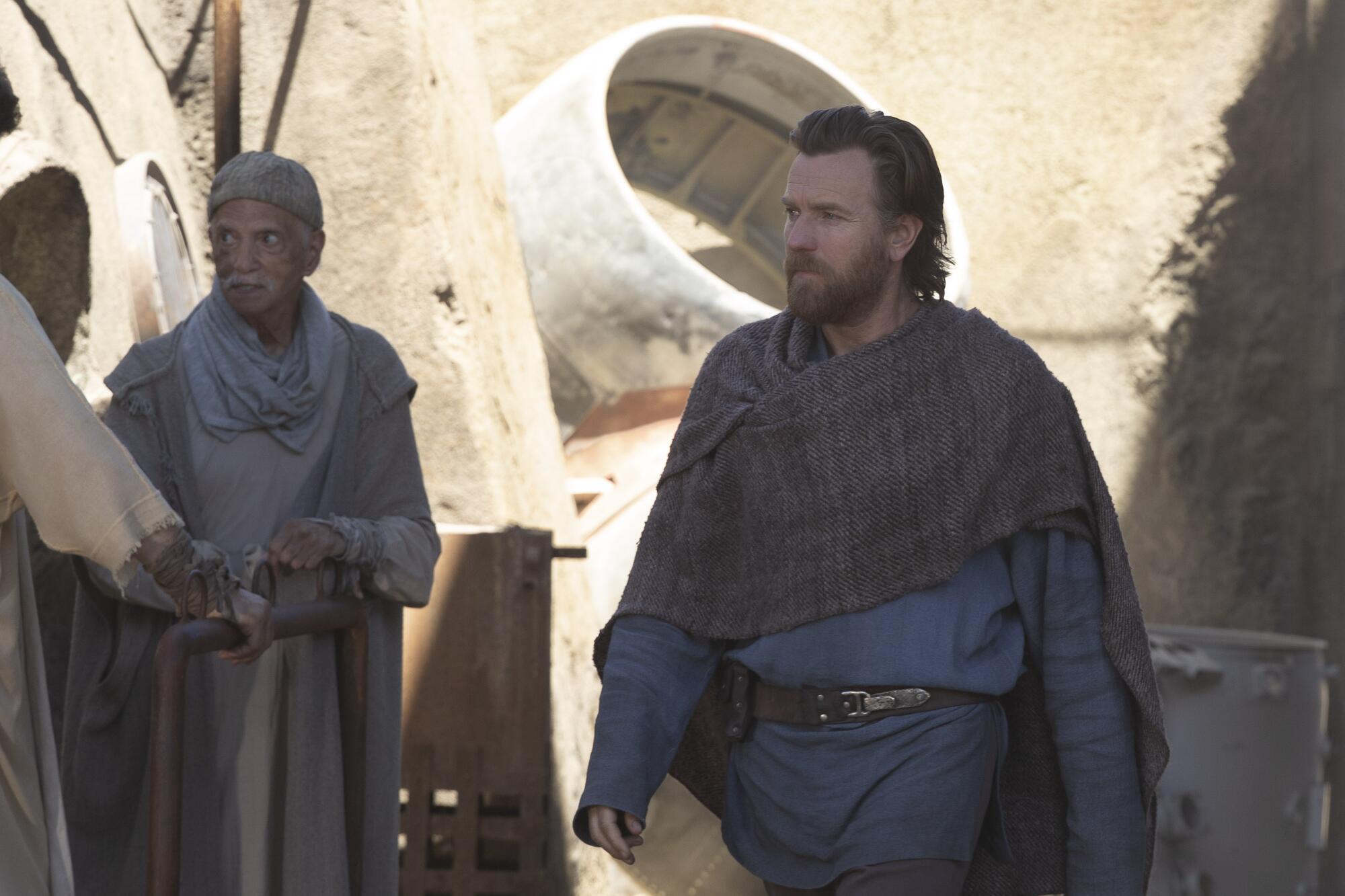
When he was a kid, McGregor was a drummer in a pipe band. He never thought he’d be a piper because as a drummer, that would be, in his words, “going over to the dark side.” But when he was shooting the 2011 film “Salmon Fishing in the Yemen” in the Scottish Highlands, he met a piper and, inspired by being home, bought some bagpipes and found a teacher in London. He took the pipes with him to the set of his next film — he won’t name it, but it was a “miserable” experience (“f— slow, like I was under house arrest”) — and asked the transport guy to put his trailer next to the generator.
“I’m the first actor in history to ask that, because usually you want to be as far away from the generator as possible because it’s so noisy,” McGregor says. “But it was perfect because I could blow my bagpipes for hours on end and no one could hear it because I was next to the drone of the generator.”

Hearing these stories, it’s easy to see why McGregor loved “A Gentleman in Moscow,” a series that asked him to learn how to do a number of different things — age a character over decades, play a father and a lover, explore the inner life of a man well versed in grief and loss who never loses his zest for living.
“The experience of making this show is why I wanted to be an actor,” McGregor says. “It’s such a beautiful piece; it leaves you thinking, ‘God, I hope there’s another one out there somewhere in the future.’ But who knows?”

“He’s so charming, but I resist using that word because it’s reductive,” says “Moscow” showrunner Ben Vanstone. “There’s so much thought and skill that goes into his performance, all of his performances, really.”
Vanstone says McGregor’s count ages 31 years in the series, not including what we see of the character in childhood flashbacks. But because the character’s mental burdens grow lighter over time, McGregor believes he becomes more relaxed and, in many ways, younger. He learns to live.
Circling back to what he said earlier about young people calling his friends almost ancient at 60, I ask McGregor how old he feels these days.
“I feel 53. I feel exactly where I am,” he replies. “I don’t want to be 35. I want to feel the age that I am.”
Is that because, I ask — adding that I’ve known him for so long now, almost an entire hour, so I can presume some insight — he wouldn’t trade the wisdom and experiences he’s accumulated to shave off a few years?
“No, I wouldn’t,” McGregor says. “I’m not afraid of aging. I’m not afraid of getting older. I’m not afraid of dying. I’m just so happy. I’m a lucky, lucky man.”
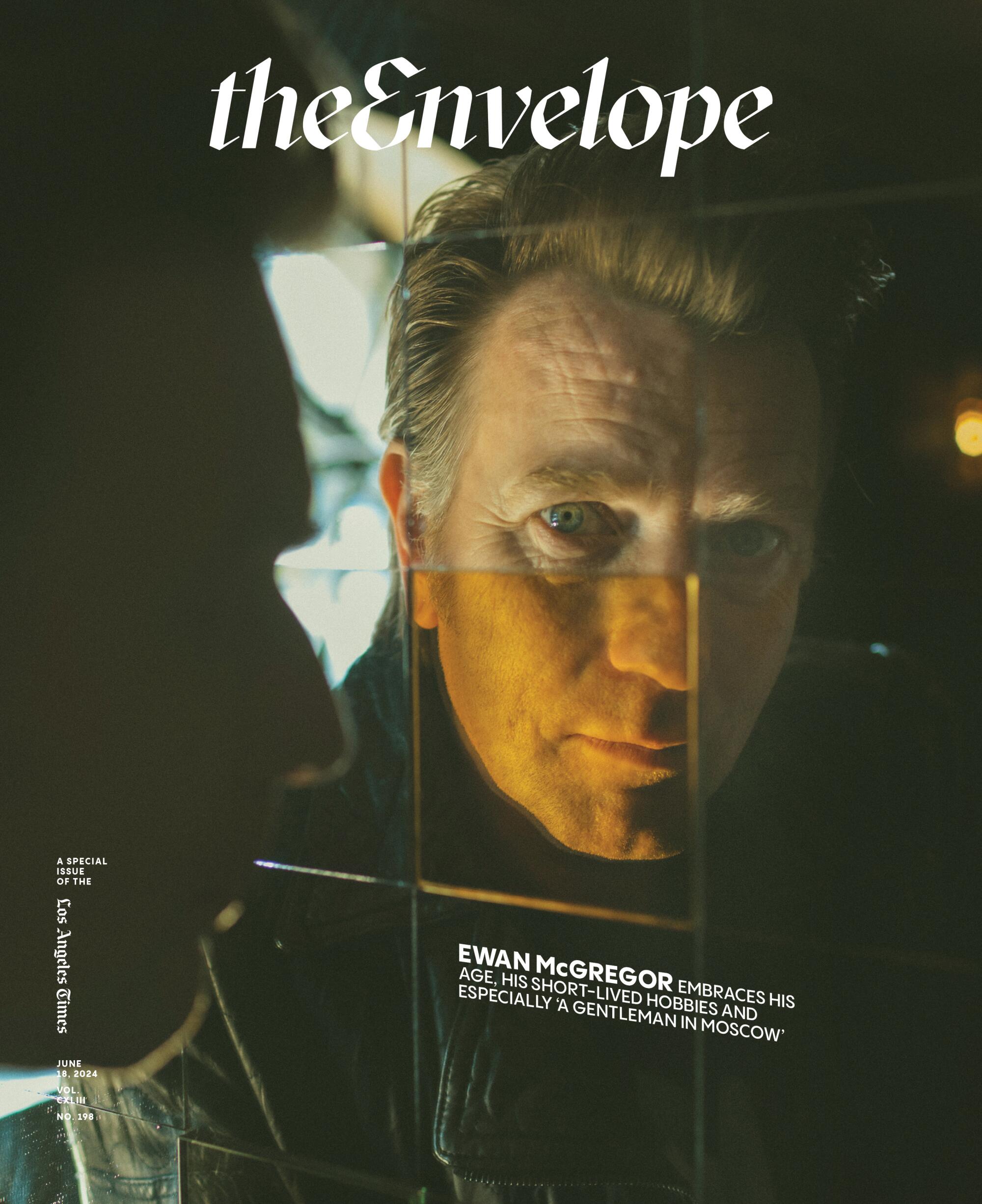
More to Read

Peacocking through the centuries: How menswear in this season’s series gets the sartorial showcase
June 18, 2024
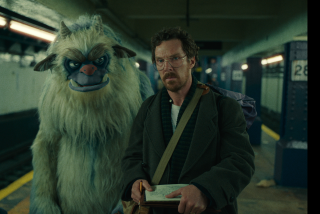
In ‘Eric,’ Benedict Cumberbatch is a dad angry at everyone as he searches for his missing son
May 29, 2024

In ‘The Gentlemen,’ Theo James stands in for ‘the dying power of British aristocracy’
May 28, 2024
From the Oscars to the Emmys.
Get the Envelope newsletter for exclusive awards season coverage, behind-the-scenes stories from the Envelope podcast and columnist Glenn Whipp’s must-read analysis.
You may occasionally receive promotional content from the Los Angeles Times.

Glenn Whipp covers film and television for the Los Angeles Times and serves as columnist for The Envelope, The Times’ awards season publication.
More From the Los Angeles Times

20 years ago at the Emmys: An effusive Elaine Stritch has the time of her life
June 20, 2024

Naomi Watts on why her acting career ‘went quiet’: It’s ‘not for lack of trying’

20 years ago at the Emmys: Drea de Matteo was dying for an award
June 19, 2024

20 years ago at the Emmys: David Hyde Pierce keeps his streak alive

IMAGES
COMMENTS
The Z50 is a mirrorless camera, meaning it's compact in size and more lightweight than most DSLR brothers. For a travel camera particularly, the small size and weight is definitely something you will appreciate, having to carry it with you on tours and hikes. However much I love my Nikon D3 DSLR, after a while, it feels like I'm carrying a ...
Nikon Travel Kit Charcoal. Be the first to write a review. Product 17100. $59.95. OUT OF STOCK. Features. Full Details; Where To Buy. Local; Online; Find it Locally ... Nikon Camera Apps; Software & Firmware Updates; Manuals; Nikon Image Space; Download Adobe Reader; Shopping Help. Order Status; Shopping FAQ; Returns; Financing;
For me, my DSLR travel kit recently has been the D7500, the 16-80mm f/2.8-4E lens, and the 70-300mm f/4-5.6 AF-P VR (FX) lens. This actually gives me more reach than most of the mirrorless kits I described, but it comes with a size/weight penalty: we're easily double the weight at 2kg (4.4 pounds). Which brings me to an aside.
Nikon Travel Kit Coral. $59.95. Overview. Ratings & Reviews. Compatible With. Buy Now. *Hand strap should only be used with camera and lens combinations weighing up to 28.6 ounces. LCD, Video and Photo Gallery images are for illustrative purposes only.
Shop the latest mirrorless & DSLR cameras and NIKKOR lenses from the official Nikon eCommerce site. Explore our innovations and photo equipment! Skip to Main Content Additional Site ... Nikon Travel Kit Coral. $59.95. Menu. Overview. Ratings & Reviews. Compatible With. Product Forum. Support. Previous Next. Nikon Travel Kit Coral. Product 17102 ...
The Nikon Travel Kit is a small but roomy camera bag ideal for a Nikon Z camera and lense(s) or DSLR and lens. The Travel Kit comes in four fun color options and each includes a hand strap and a multi-use neck/shoulder strap that can be used to carry either the camera or the bag itself.
The Nikon Travel Kit (Lemon) is a stylish carrying case, designed to transport your Nikon Z-Series Mirrorless Camera, or DSLR camera, in a secure & comfortable camera bag. This small, yet roomy, camera bag fits a Nikon Z camera, & lens(es), or a DSLR camera & lens. The Nikon Travel Kit comes in four different styles ...
The system is very beginner friendly but still offers enough "professional" options that it can, and likely will, remain in a content-creators arsenal even after they upgrade to one of Nikon ...
Best pocketable travel camera: Ricoh GR III; The classic choice: Fujifilm X100VI; Truly compact mirrorless: OM System OM-5; All-round compact capability: Sony a6700; The great travel kit: Fujifilm X-S20 with 18-55mm F2.8-4.0 OIS; The stylish travel companion: Nikon Zf; Portable full-frame: Sony a7CR
14-30mm f/4 S (or 17-28mm f/2.8) and 28-75mm f/2.8. This is the two-lens set that most satisfies the common travel needs (e.g. city-based travel), though it comes up somewhat short on the telephoto end. In two good lenses you have the 14-75mm range well covered, and with reasonable aperture speed that should help you deal with low light.
The best hard Nikon camera case: Keep your Nikon camera kit safe from harm, ... The best cheap cameras; The best tripods for travel; Round up of today's best deals. Lowepro ProTactic 450 AW. $370.95. View. See all prices. Peak Design Everyday Messenger 13 V2. $229.95. View. See all prices.
The Z 50 Creator's Kit is built around the small but mighty Nikon Z 50 mirrorless camera and compact NIKKOR Z DX 16-50mm f/3.5-6.3 VR lens. A RØDE VideoMicro mic, Joby GorillaPod 3K kit, SmallRig Vlogging Mounting Plate and Charcoal Nikon Travel Kit Bag with hand and shoulder straps will give you all the tools needed to create your next ...
Overall Best Travel Lens for Nikon DX - Sigma 18-300mm F3.5-6.3 DC Macro OS HSM. Best DX Budget Travel Lens for Nikon DX - Sigma 17-50mm f/2.8 EX DC OS HSM FLD. Best DX Professional Travel Lens for Nikon DX - Sigma Art 18-35mm f/1.8. Best EF-S Prime Travel Lens for Nikon DX - Nikon AF-S DX NIKKOR 35mm f/1.8G.
Nikon - Z 6 II 24.5 MP 4k Video Mirrorless Hybrid Camera with Nikon NIKKOR Z 24-120mm f/4 S Lens (1659) + 4K Monitor + Rode VideoMic + 2 x 64GB Memory Card + Filter Kit + Pro Tripod + Bag + More. $3,02495. FREE delivery May 28 - 31. Or fastest delivery Tomorrow, May 23. Only 9 left in stock - order soon.
The Nikon Travel Kit is a small, but roomy camera bag. The Travel Kit comes in four fun color options and each includes a hand strap and a multi-use neck/shoulder strap that can be used to carry either the camera or the bag itself. Customer reviews. 5 star (0%) 0% 4 star ...
Action Video. 5.9. Body Type SLR-Style. Mirrorless Yes. Sensor Size 4/3 (MFT) See all our test results. The OM SYSTEM OM-5 is one of the best travel cameras you can get. As part of the Micro Four Thirds (MFT) system, it offers a good combination of portability, ruggedness, and image quality.
Combining a small form factor with a high-res 61MP sensor and fantastic autofocus, the Sony A7C R is the best full-frame camera for travel photography. 8. Fujifilm X-S20. A capable sensor and ...
Action Video. 5.2. Body Type Point and Shoot. Mirrorless Yes. Sensor Size 1-inch. See all our test results. It ain't cheap, but the Sony RX100 VII is the best compact travel camera we've tested. Sony has perfected the formula for compact zoom cameras with its RX100 series.
Nikon Travel Kit Lemon. $59.95. Be the first to write a review. Overview. Ratings & Reviews. Compatible With. Product Forum. Support. *Hand strap should only be used with camera and lens combinations weighing up to 28.6 ounces.
Shop the latest mirrorless & DSLR cameras and NIKKOR lenses from the official Nikon eCommerce site. Explore our innovations and photo equipment!
'A Gentleman in Moscow' asked the actor to age decades, play a father and a lover, and explore the inner life of a man well versed in grief and loss who never loses his zest for life. 'The ...
Cameras Mirrorless DSLR Point & Shoot View All Cameras. Lenses. ... Nikon Travel Kit Sky. Menu. Overview. Compatible With. Support. i This product has been archived. Product Support. Support. Product Registration. Registering your Nikon product allows us to send you (with your permission) important updates, service information and helpful hints